Paul van Yperen's Blog, page 12
June 10, 2025
Directed by Pier Paolo Pasolini
Pier Paolo Pasolini (1922-1975) was an Italian director, poet, and writer. A published poet at 19, he had already written numerous novels and essays before his first screenplay in 1954. He is best known for directing Il Vangelo secondo Matteo / The Gospel according to Matthew (1964), the Trilogy of Life - Il Decameron / The Decameron (1971), I Racconti di Canterbury / The Canterbury Tales (1972) and Il Fiore delle Mille e Una Notte / Arabian Nights (1974) - and the controversial Salò o le 120 giornate di Sodoma / Salò or the 120 days of Sodom (1975).

French postcard by Editions La Malibran, Paris / Saint -Dié, no. MC 12. Pier Paolo Pasolini in Il Decameron / The Decameron (Pier Paolo Pasolini, 1971).
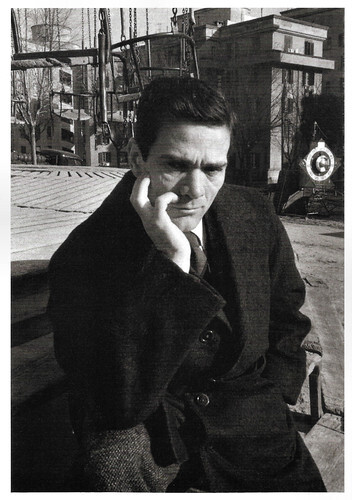
Swiss postcard by Musée de l'Élysée, Lausanne / News Productions, Baulmes, no. 56409. Photo: John Philips. Caption: Pier Paolo Pasolini, Rome, 1962.
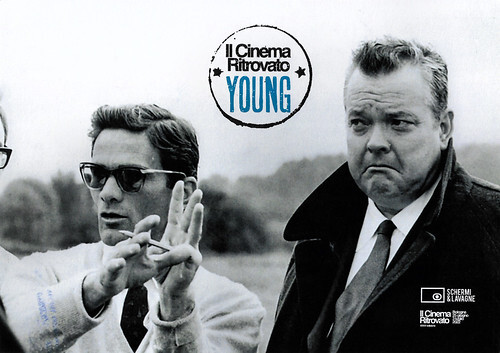
Big programme card by Cineteca Bologna for Il Cinema Ritrovato, XXXVI edizione, Selezione Cinema Ritrovato Young, 30 June 2022. Pierr Paolo Pasolini and Orson Welles on the set of La Ricotta (Pier Paolo Pasolini, 1963).La Ricotta was an episode of the anthology film Ep.di.Ro.Go.Pa.G. (1963).
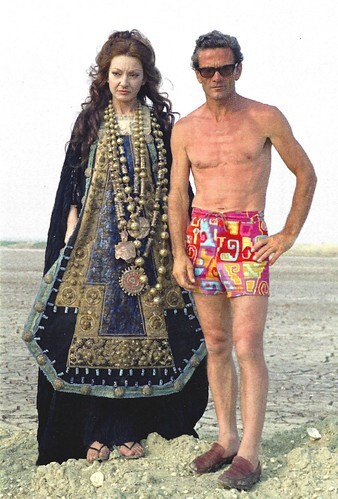
Italian postcard by Cineteca di Bologna. Photo: Mario Tursi. Maria Callas and Pier Paolo Pasolini during the shooting of Pasolini's Medea (1969).
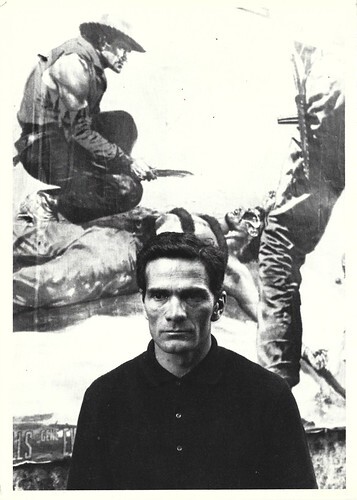
American postcard by Fotofolio. Photo: Jerry Bauer, 1969.
Poetry in the old language of ‘Friulan’
Pier Paolo Pasolini was born in 1922 in Bologna. His parents were Carlo Alberto Pasolini, a lieutenant of the Italian army, and his wife Susanna Colussi, an elementary school teacher. He had a younger brother, Guidalberto. During the first years of his life, the family moved several times because Pasolini's father was sent to different barracks as a soldier. Carlo became famous for saving Benito Mussolini's life.
Pasolini began writing poetry at the age of 7, inspired by the natural beauty of the small town of Casarsa. From age ten, he wrote poetry in the old language of ‘Friulan’, which was spoken by peasants and his mother, Susanna. In 1939, Pier Paolo went to study at the University of Bologna. He also frequented the local cinema club. Pasolini always showed his friends a virile and strong exterior, hiding his inner turmoil. He published at his own expense his first collection of poems in Friulan, ‘Poesia a Casarsa’, in 1941.
Two years later, during the Second World War, he was drafted into the Italian army, at that time allied with the Germans. A few days after Italy's capitulation, Pasolini's regiment was captured by two Germans in a tank, but he managed to escape. He fled to Casarsa where he remained for several years. After the war, he joined the Italian Communist Party in 1947, but he was expelled after a scandal. After studying in Bologna, he settled permanently in Rome with his mother in the early 1950s.
He was acquitted of two indecency charges in 1950 and 1952. His father, an officer in the Fascist army, had died by then. His younger brother had been killed as a partisan during the war. Mother and son initially struggled to make ends meet. They lived in an impoverished suburb of Rome, the subject of his controversial novella ‘Ragazzi di vita’ (1955), and later of the film Accattone (1961). Another examination of life in the slums was ‘Una vita violenta’ (1959), translated as ‘A Violent Life’. In addition to literary praise, he received criticism for the 'obscene nature' of his novellas.
Later, Pasolini also wrote about Semiotics in a paper called 'Il cinema di poesia' (1965). In it he says that cinema is "a non-conventional and non-symbolic language", that expresses reality through reality itself. In 1957, together with Sergio Citti, Pasolini collaborated on Fellini's film Le notti di Cabiria / Nights of Cabiria (Federico Fellini, 1957), writing dialogue for the Roman dialect sections. Federico Fellini also asked him to work on dialogue for some episodes of La dolce vita (Federico Fellini, 1960). He also co-wrote La Lunga Notte del '43 /Long Night in '43 (Florestano Vancini, 1960) starring Gino Cervi and Belinda Lee . Pasolini made his debut as an actor in the crime drama Il Gobbo / The Hunchback of Rome (Carlo Lizzani, 1960) starring Gérard Blain .
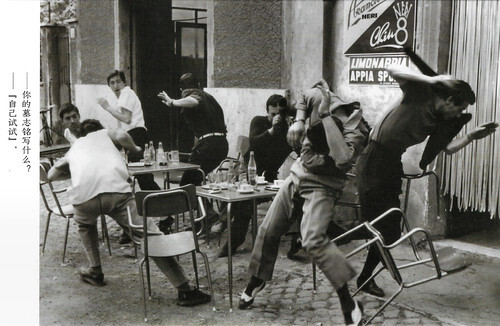
Chinese postcard. Scene from Accattone (Pier Paolo Pasolini, 1961).
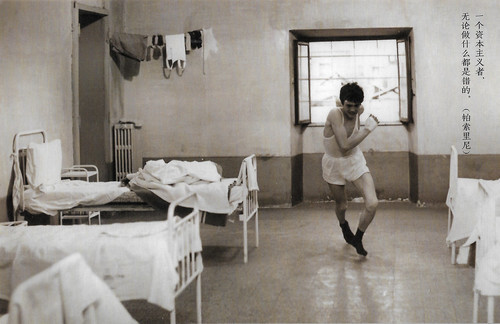
Chinese postcard. Ettore Garofolo in Mamma Roma (Pier Paolo Pasolini, 1962).
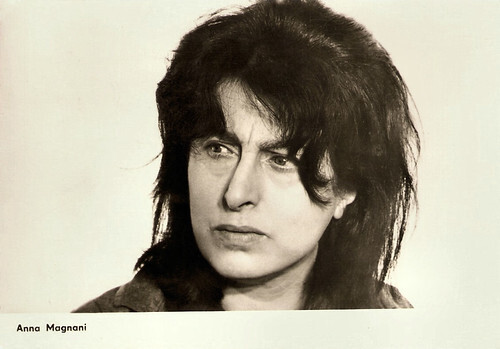
East-German postcard by VEB Progress Film-Vertrieb, Berlin, no. 2823, 1967. Sent by mail in East Germany in 1974. Anna Magnani in Mamma Roma (Pier Paolo Pasolini, 1962).
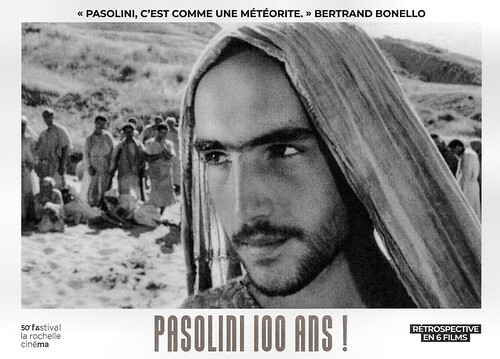
French postcard by L'étoile graphique for the retrospective 'Pasolini 100 ans!', 2022. Photo: SND (GroupeM6). Enrique Irazoqui in Il vangelo secondo Matteo (Pier Paolo Pasolini, 1964). Caption: "Pasolini is like a meteorite". Bertrand Bonello.
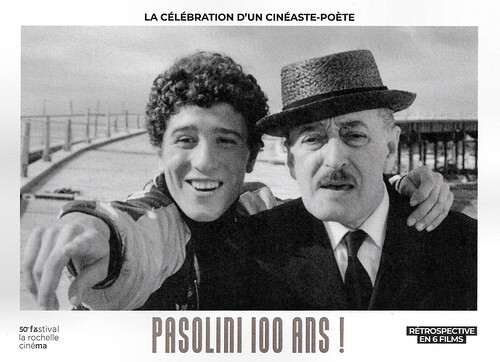
French postcard by L'étoile graphique for the retrospective 'Pasolini 100 ans!', 2022. Photo: SND (GroupeM6). Ninetto Davoli and Totò in Uccellacci e uccellini / The Hawks and the Sparrows (Pier Paolo Pasolini, 1966).
One of the few honest portrayals of Christ on screen
After making some strides in film in the late 1950s, Pier Paolo Pasolini debuted in 1961 with Accattone, starring Franco Citti. Its violent depiction of the life of a pimp in the slums of Rome caused a sensation. His second film was Mamma Roma (1962). Anna Magnani stars as an ex-prostitute who reunites with her son (Ettore Garofolo), but an extortion scheme threatens her aspirations for a decent life.
Pasolini was arrested in 1962 when La Ricotta, his segment of the portmanteau film Ro.Go.Pa.G. (Jean-Luc Godard, Ugo Gregoretti, Pier Paolo Pasolini, Roberto Rossellini, 1963) was considered blasphemous. In La Ricotta / Curd Cheese, Orson Welles plays a director who makes a lavish film about the life of Jesus Christ in a poor area. The central character is hoisted up on a cross for filming and dies there. Pasolini was given a suspended sentence.
Many expected that his next film, Il Vangelo secondo Matteo / The Gospel according to Matthew (1964), which presented the Biblical story in a realistic, stripped-down style, would cause a similar fuss. However, it was rapturously acclaimed as one of the few honest portrayals of Christ on screen and was praised even from within the Church. Jesus, a barefoot peasant, is played by a Spanish student, Enrique Irazoqui.
His next film was another surprise, the allegory Uccellacci e Uccellini / The Hawks and the Sparrows (1966) with Totò and Ninetto Davoli, who was Pasolini’s lover at the time. In the following years, Pasolini alternated between distinctly personal films and adaptations of classic literary texts, such as Edipo re / Oedipus Rex (1967), with Silvana Mangano as Jocasta and Franco Citti as Oedipus, and Medea (1969) starring Maria Callas.
In his more personal films, like Teorema / Theorem (1968) with Terence Stamp , Silvana Mangano and Massimo Girotti , and Porcile / Pigsty (1969) with Pierre Clémenti, he expressed his views on Marxism, atheism, fascism and homosexuality. His Trilogy of Life, based on medieval story collections, Il Decameron / The Decameron (1971) after Boccaccio, I Racconti di Canterbury / The Canterbury Tales (1972) after Geoffrey Chaucer, and Il Fiore delle Mille e Una Notte / Arabian Nights (1974) created confusion but was popular at the box office.
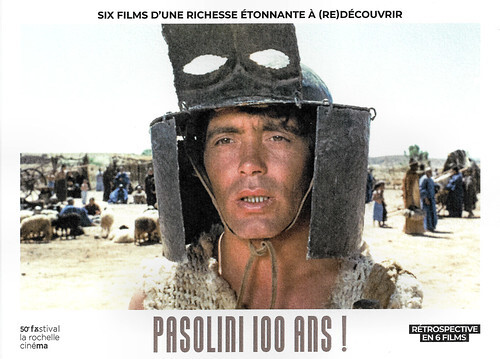
French postcard by L'étoile graphique for the retrospective 'Pasolini 100 ans!', 2022. Photo: SND (GroupeM6). Franco Citti in Edipo Re / Oedipus Rex (Pier Paolo Pasolini, 1967). Caption: Six astonishingly rich films to (re)discover.

French postcard by L'étoile graphique for the retrospective 'Pasolini 100 ans!', 2022. Photo: SND (GroupeM6). Maria Callas in Medea (Pier Paolo Pasolini, 1970).
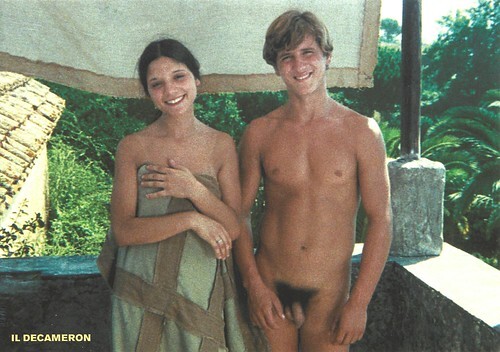
Dutch postcard. Photo: Contact Film. Publicity for Il Decameron / The Decameron (Pier Paolo Pasolini, 1971).

Vintage postcard by Moviestar, no. F113. Publicity still for Salò o le 120 giornate di Sodoma / Salò or the 120 days of Sodom (Pier Paolo Pasolini, 1975).
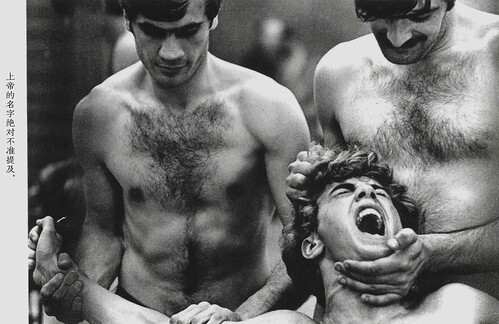
Chinese postcard. Publicity still for Salò o le 120 giornate di Sodoma / Salò or the 120 days of Sodom (Pier Paolo Pasolini, 1975).
His final and most notorious film
Pier Paolo Pasolini’s final and most notorious film was Salò o le 120 giornate di Sodoma / Salò or The 120 Days of Sodom (1975). The film is a relentlessly grim fusion of Benito Mussolini's Fascist Italy with the novel '120 Days of Sodom' by Marquis de Sade.
In Nazi-Fascist Northern Italy in 1943-44, four senior members of government, aided by henchmen and Nazi soldiers, kidnap a group of young men and women. They hold them for 120 days, subjecting them to all manner of torture, perversion, and degradation. The controversial and obscene film was banned in Italy and many other countries for several years.
On 2 November 1975, shortly after completing the film and before its release, Pasolini was found murdered on a beach in Ostia, near Rome. He was 53. The murder was gruesome, his heart had been burst, his face torn apart and he had been run over several times by a car. 17-year-old hustler Giuseppe Pelosi was arrested after being caught in Pasolini's car and confessing to the murder.
Although Pelosi was convicted, the circumstances of the murder were never sufficiently clarified. In 2005, Pelosi declared that Pasolini was killed by three men linked to political groups opposed to the director's films and politics. The police reopened the case in 2005 and 2009, but the court ruled in both cases that there were insufficient new facts to continue the investigation.
In 2014, American director Abel Ferrara made a biographical film about Pasolini starring Willem Dafoe. Giuseppe Pelosi died in 2017 in a hospital in Rome of lung cancer. Pier Paolo Pasolini is buried at the cemetery of Casarsa.
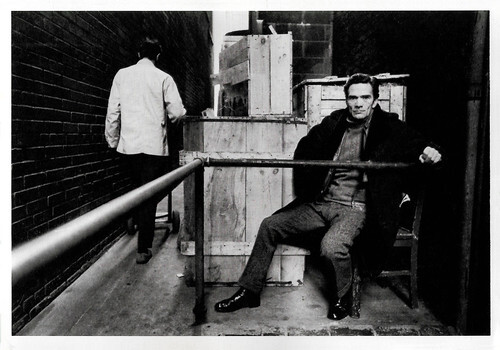
American postcard by Fotofolio, NY, NY, no. DM21. Photo: Duane Michals. Caption: Pasolini with anonymous boy, 1969.
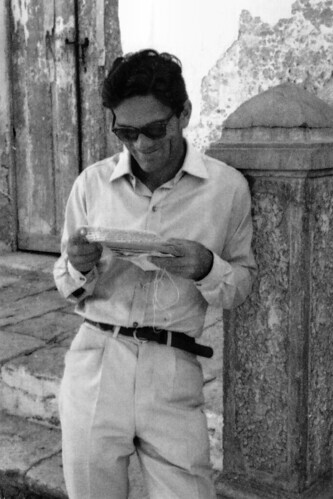
Italian postcard by Cineteca Bologna. Photo: Angelo Novi / Cineteca Bologna. Caption: Pier Paolo Pasolini on the set of Il Vangelo secondo Matteo / The Gospel according to Matthew (1964).
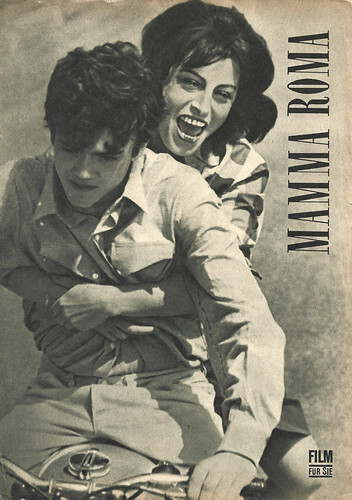
Cover of the East German leaflet 'Film für Sie' by VEB Progress Filmvertrieb, no. 44/67. Photo: Anna Magnani and Ettore Garofolo in Mamma Roma (Pier Paolo Pasolini, 1962). Their voices were dubbed in East Germany by Gisela May and Rainer Gerlach.
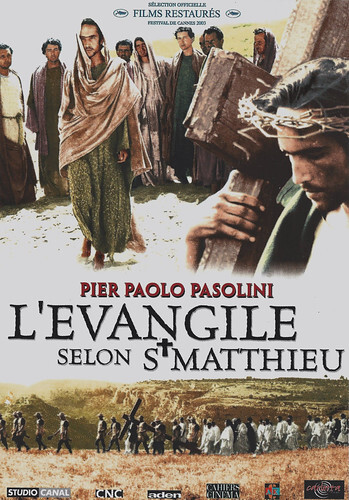
French postcard. Photo: Carlotta Films. Studio Canal. Poster for the film Il Vangelo secondo Matteo / The Gospel According to Matthew (Pier Paolo Pasolini, 1964). Enrique Irazoqui played Jesus. Published on the occasion of the newly restored version of the film which premiered at the Cannes Film Festival in 2003.
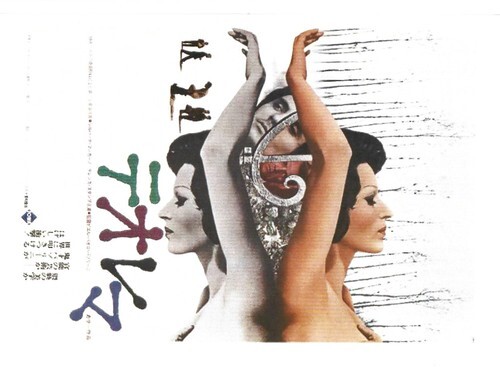
Spanish postcard by Editorial Filkasol. Japanese poster for Teorema (Pier Paolo Pasolini, 1968), with Silvana Mangano and Terence Stamp .
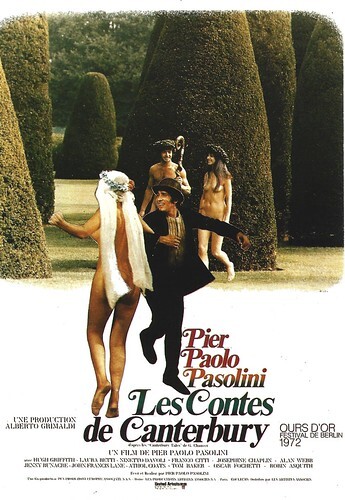
French postcard by Editions F. Nugeron. Poster by Jouineau Bourduge. Ninetto Davoli in I racconti di Canterbury / The Canterbury Tales (Pier Paolo Pasolini, 1972) based on Geoffrey Chaucer's 'Canterbury Tales'. The film won the Golden Bear in Berlin in 1972.
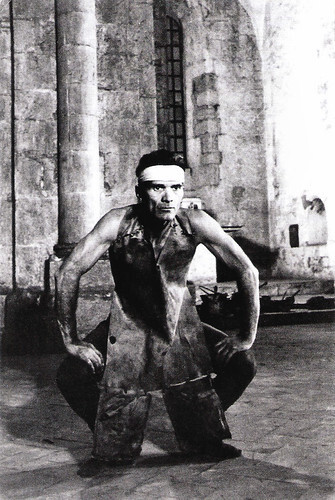
Italian postcard by Cineteca Bologna. Photo: Mario Tursi / Archivo Fotografico Cineteca di Bologna. Pier Paolo Pasolini in Il Decameron / The Decameron (Pier Paolo Pasolini, 1971).
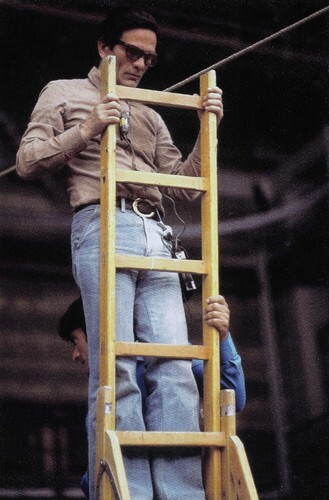
Italian postcard by Cineteca Bologna. Photo: Deborah Beer / Cinemazero / Archivo Fotografica Cineteca di Bologna. Pier Paolo Pasolini on the set of Salò o le 120 giornate di Sodoma / Salò or the 120 days of Sodom (Pier Paolo Pasolini, 1975).
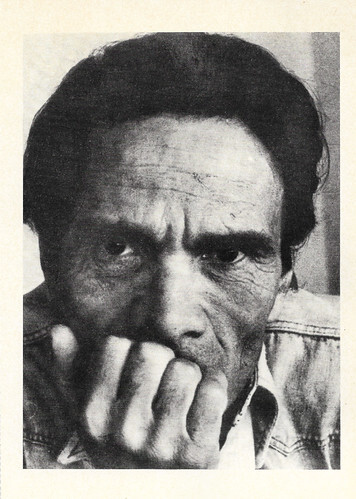
Italian postcard by Il piùlibri. Caption: Pier Paolo Pasolini (1922-1975). Poet, essayist and film director. He was killed by that barbarity which, unheard, he had painfully denounced.
Sources: (IMDb), Wikipedia (Dutch and English) and .

French postcard by Editions La Malibran, Paris / Saint -Dié, no. MC 12. Pier Paolo Pasolini in Il Decameron / The Decameron (Pier Paolo Pasolini, 1971).

Swiss postcard by Musée de l'Élysée, Lausanne / News Productions, Baulmes, no. 56409. Photo: John Philips. Caption: Pier Paolo Pasolini, Rome, 1962.

Big programme card by Cineteca Bologna for Il Cinema Ritrovato, XXXVI edizione, Selezione Cinema Ritrovato Young, 30 June 2022. Pierr Paolo Pasolini and Orson Welles on the set of La Ricotta (Pier Paolo Pasolini, 1963).La Ricotta was an episode of the anthology film Ep.di.Ro.Go.Pa.G. (1963).

Italian postcard by Cineteca di Bologna. Photo: Mario Tursi. Maria Callas and Pier Paolo Pasolini during the shooting of Pasolini's Medea (1969).

American postcard by Fotofolio. Photo: Jerry Bauer, 1969.
Poetry in the old language of ‘Friulan’
Pier Paolo Pasolini was born in 1922 in Bologna. His parents were Carlo Alberto Pasolini, a lieutenant of the Italian army, and his wife Susanna Colussi, an elementary school teacher. He had a younger brother, Guidalberto. During the first years of his life, the family moved several times because Pasolini's father was sent to different barracks as a soldier. Carlo became famous for saving Benito Mussolini's life.
Pasolini began writing poetry at the age of 7, inspired by the natural beauty of the small town of Casarsa. From age ten, he wrote poetry in the old language of ‘Friulan’, which was spoken by peasants and his mother, Susanna. In 1939, Pier Paolo went to study at the University of Bologna. He also frequented the local cinema club. Pasolini always showed his friends a virile and strong exterior, hiding his inner turmoil. He published at his own expense his first collection of poems in Friulan, ‘Poesia a Casarsa’, in 1941.
Two years later, during the Second World War, he was drafted into the Italian army, at that time allied with the Germans. A few days after Italy's capitulation, Pasolini's regiment was captured by two Germans in a tank, but he managed to escape. He fled to Casarsa where he remained for several years. After the war, he joined the Italian Communist Party in 1947, but he was expelled after a scandal. After studying in Bologna, he settled permanently in Rome with his mother in the early 1950s.
He was acquitted of two indecency charges in 1950 and 1952. His father, an officer in the Fascist army, had died by then. His younger brother had been killed as a partisan during the war. Mother and son initially struggled to make ends meet. They lived in an impoverished suburb of Rome, the subject of his controversial novella ‘Ragazzi di vita’ (1955), and later of the film Accattone (1961). Another examination of life in the slums was ‘Una vita violenta’ (1959), translated as ‘A Violent Life’. In addition to literary praise, he received criticism for the 'obscene nature' of his novellas.
Later, Pasolini also wrote about Semiotics in a paper called 'Il cinema di poesia' (1965). In it he says that cinema is "a non-conventional and non-symbolic language", that expresses reality through reality itself. In 1957, together with Sergio Citti, Pasolini collaborated on Fellini's film Le notti di Cabiria / Nights of Cabiria (Federico Fellini, 1957), writing dialogue for the Roman dialect sections. Federico Fellini also asked him to work on dialogue for some episodes of La dolce vita (Federico Fellini, 1960). He also co-wrote La Lunga Notte del '43 /Long Night in '43 (Florestano Vancini, 1960) starring Gino Cervi and Belinda Lee . Pasolini made his debut as an actor in the crime drama Il Gobbo / The Hunchback of Rome (Carlo Lizzani, 1960) starring Gérard Blain .

Chinese postcard. Scene from Accattone (Pier Paolo Pasolini, 1961).

Chinese postcard. Ettore Garofolo in Mamma Roma (Pier Paolo Pasolini, 1962).

East-German postcard by VEB Progress Film-Vertrieb, Berlin, no. 2823, 1967. Sent by mail in East Germany in 1974. Anna Magnani in Mamma Roma (Pier Paolo Pasolini, 1962).

French postcard by L'étoile graphique for the retrospective 'Pasolini 100 ans!', 2022. Photo: SND (GroupeM6). Enrique Irazoqui in Il vangelo secondo Matteo (Pier Paolo Pasolini, 1964). Caption: "Pasolini is like a meteorite". Bertrand Bonello.

French postcard by L'étoile graphique for the retrospective 'Pasolini 100 ans!', 2022. Photo: SND (GroupeM6). Ninetto Davoli and Totò in Uccellacci e uccellini / The Hawks and the Sparrows (Pier Paolo Pasolini, 1966).
One of the few honest portrayals of Christ on screen
After making some strides in film in the late 1950s, Pier Paolo Pasolini debuted in 1961 with Accattone, starring Franco Citti. Its violent depiction of the life of a pimp in the slums of Rome caused a sensation. His second film was Mamma Roma (1962). Anna Magnani stars as an ex-prostitute who reunites with her son (Ettore Garofolo), but an extortion scheme threatens her aspirations for a decent life.
Pasolini was arrested in 1962 when La Ricotta, his segment of the portmanteau film Ro.Go.Pa.G. (Jean-Luc Godard, Ugo Gregoretti, Pier Paolo Pasolini, Roberto Rossellini, 1963) was considered blasphemous. In La Ricotta / Curd Cheese, Orson Welles plays a director who makes a lavish film about the life of Jesus Christ in a poor area. The central character is hoisted up on a cross for filming and dies there. Pasolini was given a suspended sentence.
Many expected that his next film, Il Vangelo secondo Matteo / The Gospel according to Matthew (1964), which presented the Biblical story in a realistic, stripped-down style, would cause a similar fuss. However, it was rapturously acclaimed as one of the few honest portrayals of Christ on screen and was praised even from within the Church. Jesus, a barefoot peasant, is played by a Spanish student, Enrique Irazoqui.
His next film was another surprise, the allegory Uccellacci e Uccellini / The Hawks and the Sparrows (1966) with Totò and Ninetto Davoli, who was Pasolini’s lover at the time. In the following years, Pasolini alternated between distinctly personal films and adaptations of classic literary texts, such as Edipo re / Oedipus Rex (1967), with Silvana Mangano as Jocasta and Franco Citti as Oedipus, and Medea (1969) starring Maria Callas.
In his more personal films, like Teorema / Theorem (1968) with Terence Stamp , Silvana Mangano and Massimo Girotti , and Porcile / Pigsty (1969) with Pierre Clémenti, he expressed his views on Marxism, atheism, fascism and homosexuality. His Trilogy of Life, based on medieval story collections, Il Decameron / The Decameron (1971) after Boccaccio, I Racconti di Canterbury / The Canterbury Tales (1972) after Geoffrey Chaucer, and Il Fiore delle Mille e Una Notte / Arabian Nights (1974) created confusion but was popular at the box office.

French postcard by L'étoile graphique for the retrospective 'Pasolini 100 ans!', 2022. Photo: SND (GroupeM6). Franco Citti in Edipo Re / Oedipus Rex (Pier Paolo Pasolini, 1967). Caption: Six astonishingly rich films to (re)discover.

French postcard by L'étoile graphique for the retrospective 'Pasolini 100 ans!', 2022. Photo: SND (GroupeM6). Maria Callas in Medea (Pier Paolo Pasolini, 1970).

Dutch postcard. Photo: Contact Film. Publicity for Il Decameron / The Decameron (Pier Paolo Pasolini, 1971).

Vintage postcard by Moviestar, no. F113. Publicity still for Salò o le 120 giornate di Sodoma / Salò or the 120 days of Sodom (Pier Paolo Pasolini, 1975).

Chinese postcard. Publicity still for Salò o le 120 giornate di Sodoma / Salò or the 120 days of Sodom (Pier Paolo Pasolini, 1975).
His final and most notorious film
Pier Paolo Pasolini’s final and most notorious film was Salò o le 120 giornate di Sodoma / Salò or The 120 Days of Sodom (1975). The film is a relentlessly grim fusion of Benito Mussolini's Fascist Italy with the novel '120 Days of Sodom' by Marquis de Sade.
In Nazi-Fascist Northern Italy in 1943-44, four senior members of government, aided by henchmen and Nazi soldiers, kidnap a group of young men and women. They hold them for 120 days, subjecting them to all manner of torture, perversion, and degradation. The controversial and obscene film was banned in Italy and many other countries for several years.
On 2 November 1975, shortly after completing the film and before its release, Pasolini was found murdered on a beach in Ostia, near Rome. He was 53. The murder was gruesome, his heart had been burst, his face torn apart and he had been run over several times by a car. 17-year-old hustler Giuseppe Pelosi was arrested after being caught in Pasolini's car and confessing to the murder.
Although Pelosi was convicted, the circumstances of the murder were never sufficiently clarified. In 2005, Pelosi declared that Pasolini was killed by three men linked to political groups opposed to the director's films and politics. The police reopened the case in 2005 and 2009, but the court ruled in both cases that there were insufficient new facts to continue the investigation.
In 2014, American director Abel Ferrara made a biographical film about Pasolini starring Willem Dafoe. Giuseppe Pelosi died in 2017 in a hospital in Rome of lung cancer. Pier Paolo Pasolini is buried at the cemetery of Casarsa.

American postcard by Fotofolio, NY, NY, no. DM21. Photo: Duane Michals. Caption: Pasolini with anonymous boy, 1969.

Italian postcard by Cineteca Bologna. Photo: Angelo Novi / Cineteca Bologna. Caption: Pier Paolo Pasolini on the set of Il Vangelo secondo Matteo / The Gospel according to Matthew (1964).

Cover of the East German leaflet 'Film für Sie' by VEB Progress Filmvertrieb, no. 44/67. Photo: Anna Magnani and Ettore Garofolo in Mamma Roma (Pier Paolo Pasolini, 1962). Their voices were dubbed in East Germany by Gisela May and Rainer Gerlach.

French postcard. Photo: Carlotta Films. Studio Canal. Poster for the film Il Vangelo secondo Matteo / The Gospel According to Matthew (Pier Paolo Pasolini, 1964). Enrique Irazoqui played Jesus. Published on the occasion of the newly restored version of the film which premiered at the Cannes Film Festival in 2003.

Spanish postcard by Editorial Filkasol. Japanese poster for Teorema (Pier Paolo Pasolini, 1968), with Silvana Mangano and Terence Stamp .

French postcard by Editions F. Nugeron. Poster by Jouineau Bourduge. Ninetto Davoli in I racconti di Canterbury / The Canterbury Tales (Pier Paolo Pasolini, 1972) based on Geoffrey Chaucer's 'Canterbury Tales'. The film won the Golden Bear in Berlin in 1972.

Italian postcard by Cineteca Bologna. Photo: Mario Tursi / Archivo Fotografico Cineteca di Bologna. Pier Paolo Pasolini in Il Decameron / The Decameron (Pier Paolo Pasolini, 1971).

Italian postcard by Cineteca Bologna. Photo: Deborah Beer / Cinemazero / Archivo Fotografica Cineteca di Bologna. Pier Paolo Pasolini on the set of Salò o le 120 giornate di Sodoma / Salò or the 120 days of Sodom (Pier Paolo Pasolini, 1975).

Italian postcard by Il piùlibri. Caption: Pier Paolo Pasolini (1922-1975). Poet, essayist and film director. He was killed by that barbarity which, unheard, he had painfully denounced.
Sources: (IMDb), Wikipedia (Dutch and English) and .
Published on June 10, 2025 22:00
June 9, 2025
Elsa Martinelli
Glamorous Italian actress and former fashion model Elsa Martinelli (1935-2017) showed her beautiful curves in many European and Hollywood productions of the 1950s and 1960s. Somehow she never became the star she was destined to become in the mid-1950s.
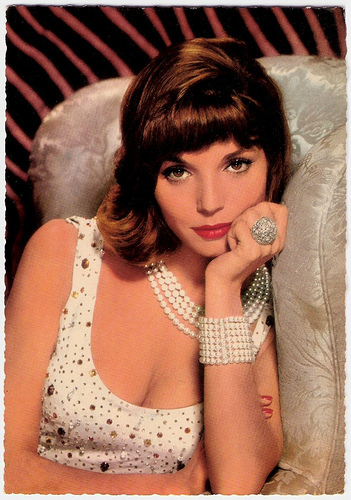
German postcard by Krüger, no. 902/255.

German postcard by ISV, no. D 22. Photo: Pierluigi.
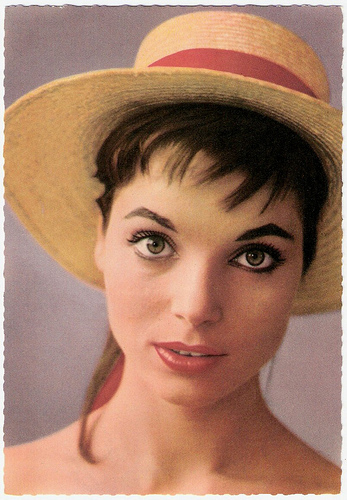
German postcard by ISV, no. D 27. Photo: Pierluigi.
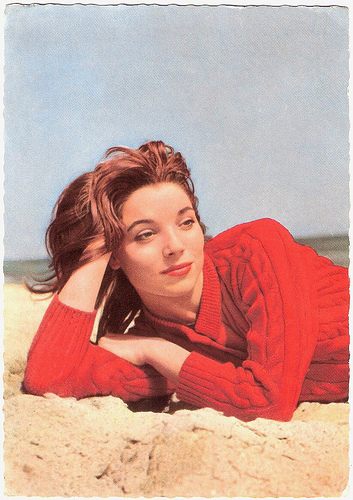
German postcard by Universum-Film Aktiengesellschaft (Ufa), Berlin-Tempelhof, no. CK 39. Retail price: 30 Pfg. Photo: Ufa.
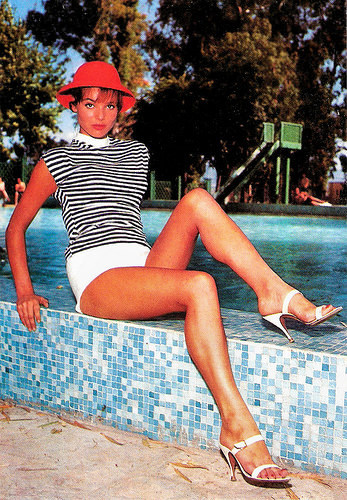
Spanish postcard by Postal Oscarcolor, no. 407.
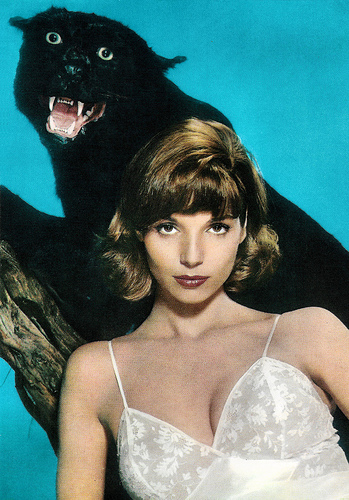
Italian postcard by Rotalcolor, Milano, no. N. 178. Photo: Warner Bros. Publicity still for Hatari! (Howard Hawks, 1962).
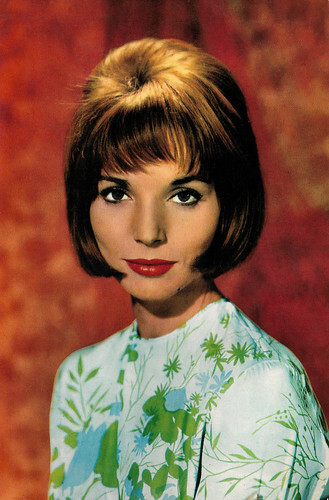
Spanish postcard by Raker, no. 1116, 1964.
The world of fashion
Elsa Martinelli was born Elsa Tia in Grosseto, Tuscany, in 1935. Soon after her birth, her large and very poor family moved to Rome. Elsa had to earn her keep from the age of twelve, delivering groceries.
In 1953, while working as a barmaid, she was discovered by designer Roberto Capucci who introduced her to the fashion world. She became a model and began playing small roles in films.
She appeared uncredited in Le Rouge et le noir / Scarlet and Black (Claude Autant-Lara, 1954) starring Gérard Philipe.
Her first important film role came the following year with the American Western The Indian Fighter (André De Toth, 1955), in which she played the Native American heroine opposite Kirk Douglas . Douglas claims to have spotted her on a Life magazine cover and hired her for his production company, Bryna Productions.
She returned to Rome and starred in the Carlo Ponti production La risaia / Rice Girl (Raffaello Matarazzo, 1956) with Folco Lulli and Rik Battaglia . The melodrama was an obvious attempt to recapture the success of Riso Amaro / Bitter Rice (Giuseppe De Santis, 1949) with Silvana Mangano as the sexy rice field worker in hot pants. The attempt worked quite well.

Italian postcard by Rotalfoto, Milano / G.B. & F., V, no. 2072. Photo: Carlo Ponti. Publicity still for La risaia / The Rice Girl (Raffaello Matarazzo, 1956). Caption: Saluti dalla Risaia (Greetings from the rice girl).
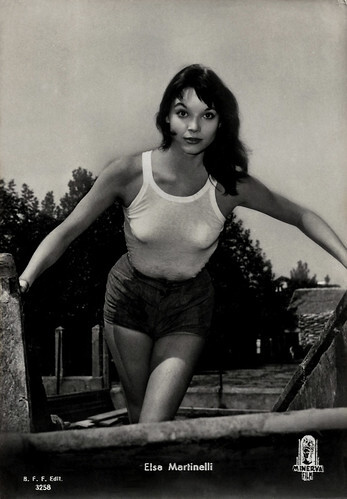
Italian postcard by B.F.F. Edit., no. 3258. Photo: Minerva Film. Elsa Martinelli in La risaia / The Rice Girl (Raffaello Matarazzo, 1956).
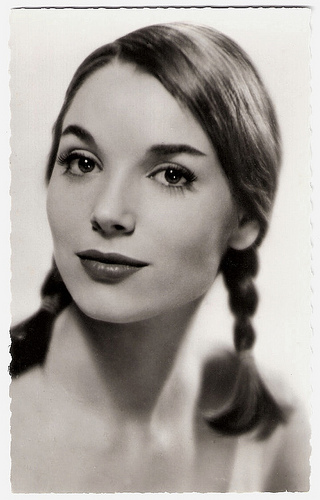
French postcard by Editions P.I., Paris, offered by Les Carbones Korès 'Carboplane', no. 917. Photo: Paramount, 1957.
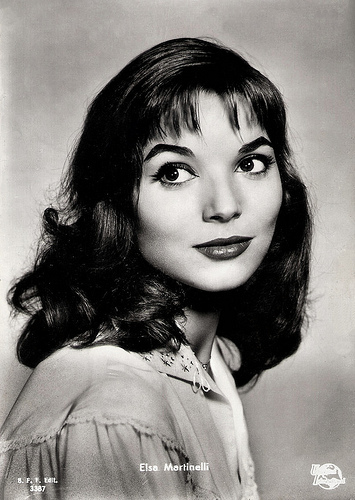
Italian postcard by Casa Editr. Ballerini & Fratini, Firenze (B.F.F. Edit.), no. 3387. Photo: Universal.
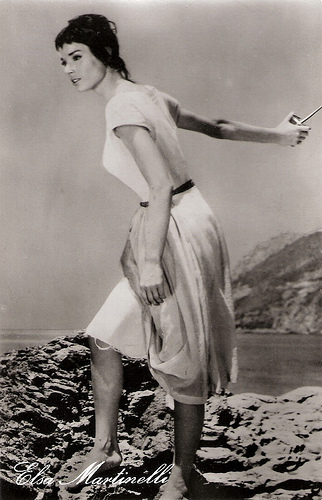
East-German postcard by VEB Progress Film-Vertrieb, no. 1064, 1959. Retail price: 0,20 DM. Photo: Maxima-Lux Rome; Aspa, Madrid. Publicity still for La mina / The Mine (Giuseppe Bennati, 1957).
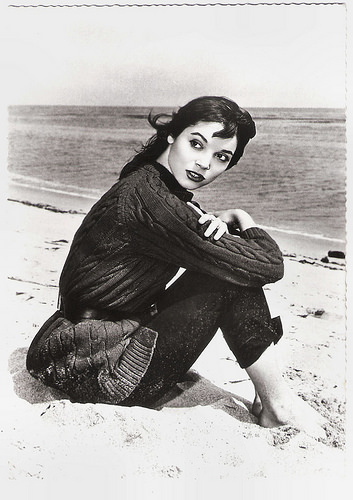
Italian postcard by 3K, no. 3841.
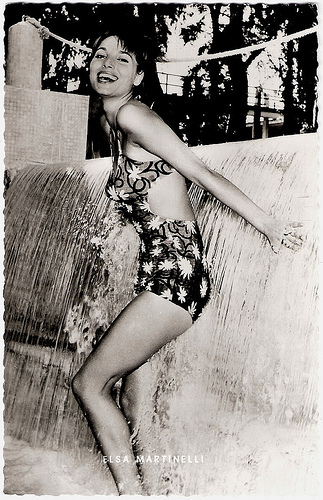
German postcard by Kunst und Bild, Berlin-Charlottenburg, no. S 737. Photo: Unitalia-Film / Dial.
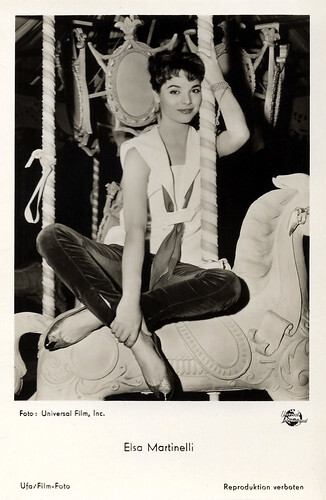
West German postcard by Ufa/Film-foto, Berlin-Tempelhof, no. FK 3912. Photo: Universal.
Modern Cinderella
In 1956 Elsa Martinelli won the Silver Berlin Bear for Best Actress at the Berlin International Film Festival. She won this prestigious award for playing a modern Cinderella in the comedy Donatella (Mario Monicelli, 1956) with Gabriele Ferzetti .
From then on, she divided her time between Europe and the US and appeared in such films as Four Girls in Town (Jack Sher, 1956) with George Nader , Manuela / The Stowaway Girl (Guy Hamilton, 1957) with Trevor Howard , the historical drama I Battellieri del Volga / Prisoner of the Volga (Victor Tourjansky, 1959) with John Derek and the romance Un amore a Roma / Love in Rome (Dino Risi, 1960).
Highlights were the excellent drama La notte brava (Mauro Bolognini, 1959), based on a novel by Pier Paolo Pasolini and the haunting and surreal Horror film Et mourir de plaisir / Blood and Roses (Roger Vadim, 1960).
Et mourir de plaisir / Blood and Roses (Roger Vadim, 1960) was an attempt to retell the classic Sheridan Le Fanu vampire tale 'Carmilla', co-starring the director's wife Annette Vadim (or Annette Stroyberg).
In 1957 Elsa married wealthy Count Franco Mancinelli Scotti di San Vito. Her mother-in-law, Countess Margherita Manicineli Scotti di San Vito, reportedly expelled her son from their Rome palace because the marriage was against her wishes. Finally, she fired her son from his job as manager of the family estate.
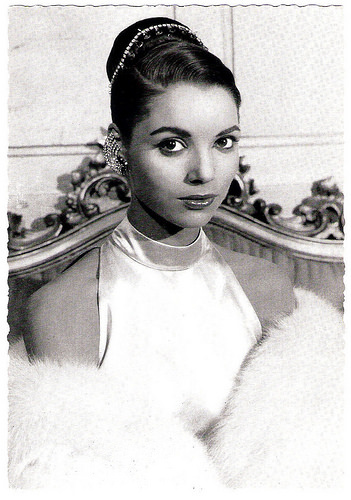
German postcard by Filmbilder-Vertrieb Ernst Freihoff, Essen, no. 233. Photo: Georg Michalke.
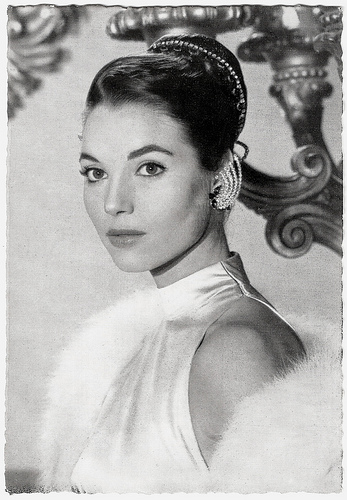
German postcard by WS-Druck, Wanne-Eickel, no. 284. Photo: Georg Michalke / Archiv Filmpress Zürich.
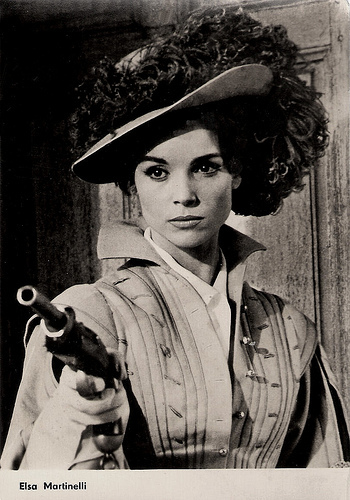
East-German postcard by VEB Progress Film-Vertrieb, Berlin, no. 1.974, 1963. Photo: publicity still for Le capitan / Captain Blood (André Hunebelle, 1960).
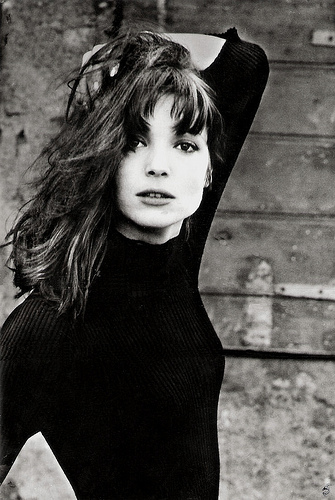
Romanian postcard by Casa Filmului Acin, no. 103. Photo: publicity still for Hatari! (Howard Hawks, 1962).

Romanian postcard by Casa Filmului Acin, no. 470. Sent by mail in 1972. Photo: publicity still for Le procès / The Trial (Orson Welles, 1962) with Anthony Perkins .
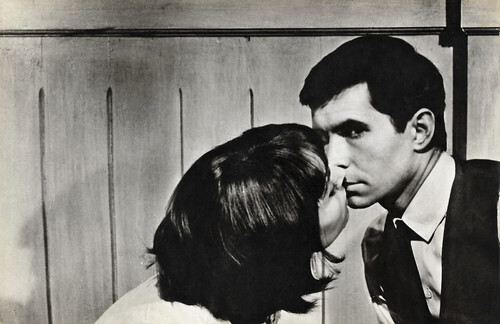
Romanian postcard by Casa Filmului Acin, no. 474. Photo: Elsa Martinelli and Anthony Perkins in Le procès/The Trial (Orson Welles, 1962). Sent by mail in 1972.
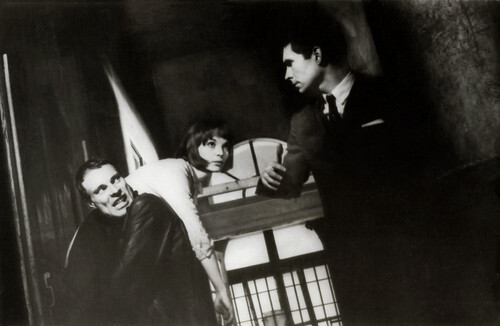
Romanian postcard by Casa Filmului Acin, no. 493. Photo: Elsa Martinelli, Thomas Holtzmann and Anthony Perkins in Le procès / The Trial (Orson Welles, 1962). The Romanian film title was Procesul.
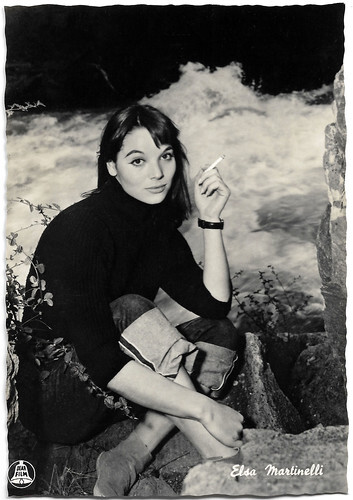
Italian postcard by Bromofoto, Milano, no. 1121. Photo: Dear Film.
Tried and true Howard Hawks fashion
One of Elsa Martinelli’s most interesting films is Orson Welles ’ adaptation of Franz Kafka's 'Der Prozess', Le Procès / The Trial (Orson Welles, 1962). Anthony Perkins played Joseph K, a man condemned for an unnamed crime in an unnamed country. Seeking justice, he is sucked into a labyrinth of bureaucracy. Along the way, he becomes involved with three women - Jeanne Moreau , Romy Schneider and Martinelli - who in their own individual ways are functions of the System that persecutes him.
In the action and adventure comedy Hatari! (Howard Hawks, 1962) she played a freelance wildlife photographer on a Tanganyika game farm. Martinelli was the eye candy in a star cast with John Wayne , Gérard Blain, Red Buttons and Hardy Krüger . Hal Erickson at AllMovie : "Wayne's men-only contingent is reduced to jello when Elsa enters the scene, but in tried and true Howard Hawks fashion, she quickly becomes ‘one of the guys’."
In the comedy The Pigeon That Took Rome (Melville Shavelson, 1962) she starred opposite Charlton Heston , and in The V.I.P.’s (Anthony Asquith, 1963) she was the protegee of Orson Welles . In the South Seas adventure Rampage (Phil Karlson, 1963) she co-starred with Robert Mitchum , and in the episodic sex comedy Sette Volte Donna / Woman Times Seven (Vittorio De Sica, 1967) with Lex Barker .
In the big-budget adaptation of Terry Southern's satiric sex farce, Candy (Christian Marquand, 1968), she played Candy’s mother in a cast with Charles Aznavour , Marlon Brando , and Richard Burton .
In Italy she made the near surrealist Western Il mio corpo per un poker / Belle Starr (Piero Cristofani, Lina Wertmuller, 1968), and a stylish erotic thriller, Una sull'altra / One on Top of the Other (Lucio Fulci, 1969), with Marisa Mell and Jean Sorel .
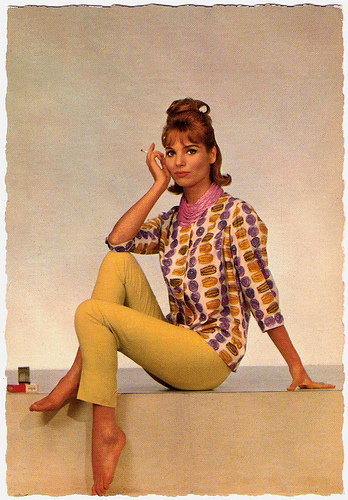
French postcard by E.D.U.G., no. 199. Photo: Sam Lévin.
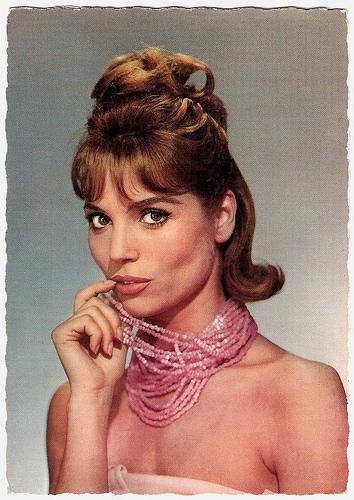
French postcard by E.D.U.G., no. 124. Photo: Sam Lévin.
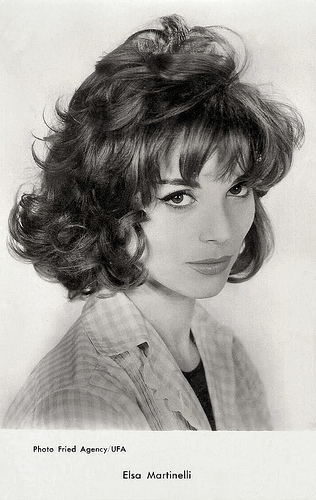
French postcard by Editions P.I., Paris, offered by Les Carbones Korès 'Carboplane', no. FK 32. Photo: Fried Agency / Ufa.

German postcard by Ufa/Film-Foto, no. FK 3172. Photo: Unitalia Film, Roma.
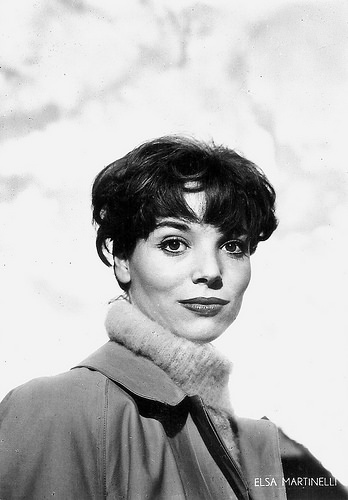
Italian photocard, editor and photographer unknown.
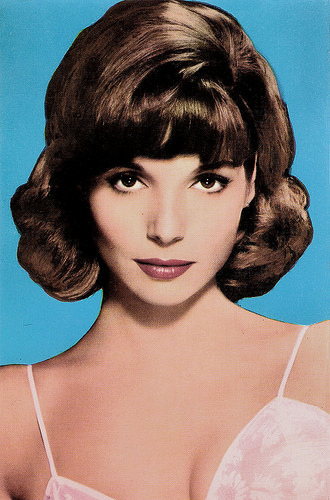
Spanish postcard by Archivo Bermejo, no. C. 263, 1965. Photo: Warner Bros. Publicity still for Hatari! (Howard Hawks, 1962).
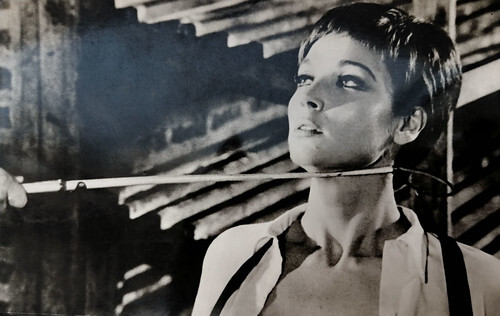
Romanian postcard by Casa Filmului Acin, no. 545. Elsa Martinelli in Maldonne / Misdeal (Sergio Gobbi, 1969). Collection: Alina Deaconu.
Interior designer
In the 1970s the film career of Elsa Martinelli somehow halted. She only appeared incidentally in European films. Martinelli starred opposite Robert Hossein in the French caper film La Part des Lions / The Lions' Share (Jean Larriaga, 1971), and she played a supporting part in the political drama Garofano Rosso / The Red Carnation (Luigi Faccini, 1976) with Marina Berti .
On TV she appeared as a guest star in The Return of the Saint (1979) with Ian Ogilvy as Simon Templar. Meanwhile, she had started a new, successful career as an interior designer, but she continued to accept incidental parts in films and TV series.
After Sono Un Fenomeno Paranormale / I'm a Paranormal Phenomenon (Sergio Corbucci, 1985) with Alberto Sordi , she made unheralded return appearances in the international productions Arrivederci Roma (Clive Donner, 1990) and the inconsequential all-star comedy Once Upon a Crime (Eugene Levy, 1992).
Finally, she was seen in the short film Cabiria, Priscilla e le altre / Cabiria, Priscilla and the Others (Fabrizio Celestini, 1999) and the TV-series Orgoglio (2005).
Elsa Martinelli was married from 1957 till 1964 to Count Franco Mancinelli Scotti di San Vito, by whom she has a daughter, actress Cristiana Mancinelli (1958). In 1968 she married Paris Match photographer and 1970s furniture designer Willy Rizzo, with whom she had a son. On 8 July 2017, Elsa Martinelli passed away in Rome, Italy. She was 82. Her husband Willy Rizzo had died in 2013.
Trailer The Indian Fighter (1955). Source: zinho jp (YouTube).
Italian trailer Donatella (1956). Source: CG Entertainment (YouTube). No subtitles, sorry.
German DVD trailer for La risaia / The Rice Girl 1956). Source: Arild Rafalzik (YouTube). No subtitles, sorry.
Trailer Hatari! (1962). Source: Paramountmovies Digital (YouTube).
Trailer Le Procès / The Trial (1962). Source: Danios 12345 (YouTube).
Elsa Martinelli and Robert Hoffman in Come Imparai ad Amare le Donne (1967). Source: stranevisioni (YouTube). No subtitles, sorry.
Sources: Hal Erickson (AllMovie - Page now deunct), Marlène Pilaete (Les Gens du Cinéma - French), Kimberly Lindbergs (Cinebeats), Gerald A. DeLuca (IMDb), Glamour Girls of the Silver Screen, Wikipedia, and .

German postcard by Krüger, no. 902/255.

German postcard by ISV, no. D 22. Photo: Pierluigi.

German postcard by ISV, no. D 27. Photo: Pierluigi.

German postcard by Universum-Film Aktiengesellschaft (Ufa), Berlin-Tempelhof, no. CK 39. Retail price: 30 Pfg. Photo: Ufa.

Spanish postcard by Postal Oscarcolor, no. 407.

Italian postcard by Rotalcolor, Milano, no. N. 178. Photo: Warner Bros. Publicity still for Hatari! (Howard Hawks, 1962).

Spanish postcard by Raker, no. 1116, 1964.
The world of fashion
Elsa Martinelli was born Elsa Tia in Grosseto, Tuscany, in 1935. Soon after her birth, her large and very poor family moved to Rome. Elsa had to earn her keep from the age of twelve, delivering groceries.
In 1953, while working as a barmaid, she was discovered by designer Roberto Capucci who introduced her to the fashion world. She became a model and began playing small roles in films.
She appeared uncredited in Le Rouge et le noir / Scarlet and Black (Claude Autant-Lara, 1954) starring Gérard Philipe.
Her first important film role came the following year with the American Western The Indian Fighter (André De Toth, 1955), in which she played the Native American heroine opposite Kirk Douglas . Douglas claims to have spotted her on a Life magazine cover and hired her for his production company, Bryna Productions.
She returned to Rome and starred in the Carlo Ponti production La risaia / Rice Girl (Raffaello Matarazzo, 1956) with Folco Lulli and Rik Battaglia . The melodrama was an obvious attempt to recapture the success of Riso Amaro / Bitter Rice (Giuseppe De Santis, 1949) with Silvana Mangano as the sexy rice field worker in hot pants. The attempt worked quite well.

Italian postcard by Rotalfoto, Milano / G.B. & F., V, no. 2072. Photo: Carlo Ponti. Publicity still for La risaia / The Rice Girl (Raffaello Matarazzo, 1956). Caption: Saluti dalla Risaia (Greetings from the rice girl).

Italian postcard by B.F.F. Edit., no. 3258. Photo: Minerva Film. Elsa Martinelli in La risaia / The Rice Girl (Raffaello Matarazzo, 1956).

French postcard by Editions P.I., Paris, offered by Les Carbones Korès 'Carboplane', no. 917. Photo: Paramount, 1957.

Italian postcard by Casa Editr. Ballerini & Fratini, Firenze (B.F.F. Edit.), no. 3387. Photo: Universal.

East-German postcard by VEB Progress Film-Vertrieb, no. 1064, 1959. Retail price: 0,20 DM. Photo: Maxima-Lux Rome; Aspa, Madrid. Publicity still for La mina / The Mine (Giuseppe Bennati, 1957).

Italian postcard by 3K, no. 3841.

German postcard by Kunst und Bild, Berlin-Charlottenburg, no. S 737. Photo: Unitalia-Film / Dial.

West German postcard by Ufa/Film-foto, Berlin-Tempelhof, no. FK 3912. Photo: Universal.
Modern Cinderella
In 1956 Elsa Martinelli won the Silver Berlin Bear for Best Actress at the Berlin International Film Festival. She won this prestigious award for playing a modern Cinderella in the comedy Donatella (Mario Monicelli, 1956) with Gabriele Ferzetti .
From then on, she divided her time between Europe and the US and appeared in such films as Four Girls in Town (Jack Sher, 1956) with George Nader , Manuela / The Stowaway Girl (Guy Hamilton, 1957) with Trevor Howard , the historical drama I Battellieri del Volga / Prisoner of the Volga (Victor Tourjansky, 1959) with John Derek and the romance Un amore a Roma / Love in Rome (Dino Risi, 1960).
Highlights were the excellent drama La notte brava (Mauro Bolognini, 1959), based on a novel by Pier Paolo Pasolini and the haunting and surreal Horror film Et mourir de plaisir / Blood and Roses (Roger Vadim, 1960).
Et mourir de plaisir / Blood and Roses (Roger Vadim, 1960) was an attempt to retell the classic Sheridan Le Fanu vampire tale 'Carmilla', co-starring the director's wife Annette Vadim (or Annette Stroyberg).
In 1957 Elsa married wealthy Count Franco Mancinelli Scotti di San Vito. Her mother-in-law, Countess Margherita Manicineli Scotti di San Vito, reportedly expelled her son from their Rome palace because the marriage was against her wishes. Finally, she fired her son from his job as manager of the family estate.

German postcard by Filmbilder-Vertrieb Ernst Freihoff, Essen, no. 233. Photo: Georg Michalke.

German postcard by WS-Druck, Wanne-Eickel, no. 284. Photo: Georg Michalke / Archiv Filmpress Zürich.

East-German postcard by VEB Progress Film-Vertrieb, Berlin, no. 1.974, 1963. Photo: publicity still for Le capitan / Captain Blood (André Hunebelle, 1960).

Romanian postcard by Casa Filmului Acin, no. 103. Photo: publicity still for Hatari! (Howard Hawks, 1962).

Romanian postcard by Casa Filmului Acin, no. 470. Sent by mail in 1972. Photo: publicity still for Le procès / The Trial (Orson Welles, 1962) with Anthony Perkins .

Romanian postcard by Casa Filmului Acin, no. 474. Photo: Elsa Martinelli and Anthony Perkins in Le procès/The Trial (Orson Welles, 1962). Sent by mail in 1972.

Romanian postcard by Casa Filmului Acin, no. 493. Photo: Elsa Martinelli, Thomas Holtzmann and Anthony Perkins in Le procès / The Trial (Orson Welles, 1962). The Romanian film title was Procesul.

Italian postcard by Bromofoto, Milano, no. 1121. Photo: Dear Film.
Tried and true Howard Hawks fashion
One of Elsa Martinelli’s most interesting films is Orson Welles ’ adaptation of Franz Kafka's 'Der Prozess', Le Procès / The Trial (Orson Welles, 1962). Anthony Perkins played Joseph K, a man condemned for an unnamed crime in an unnamed country. Seeking justice, he is sucked into a labyrinth of bureaucracy. Along the way, he becomes involved with three women - Jeanne Moreau , Romy Schneider and Martinelli - who in their own individual ways are functions of the System that persecutes him.
In the action and adventure comedy Hatari! (Howard Hawks, 1962) she played a freelance wildlife photographer on a Tanganyika game farm. Martinelli was the eye candy in a star cast with John Wayne , Gérard Blain, Red Buttons and Hardy Krüger . Hal Erickson at AllMovie : "Wayne's men-only contingent is reduced to jello when Elsa enters the scene, but in tried and true Howard Hawks fashion, she quickly becomes ‘one of the guys’."
In the comedy The Pigeon That Took Rome (Melville Shavelson, 1962) she starred opposite Charlton Heston , and in The V.I.P.’s (Anthony Asquith, 1963) she was the protegee of Orson Welles . In the South Seas adventure Rampage (Phil Karlson, 1963) she co-starred with Robert Mitchum , and in the episodic sex comedy Sette Volte Donna / Woman Times Seven (Vittorio De Sica, 1967) with Lex Barker .
In the big-budget adaptation of Terry Southern's satiric sex farce, Candy (Christian Marquand, 1968), she played Candy’s mother in a cast with Charles Aznavour , Marlon Brando , and Richard Burton .
In Italy she made the near surrealist Western Il mio corpo per un poker / Belle Starr (Piero Cristofani, Lina Wertmuller, 1968), and a stylish erotic thriller, Una sull'altra / One on Top of the Other (Lucio Fulci, 1969), with Marisa Mell and Jean Sorel .

French postcard by E.D.U.G., no. 199. Photo: Sam Lévin.

French postcard by E.D.U.G., no. 124. Photo: Sam Lévin.

French postcard by Editions P.I., Paris, offered by Les Carbones Korès 'Carboplane', no. FK 32. Photo: Fried Agency / Ufa.

German postcard by Ufa/Film-Foto, no. FK 3172. Photo: Unitalia Film, Roma.

Italian photocard, editor and photographer unknown.

Spanish postcard by Archivo Bermejo, no. C. 263, 1965. Photo: Warner Bros. Publicity still for Hatari! (Howard Hawks, 1962).

Romanian postcard by Casa Filmului Acin, no. 545. Elsa Martinelli in Maldonne / Misdeal (Sergio Gobbi, 1969). Collection: Alina Deaconu.
Interior designer
In the 1970s the film career of Elsa Martinelli somehow halted. She only appeared incidentally in European films. Martinelli starred opposite Robert Hossein in the French caper film La Part des Lions / The Lions' Share (Jean Larriaga, 1971), and she played a supporting part in the political drama Garofano Rosso / The Red Carnation (Luigi Faccini, 1976) with Marina Berti .
On TV she appeared as a guest star in The Return of the Saint (1979) with Ian Ogilvy as Simon Templar. Meanwhile, she had started a new, successful career as an interior designer, but she continued to accept incidental parts in films and TV series.
After Sono Un Fenomeno Paranormale / I'm a Paranormal Phenomenon (Sergio Corbucci, 1985) with Alberto Sordi , she made unheralded return appearances in the international productions Arrivederci Roma (Clive Donner, 1990) and the inconsequential all-star comedy Once Upon a Crime (Eugene Levy, 1992).
Finally, she was seen in the short film Cabiria, Priscilla e le altre / Cabiria, Priscilla and the Others (Fabrizio Celestini, 1999) and the TV-series Orgoglio (2005).
Elsa Martinelli was married from 1957 till 1964 to Count Franco Mancinelli Scotti di San Vito, by whom she has a daughter, actress Cristiana Mancinelli (1958). In 1968 she married Paris Match photographer and 1970s furniture designer Willy Rizzo, with whom she had a son. On 8 July 2017, Elsa Martinelli passed away in Rome, Italy. She was 82. Her husband Willy Rizzo had died in 2013.
Trailer The Indian Fighter (1955). Source: zinho jp (YouTube).
Italian trailer Donatella (1956). Source: CG Entertainment (YouTube). No subtitles, sorry.
German DVD trailer for La risaia / The Rice Girl 1956). Source: Arild Rafalzik (YouTube). No subtitles, sorry.
Trailer Hatari! (1962). Source: Paramountmovies Digital (YouTube).
Trailer Le Procès / The Trial (1962). Source: Danios 12345 (YouTube).
Elsa Martinelli and Robert Hoffman in Come Imparai ad Amare le Donne (1967). Source: stranevisioni (YouTube). No subtitles, sorry.
Sources: Hal Erickson (AllMovie - Page now deunct), Marlène Pilaete (Les Gens du Cinéma - French), Kimberly Lindbergs (Cinebeats), Gerald A. DeLuca (IMDb), Glamour Girls of the Silver Screen, Wikipedia, and .
Published on June 09, 2025 22:00
June 7, 2025
Arjan Ederveen
Arjan Ederveen (1956) is a Dutch actor, comedian, TV scriptwriter and TV director. He participated in the classical satirical Dutch TV series Theo en Thea / Theo and Thea (1985-1989), Kreatief met Kurk / Creative with Cork (1993-1994) and 30 minuten / 30 Minutes (1995-1997). He also played in the stage musicals 'Hairspray' and 'Lang en Gelukkig' (Happily Ever After) and appeared in several films.
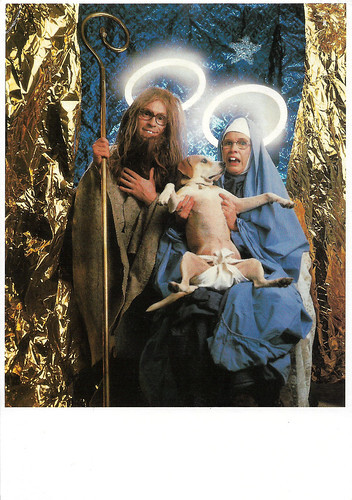
Dutch postcard by Art Unlimited, Amsterdam / Van den Beginne BV, no. C3134. Photo: Benno de Wilde. Arjan Ederveen and Tosca Niterink as Theo & Thea in Theo en Thea en de Ontmaskering van het Tenenkaasimperium / Theo and Thea and the Unmasking of the Toe Cheese Empire (Pieter Kramer, 1989).

Dutch postcard by Theaterbureau Vice Versa, Amsterdam. Photo: Peter Gramberg. Arjan Ederveen and Kees Prins as De Duo's.
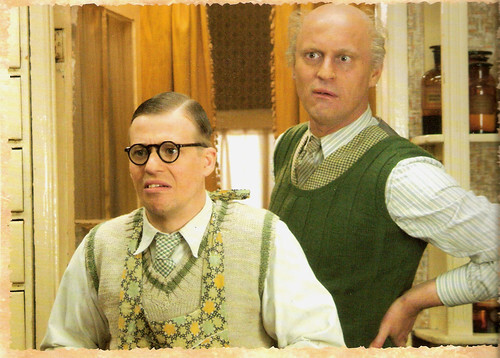
Dutch postcard by Rubinstein. Stijn Westenend and Arjan Ederveen in Pietje Bell / Peter Bell (Maria Peters, 2002).
A whole generation remembers the duo with the big front teeth
Arjan Ederveen Janssen was born in 1956 in Hilversum, The Netherlands. His mother, Greetje van Schaik, was an actress, who appeared in the popular Dutch radio show 'De bonte dinsdagavondtrein'. He had two brothers, who both died young, respectively of AIDS and a rare blood disease. Ederveen did his high school education at Comenius College in Hilversum. During a school project, he made his first film, Appel aan de Stok: De Musical (1971). With this film, he won a local film competition.
Ederveen studied at the Academie voor Kleinkunst in Amsterdam where he met fellow student Kees Prins. After graduating, they started their career together as The Duos. Between 1981 and 1984, they created four theatre performances and the television programme De Duo's doen alsof / The Duos Are Pretending. Ederveen made his screen debut in the German Werktheater production Waldeslust / Bosch en Lucht (Friedrich Schaller, 1981) with Joop Admiraal and Kees Prins. He also appeared in two Dutch films, the Virginia Woolf adaptation Golven / Waves (Annette Apon, 1981) and another Werktheater production, Een zwoele zomeravond / A Hot Summer Night (Frans Weisz, Shireen Strooker, 1982) with Gerard Thoolen. He also played a bellboy in the American comedy Still Smokin' (Tommy Chong, 1983) in which Cheech and Chong fly to the marijuana capital of the world, Amsterdam.
Together with Tosca Niterink, Ederveen formed a new TV duo Theo & Thea (Robert Wiering, Pieter Kramer, 1985-1989), a brother and sister with plastic rabbit teeth and thick glasses. The characters became hugely famous in The Netherlands and a whole generation remembers the duo with the big front teeth. In the biography 'Altijd van je af' (Always away from you, 2025), Arjan Ederveen describes the duo: "They are pathetic little children, misfits. Wishy-washy kids. Kids who get bullied. Theo was exactly like I was myself."
Although Theo & Thea was a children's programme, it also became popular among students. Incidentally, the programme was criticised for its adult themes, such as drugs, sexual harassment and prostitution. Theo and Thea returned in the film Theo en Thea en de Ontmaskering van het Tenenkaasimperium / Theo and Thea and the Unmasking of the Toe Cheese Empire (Pieter Kramer, 1989) with Adèle Bloemendaal and Marco Bakker. Other features in which Ederveen appeared were Everybody Wants to Help Ernest (Alejandro Agresti, 1991) and Filmpje! (Paul Ruven, 1995) starring Paul de Leeuw.
In the 1990s Ederveen made the mockumentary TV series Kreatief met Kurk / Creative with Cork (Pieter Kramer, 1993-1994), 30 minuten / 30 Minutes (Pieter Kramer, 1995-1997) and Borreltijd / Schnaps Time (Pieter Kramer, 1996), in which he also played recurring roles. All his shows were critically praised. Especially 30 minuten, a stylistic satire of documentaries and reality television, earned Ederveen and director Pieter Kramer several awards, including the Zilveren Nipkowschijf (Silver Nipkow Disk) and a Gouden Kalf (Golden Calf). The title refers to its half-hour length and was inspired by the BBC documentary series Sixty Minutes. The series was filmed in a mockumentary style with tragicomic undertones.

Dutch postcard by Art Unlimited, Amsterdam, no. C 2884. Photo: Erwin Olaf, 1986. Caption: Theo & Thea 'Happy Birthday'. Arjan Ederveen and Tosca Niterink as Theo & Thea.
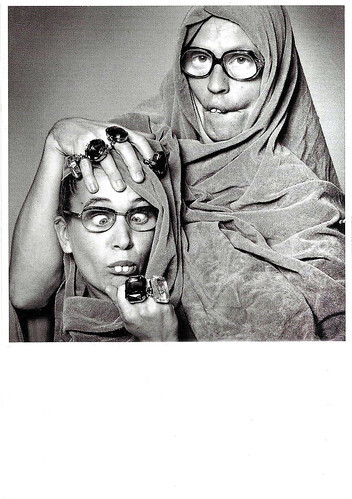
Dutch postcard by Art Unlimited, Amsterdam, no. B 1198. Photo: Erwin Olaf, 1987. Caption: Theo & Thea 'Fashion'.
Cinderella's stepmother
In 2001, Arjan Ederveen starred in a spin-off of 30 minuten, 25 minuten / 25 Minutes (Pieter Kramer, 2001), which was more absurd in its mockumentary style. In 2004, he wrote and acted in the VPRO television series De Troubabroers (Pieter Kramer, 2004), together with Alex Klaasen. The following year, he made the garden show Wroeten / Rooting (Lernert Engelberts, 2005).
Ederveen also participated in several children's films, including as the choreographer in the musical Ja zuster, nee zuster / Yes Nurse! No Nurse! (Pieter Kramer, 2002) starring Loes Luca, chemist Geelman in Pietje Bell / Peter Bell (Maria Peters, 2002), Mr. Pen and his brother, a hermit, in Pluk van de Petteflet / Puffin's Pluck (Ben Sombogaart, Pieter van Rijn, 2004) and Professor Lupardi in Kapitein Rob en het Geheim van Professor Lupardi / Captain Rob and the secret of Professor Lupardi (Hans Pos, 2007) with Thijs Römer and Katja Schuurman .
In 2010 he was a recurring panel member in the YV game show Wie van de drie? / To Tell the Truth. Besides his television and film work, Ederveen was also active as a stage actor. He performed the role of Cinderella's stepmother in the Ro Theater's show 'Lang en Gelukkig', which was also filmed as Lang & Gelukkig / Happily Ever After (Pieter Kramer, 2010). He played Fabio, the right-hand man of the Greek goddess Hera, in 'Hera, de goddelijke musical' (Hera, the Divine Musical) (2008-2009). In 2009, he starred with Jack Wouterse at the Ro Theatre in the play 'Tocht' (Journey), an Easter play he wrote himself.
In the 2009/2010 season, he performed the role of Edna Turnblad in the musical 'Hairspray'. In the 2010/2011 season, he wrote and starred in the Ro Theatre's play 'Moord in de Kerststal' (Murder in the Nativity Scene). In 2018, he played the role of Pontius Pilate in The Passion (David Grifhorst, 2018). As a voice actor, Ederveen provided the voice of Rex in the Dutch version of Toy Story (John Lasseter, 1995) and the sequels. He also dubbed Gonzo in The Muppets (James Bobin, 2011) and Muppets Most Wanted (James Bobin, 2014) as well as Vlad in Hotel Transylvania 2 (Genndy Tartakovsky, 2015) and Hotel Transylvania 3 (Genndy Tartakovsky, 2018).
Ederveen played Doctor Feelgood in My Foolish Heart (Rolf van Eijk, 2018) about the mysterious demise of jazz icon Chet Baker and he was James in the comedy Bon Bini: Judeska in da House (Jonathan Herman, 2020) starring Jandino Asporaat. Last year, Arjan Ederveen appeared in the television show The Masked Singer. He also played the role of Ebenezer Scrooge in Scrooge Live (David Grifhorst, 2024). This year, he appeared in the American film Jimpa (Sophie Hyde, 2025) starring John Lithgow and Olivia Coleman. The film is a celebration of LGBTQI+ culture. Arjan Ederveen is openly gay and has an American husband, Howie. In 2025, his biography 'Altijd van je af' (Always away from you) by Sara Berkeljon was published.
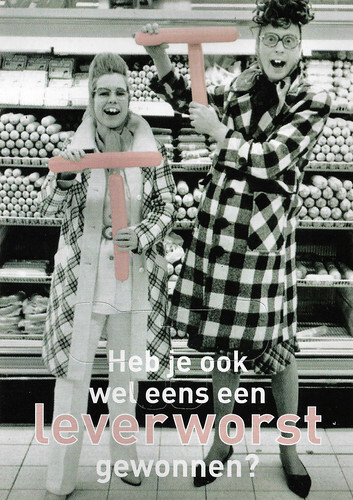
Dutch freecard by Boomerang, no. P 20-09. Photo: VPRO. Arjan Ederveen and Tosca Niterink as Theo & Thea. Caption: Have you ever won liverwurst too? Card to promote the Theo & Thea TV marathon on 3 October 2009.
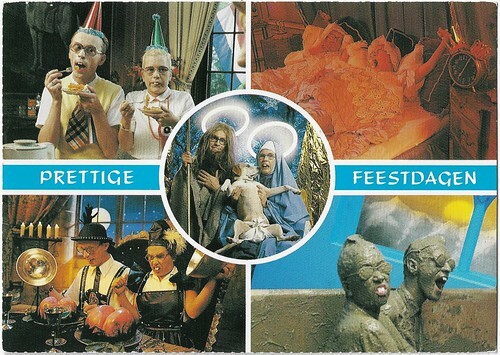
Dutch postcard by Van den beginne BV. Caption: 'Happy Holidays'. Arjan Ederveen and Tosca Niterink as Theo & Thea in Theo en Thea en de Ontmaskering van het Tenenkaasimperium / Theo and Thea and the Unmasking of the Toe Cheese Empire (Pieter Kramer, 1989).
Sources: Theater.nl (Dutch), Wikipedia (Dutch and English) and .

Dutch postcard by Art Unlimited, Amsterdam / Van den Beginne BV, no. C3134. Photo: Benno de Wilde. Arjan Ederveen and Tosca Niterink as Theo & Thea in Theo en Thea en de Ontmaskering van het Tenenkaasimperium / Theo and Thea and the Unmasking of the Toe Cheese Empire (Pieter Kramer, 1989).

Dutch postcard by Theaterbureau Vice Versa, Amsterdam. Photo: Peter Gramberg. Arjan Ederveen and Kees Prins as De Duo's.

Dutch postcard by Rubinstein. Stijn Westenend and Arjan Ederveen in Pietje Bell / Peter Bell (Maria Peters, 2002).
A whole generation remembers the duo with the big front teeth
Arjan Ederveen Janssen was born in 1956 in Hilversum, The Netherlands. His mother, Greetje van Schaik, was an actress, who appeared in the popular Dutch radio show 'De bonte dinsdagavondtrein'. He had two brothers, who both died young, respectively of AIDS and a rare blood disease. Ederveen did his high school education at Comenius College in Hilversum. During a school project, he made his first film, Appel aan de Stok: De Musical (1971). With this film, he won a local film competition.
Ederveen studied at the Academie voor Kleinkunst in Amsterdam where he met fellow student Kees Prins. After graduating, they started their career together as The Duos. Between 1981 and 1984, they created four theatre performances and the television programme De Duo's doen alsof / The Duos Are Pretending. Ederveen made his screen debut in the German Werktheater production Waldeslust / Bosch en Lucht (Friedrich Schaller, 1981) with Joop Admiraal and Kees Prins. He also appeared in two Dutch films, the Virginia Woolf adaptation Golven / Waves (Annette Apon, 1981) and another Werktheater production, Een zwoele zomeravond / A Hot Summer Night (Frans Weisz, Shireen Strooker, 1982) with Gerard Thoolen. He also played a bellboy in the American comedy Still Smokin' (Tommy Chong, 1983) in which Cheech and Chong fly to the marijuana capital of the world, Amsterdam.
Together with Tosca Niterink, Ederveen formed a new TV duo Theo & Thea (Robert Wiering, Pieter Kramer, 1985-1989), a brother and sister with plastic rabbit teeth and thick glasses. The characters became hugely famous in The Netherlands and a whole generation remembers the duo with the big front teeth. In the biography 'Altijd van je af' (Always away from you, 2025), Arjan Ederveen describes the duo: "They are pathetic little children, misfits. Wishy-washy kids. Kids who get bullied. Theo was exactly like I was myself."
Although Theo & Thea was a children's programme, it also became popular among students. Incidentally, the programme was criticised for its adult themes, such as drugs, sexual harassment and prostitution. Theo and Thea returned in the film Theo en Thea en de Ontmaskering van het Tenenkaasimperium / Theo and Thea and the Unmasking of the Toe Cheese Empire (Pieter Kramer, 1989) with Adèle Bloemendaal and Marco Bakker. Other features in which Ederveen appeared were Everybody Wants to Help Ernest (Alejandro Agresti, 1991) and Filmpje! (Paul Ruven, 1995) starring Paul de Leeuw.
In the 1990s Ederveen made the mockumentary TV series Kreatief met Kurk / Creative with Cork (Pieter Kramer, 1993-1994), 30 minuten / 30 Minutes (Pieter Kramer, 1995-1997) and Borreltijd / Schnaps Time (Pieter Kramer, 1996), in which he also played recurring roles. All his shows were critically praised. Especially 30 minuten, a stylistic satire of documentaries and reality television, earned Ederveen and director Pieter Kramer several awards, including the Zilveren Nipkowschijf (Silver Nipkow Disk) and a Gouden Kalf (Golden Calf). The title refers to its half-hour length and was inspired by the BBC documentary series Sixty Minutes. The series was filmed in a mockumentary style with tragicomic undertones.

Dutch postcard by Art Unlimited, Amsterdam, no. C 2884. Photo: Erwin Olaf, 1986. Caption: Theo & Thea 'Happy Birthday'. Arjan Ederveen and Tosca Niterink as Theo & Thea.

Dutch postcard by Art Unlimited, Amsterdam, no. B 1198. Photo: Erwin Olaf, 1987. Caption: Theo & Thea 'Fashion'.
Cinderella's stepmother
In 2001, Arjan Ederveen starred in a spin-off of 30 minuten, 25 minuten / 25 Minutes (Pieter Kramer, 2001), which was more absurd in its mockumentary style. In 2004, he wrote and acted in the VPRO television series De Troubabroers (Pieter Kramer, 2004), together with Alex Klaasen. The following year, he made the garden show Wroeten / Rooting (Lernert Engelberts, 2005).
Ederveen also participated in several children's films, including as the choreographer in the musical Ja zuster, nee zuster / Yes Nurse! No Nurse! (Pieter Kramer, 2002) starring Loes Luca, chemist Geelman in Pietje Bell / Peter Bell (Maria Peters, 2002), Mr. Pen and his brother, a hermit, in Pluk van de Petteflet / Puffin's Pluck (Ben Sombogaart, Pieter van Rijn, 2004) and Professor Lupardi in Kapitein Rob en het Geheim van Professor Lupardi / Captain Rob and the secret of Professor Lupardi (Hans Pos, 2007) with Thijs Römer and Katja Schuurman .
In 2010 he was a recurring panel member in the YV game show Wie van de drie? / To Tell the Truth. Besides his television and film work, Ederveen was also active as a stage actor. He performed the role of Cinderella's stepmother in the Ro Theater's show 'Lang en Gelukkig', which was also filmed as Lang & Gelukkig / Happily Ever After (Pieter Kramer, 2010). He played Fabio, the right-hand man of the Greek goddess Hera, in 'Hera, de goddelijke musical' (Hera, the Divine Musical) (2008-2009). In 2009, he starred with Jack Wouterse at the Ro Theatre in the play 'Tocht' (Journey), an Easter play he wrote himself.
In the 2009/2010 season, he performed the role of Edna Turnblad in the musical 'Hairspray'. In the 2010/2011 season, he wrote and starred in the Ro Theatre's play 'Moord in de Kerststal' (Murder in the Nativity Scene). In 2018, he played the role of Pontius Pilate in The Passion (David Grifhorst, 2018). As a voice actor, Ederveen provided the voice of Rex in the Dutch version of Toy Story (John Lasseter, 1995) and the sequels. He also dubbed Gonzo in The Muppets (James Bobin, 2011) and Muppets Most Wanted (James Bobin, 2014) as well as Vlad in Hotel Transylvania 2 (Genndy Tartakovsky, 2015) and Hotel Transylvania 3 (Genndy Tartakovsky, 2018).
Ederveen played Doctor Feelgood in My Foolish Heart (Rolf van Eijk, 2018) about the mysterious demise of jazz icon Chet Baker and he was James in the comedy Bon Bini: Judeska in da House (Jonathan Herman, 2020) starring Jandino Asporaat. Last year, Arjan Ederveen appeared in the television show The Masked Singer. He also played the role of Ebenezer Scrooge in Scrooge Live (David Grifhorst, 2024). This year, he appeared in the American film Jimpa (Sophie Hyde, 2025) starring John Lithgow and Olivia Coleman. The film is a celebration of LGBTQI+ culture. Arjan Ederveen is openly gay and has an American husband, Howie. In 2025, his biography 'Altijd van je af' (Always away from you) by Sara Berkeljon was published.

Dutch freecard by Boomerang, no. P 20-09. Photo: VPRO. Arjan Ederveen and Tosca Niterink as Theo & Thea. Caption: Have you ever won liverwurst too? Card to promote the Theo & Thea TV marathon on 3 October 2009.

Dutch postcard by Van den beginne BV. Caption: 'Happy Holidays'. Arjan Ederveen and Tosca Niterink as Theo & Thea in Theo en Thea en de Ontmaskering van het Tenenkaasimperium / Theo and Thea and the Unmasking of the Toe Cheese Empire (Pieter Kramer, 1989).
Sources: Theater.nl (Dutch), Wikipedia (Dutch and English) and .
Published on June 07, 2025 22:00
June 6, 2025
A gift by Añelo de la Krotsche
We got a special mail from France. A connection at Flickr, Añelo de la Krotsche, told us he discovered our work and liked it. During the 1980s, he used to try to meet French actresses for a signature.He got pictures, signed by Catherine Deneuve, Nathalie Baye, Annie Duperey and Jane Birkin. Isabelle Adjani also sent him a photo with a printed signature. Añelo is not a collector; these photos were just 'sleeping on the bottom of a drawer'. So he would like to send them to us as a gift. But I was busy and did not notice his Flickr mail...
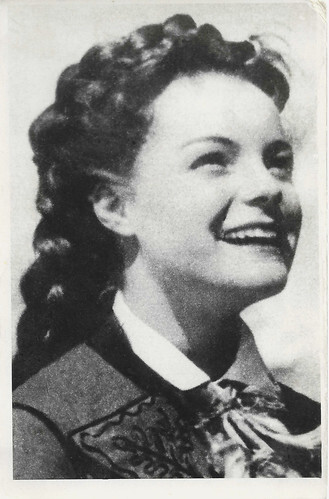
Vintage photo.
Romy Schneider (1938-1982) was one of the most beautiful and intelligent actors of her generation. More than 40 years after her death, she still has an immense popular appeal.
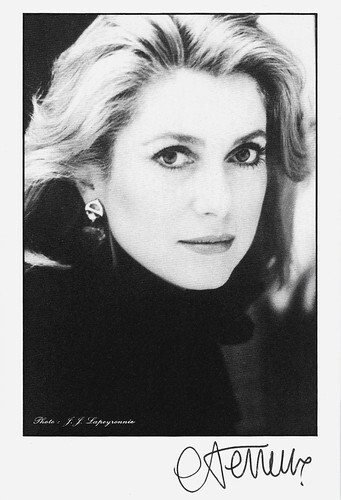
Vintage autograph card. Photo: J.J. Lapeyronnie.
Elegant Catherine Deneuve (1943) is an icon of French cinema who has graced the screen for more than five decades. She gained recognition in the 1960s for her portrayal of cool, mysterious beauties in classic films by directors like Luis Buñuel, Roman Polanski and François Truffaut. Apart from being a great actress, she is also an archetype for Gallic Beauty. From 1985 to 1989, she succeeded Brigitte Bardot as the model for the national symbol Marianne, seen on French coins and stamps.
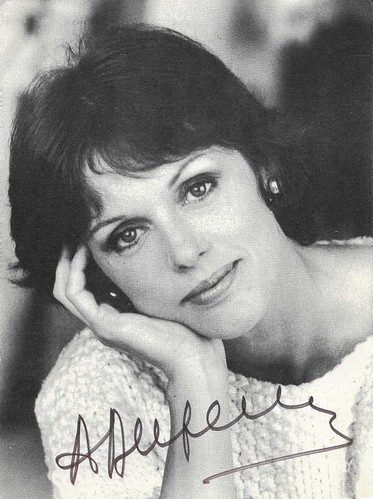
French autograph card.
French actress Anny Duperey (1947) is known for her stage, film and television roles, but she is also a best-selling author. Duperey is a Chevalier of the Légion d'honneur.
Sharing forgotten pictures, sleeping on the bottom of a drawer
It was very rude of me. And when I finally discovered Añelo de la Krotsche's mail, I apologised immediately. I wrote him a bit about Truus, Bob and Jan Too! and EFSP and the people behind it. And thanked him for his very kind offer. He was, of course, welcome to send his cards to us, very welcome.
When he read my message, Añelo remembered that in the early 1980s, he had a friend in Austria, whose mother used to be friends with Magda and Romy Schneider in the 1950s, and who had many original photos of them. Back at the time, she gave him one of these original photos of Romy. He promised to send me that one as well. "It took me more than an hour to find it, as all my old photos and postcards are in boxes, and I never watched them in 25 years or more, so I don't really need them anymore."
Searching for this photo he also found some film-related postcards: several from A bout de souffle by Godard with Belmondo and Jean Seberg , but also cards with portraits of James Dean , Marilyn Monroe and David Bennent, and poster cards of La Pirate by Doillon with Jane Birkin, Kika by Almodóvar, and Witness with Harrison Ford : "I didn't even remember having these postcards."
Añelo liked to read that Ivo and I both have worked for Eye Filmmuseum: "I know the modern building of Eye very well, I often went for walks in the area during 2011 and 2015. Some of my best memories remain in Amsterdam.I love cinema very much too, but don't have your knowledge about its history, especially when it comes to the cinema of the 1920s, 1930s or 1940s. My three favourite directors (in very different styles) are Luchino Visconti , Ingmar Bergman and Theo Angelopoulos. It is almost an extraordinary coincidence that Ivo is the author of one of the books on Visconti that I have in my library. I have all their movies, and have watched them all many times. I also love other directors of whom I have almost all their films: Hitchcock, Almodóvar, Aleksandar Petrović, Tarkovsky and some others..."
So I proposed to Añelo a guest post on EFSP. Añelo: "I don't have much to say about the actresses who signed a picture, all I can say is that they were all very friendly and nice, but there are no other anecdotes I could talk about. Or I could only explain that sharing these pictures allows them to come out from the 'bottom of a drawer' where they were forgotten, and the fact that I like to pass things on." Here is the result.
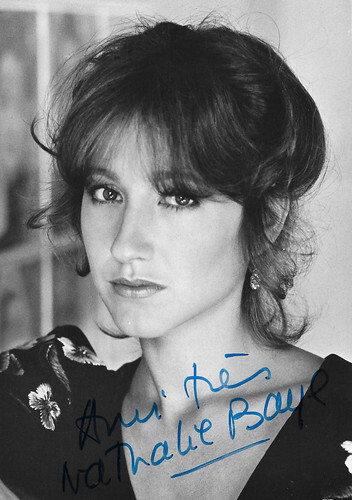
French autograph card by Editions P.I., Paris. Photo: Sygma.
French film, television, and stage actress Nathalie Baye (1948) began her career in 1970 and has appeared in more than 80 films. She has won more than ten acting awards, including the Volpi Cup at the Venice Film Festival for Une liaison pornographique (1999). Baye won four Césars, for Sauve qui peut (la vie) (1980), Une étrange affaire (1981), La Balance (1982) and Le petit lieutenant (2005).
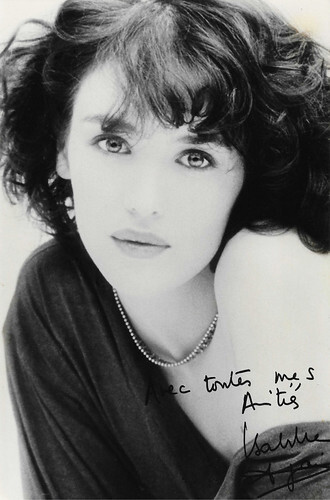
French autograph card.
Isabelle Adjani (1955) is a dark-haired beauty with porcelain skin and expressive blue eyes, who has appeared in nearly 50 films since 1970. The French film actress holds the record for most César Awards for Best Actress with five, for Possession (1981), L'Été Meurtrier / One Deadly Summer (1983), Camille Claudel (1988), La Reine Margot / Queen Margot (1994) and La journée de la jupe / Skirt Day (2009). She also received two Oscar nominations for Best Actress.

French postcard. Photo: Phonogram / Raymond Bounon. Publicity still for the record 'Baby alone in Baylone' (1983).
In the Swinging Sixties, shy, awkward-looking British actress Jane Birkin (1946-2023) made a huge international splash as one of the nude models in Antonioni's Blow-Up (1966). In France, she became the muse of singer-songwriter Serge Gainsbourg, who wrote several of her albums, plus their explicitly erotic duet 'Je t'aime... moi non plus'. Later, she worked with such respected film directors as Jacques Rivette, Agnès Varda and Jacques Doillon, and won several acting awards.
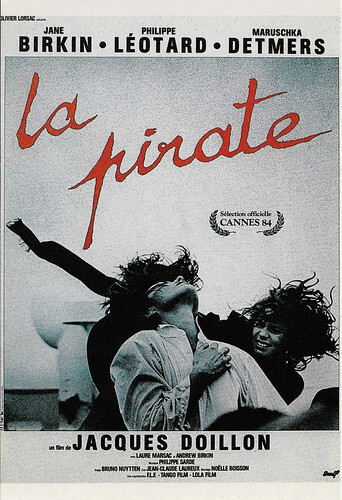
French poster postcard by SEDII, no. C 7. Image: A.M.L.F. French poster for La Pirate / The Pirate (Jacques Doillon, 1984) with Jane Birkin and Maruschka Detmers .
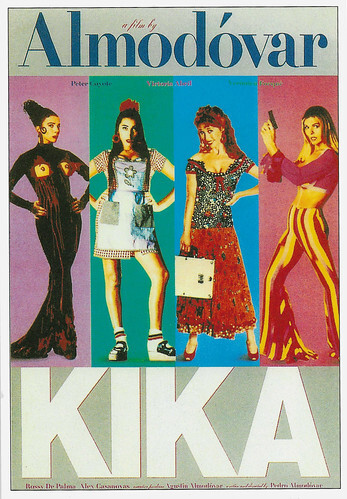
French postcard by Encyclopédie du Cinéma, no. EDC 909. Image: S.U.B. P.O.P. / October Films. English poster for Kika (Pedro Almodóvar, 1993) with Victoria Abril, Veronica Forqué and Rossy De Palma.
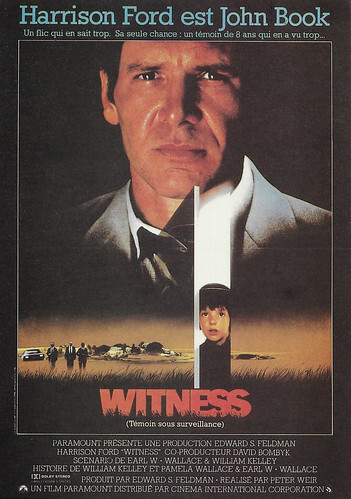
French postcard by Editions F. Nugeron, no. 248. Image: Paramount / Cinema International Corporation. French poster for Witness (Peter Weir, 1985) with Harrison Ford . The French title is Témoin sous surveillance.
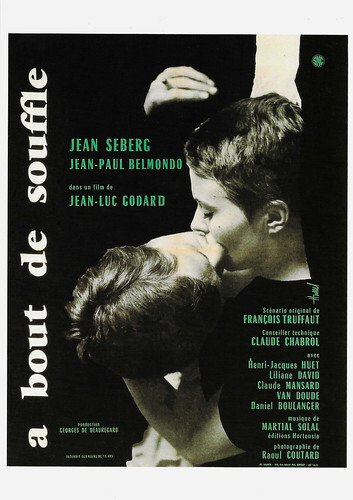
Swiss postcard by CVB Publishers, no. 57122. Image: Clément Hurel / Collection Cinémathèque Suisse Lausanne. French poster for A bout de souffle / Breathless (Jean-Luc Godard, 1960).
In 1959, Jean-Luc Godard directed his first feature film, À bout de souffle / Breathless (1960), based on a screenplay by François Truffaut . This film played a key role in the birth of the Nouvelle Vague. It broke with many then prevailing conventions, with its references, influences from the American (gangster) film, the low budget, and the rough editing. Jean-Paul Belmondo and Jean Seberg starred, and the film was a huge success with audiences and critics. Godard won the Silver Bear for this film at the Berlin Film Festival in 1960. Jean Seberg was nominated for a BAFTA Award.
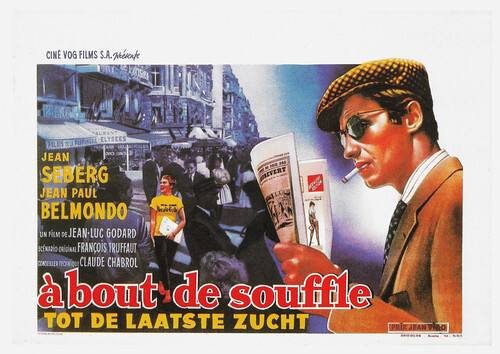
Swiss postcard by CVB Publishers, no. 57138. Image: Ciné Vog Films / News Productions / Collection Cinémathèque Suisse Lausanne. Belgian poster for A bout de souffle / Breathless (Jean-Luc Godard, 1960). The Flemish title is Tot de laatste zucht.
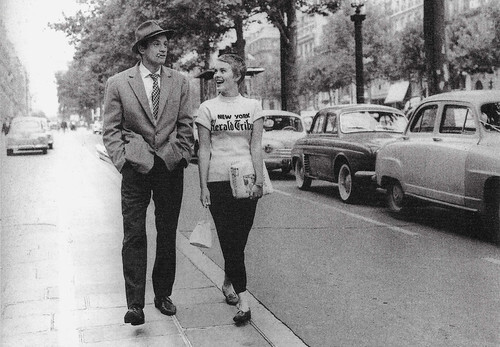
French postcard by Editions Art & Scene, 1996, no. CF 63. Photo: Raymond Cauchetier. Jean-Paul Belmondo and Jean Seberg in A bout de souffle / Breathless (Jean-Luc Godard, 1960).
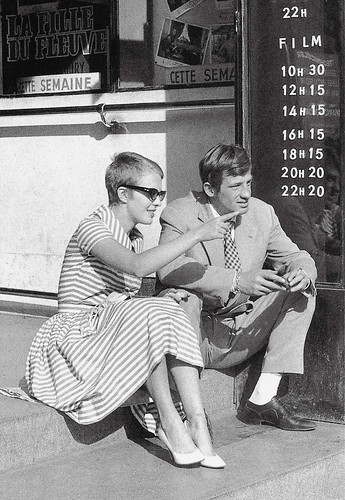
French postcard by Editions Art & Scene, 1996, no. CF 84. Photo: Raymond Cauchetier. Jean Seberg and Jean-Paul Belmondo in A bout de souffle / Breathless (Jean-Luc Godard, 1960).
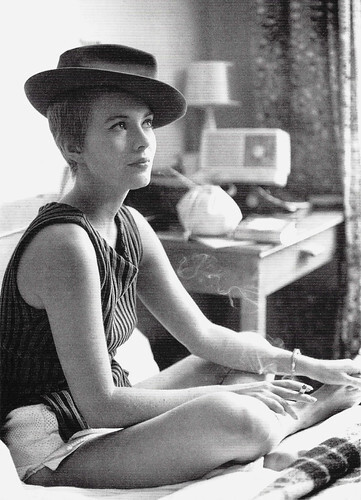
French postcard by Editions Art & Scene, 1996, no. CF 85. Photo: Raymond Cauchetier. Jean Seberg in A bout de souffle / Breathless (Jean-Luc Godard, 1960).
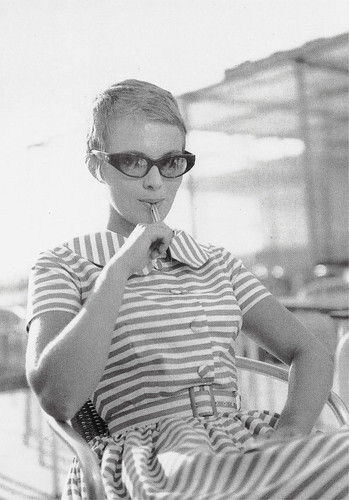
French postcard by Editions Art & Scene, Paris, 1996, no. CF 106. Photo: Raymond Cauchetier. Jean Seberg in A bout de souffle / Breathless (Jean-Luc Godard, 1960).
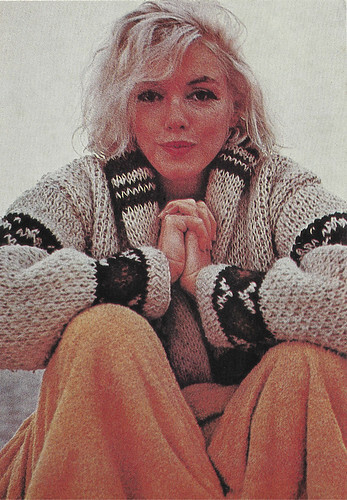
French postcard by Editions F. Nugeron, no. Star 46. Photo: George Barris. Marilyn Monroe on Santa Monica Beach in July 1962. Marilyn wears a handmade knit cardigan she purchased from Mexico.
By 1953, Marilyn Monroe (1926-1962) was one of the most marketable Hollywood stars, with leading roles in three films: the Film Noir Niagara, which focused on her sex appeal, and the comedies Gentlemen Prefer Blondes and How to Marry a Millionaire, which established her star image as a "dumb blonde". Although she played a significant role in the creation and management of her public image throughout her career, she was disappointed at being typecast and underpaid by the studio. She was briefly suspended in early 1954 for refusing a film project, but returned to star in one of the biggest box office successes of her career, The Seven Year Itch (1955).
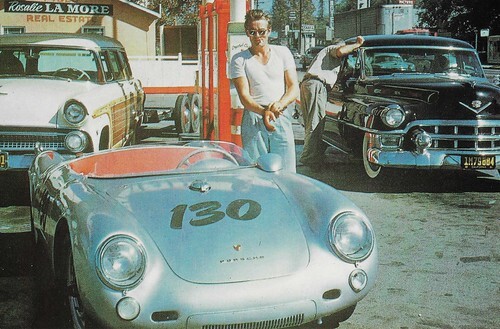
Belgian postcard by Edition Atom.
American actor James Dean (1931-1955) was the quintessential 1950s teenager, brooding and romantic. An air of androgyny is attributed to his iconic appeal to both men and women. The three roles that defined his stardom are as troubled teenager Jim Stark in Rebel Without a Cause (1955), loner Cal Trask in East of Eden (1955) and surly Ranch hand Jett Rink in Giant (1956). After he died in a car crash, the 24-year-old Dean became the first actor to receive a posthumous Academy Award nomination for Best Actor.
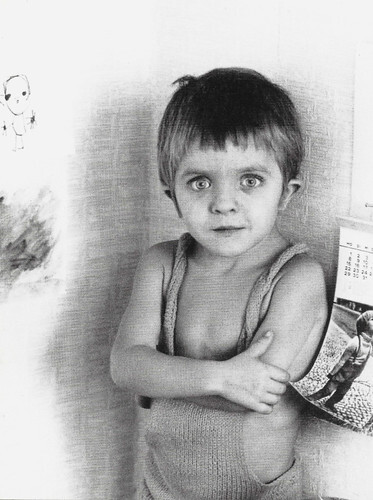
West German postcard by Gebr. König Postkartenverlag, Köln, no. D 129. Photo: Roswitha Hecke. Caption: David Bennent, Berlin, 1968.
David Bennent (1966) is a Swiss actor who appeared in numerous theatre plays and films for cinema and television. He is best known for his role as Oskar Matzerath in Volker Schlöndorff's Oscar-winning film The Tin Drum (1979), an adaptation of Günter Grass' novel. Añelo: "As for David Bennent's card, I found it in Paris. I don't even remember when, probably in the 1990s. He's an actor I really like, and there's actually a funny anecdote about him and my username on Flickr. In the beautiful film Canicule / Heatwave by Yves Boisset (a dark thriller), David Bennent plays a humorous character. In a rather dark murder scene, he is asked his name and he answers "Anielo Dellacroce". I thought he had invented this strange name, and I wrote it as I heard it with his German accent, and the name seemed funny to me. I had the impression that it was a mixture of Spanish, a particle of nobility in French and a German name. I took this phonetic transcription of the name, Añelo de la Krotsche. Contacts on Flickr later told me that their friends claimed it couldn't possibly be my real name. And my sister's partner asked me, much later, why I had chosen that name as my username on Flickr. I didn't understand the reason for all the questions about this alias. And then I discovered by chance that Anielo Dellacroce is a real person, who used to be a member of the mafia. I was obviously surprised. I feel completely at odds with everything the mafia represents, and as far as cinema goes, films that evoke the mafia don't interest me either. But I kept my Flickr username because I still find it amusing with its mixture of three languages, the way I wrote it, and it's a sort of nod to David Bennent's character in Canicule.
Merçi beaucoup, Añelo! Many thanks for this extraordinary gift and your contribution to European Film Star Postcards.

Vintage photo.
Romy Schneider (1938-1982) was one of the most beautiful and intelligent actors of her generation. More than 40 years after her death, she still has an immense popular appeal.

Vintage autograph card. Photo: J.J. Lapeyronnie.
Elegant Catherine Deneuve (1943) is an icon of French cinema who has graced the screen for more than five decades. She gained recognition in the 1960s for her portrayal of cool, mysterious beauties in classic films by directors like Luis Buñuel, Roman Polanski and François Truffaut. Apart from being a great actress, she is also an archetype for Gallic Beauty. From 1985 to 1989, she succeeded Brigitte Bardot as the model for the national symbol Marianne, seen on French coins and stamps.

French autograph card.
French actress Anny Duperey (1947) is known for her stage, film and television roles, but she is also a best-selling author. Duperey is a Chevalier of the Légion d'honneur.
Sharing forgotten pictures, sleeping on the bottom of a drawer
It was very rude of me. And when I finally discovered Añelo de la Krotsche's mail, I apologised immediately. I wrote him a bit about Truus, Bob and Jan Too! and EFSP and the people behind it. And thanked him for his very kind offer. He was, of course, welcome to send his cards to us, very welcome.
When he read my message, Añelo remembered that in the early 1980s, he had a friend in Austria, whose mother used to be friends with Magda and Romy Schneider in the 1950s, and who had many original photos of them. Back at the time, she gave him one of these original photos of Romy. He promised to send me that one as well. "It took me more than an hour to find it, as all my old photos and postcards are in boxes, and I never watched them in 25 years or more, so I don't really need them anymore."
Searching for this photo he also found some film-related postcards: several from A bout de souffle by Godard with Belmondo and Jean Seberg , but also cards with portraits of James Dean , Marilyn Monroe and David Bennent, and poster cards of La Pirate by Doillon with Jane Birkin, Kika by Almodóvar, and Witness with Harrison Ford : "I didn't even remember having these postcards."
Añelo liked to read that Ivo and I both have worked for Eye Filmmuseum: "I know the modern building of Eye very well, I often went for walks in the area during 2011 and 2015. Some of my best memories remain in Amsterdam.I love cinema very much too, but don't have your knowledge about its history, especially when it comes to the cinema of the 1920s, 1930s or 1940s. My three favourite directors (in very different styles) are Luchino Visconti , Ingmar Bergman and Theo Angelopoulos. It is almost an extraordinary coincidence that Ivo is the author of one of the books on Visconti that I have in my library. I have all their movies, and have watched them all many times. I also love other directors of whom I have almost all their films: Hitchcock, Almodóvar, Aleksandar Petrović, Tarkovsky and some others..."
So I proposed to Añelo a guest post on EFSP. Añelo: "I don't have much to say about the actresses who signed a picture, all I can say is that they were all very friendly and nice, but there are no other anecdotes I could talk about. Or I could only explain that sharing these pictures allows them to come out from the 'bottom of a drawer' where they were forgotten, and the fact that I like to pass things on." Here is the result.

French autograph card by Editions P.I., Paris. Photo: Sygma.
French film, television, and stage actress Nathalie Baye (1948) began her career in 1970 and has appeared in more than 80 films. She has won more than ten acting awards, including the Volpi Cup at the Venice Film Festival for Une liaison pornographique (1999). Baye won four Césars, for Sauve qui peut (la vie) (1980), Une étrange affaire (1981), La Balance (1982) and Le petit lieutenant (2005).

French autograph card.
Isabelle Adjani (1955) is a dark-haired beauty with porcelain skin and expressive blue eyes, who has appeared in nearly 50 films since 1970. The French film actress holds the record for most César Awards for Best Actress with five, for Possession (1981), L'Été Meurtrier / One Deadly Summer (1983), Camille Claudel (1988), La Reine Margot / Queen Margot (1994) and La journée de la jupe / Skirt Day (2009). She also received two Oscar nominations for Best Actress.

French postcard. Photo: Phonogram / Raymond Bounon. Publicity still for the record 'Baby alone in Baylone' (1983).
In the Swinging Sixties, shy, awkward-looking British actress Jane Birkin (1946-2023) made a huge international splash as one of the nude models in Antonioni's Blow-Up (1966). In France, she became the muse of singer-songwriter Serge Gainsbourg, who wrote several of her albums, plus their explicitly erotic duet 'Je t'aime... moi non plus'. Later, she worked with such respected film directors as Jacques Rivette, Agnès Varda and Jacques Doillon, and won several acting awards.

French poster postcard by SEDII, no. C 7. Image: A.M.L.F. French poster for La Pirate / The Pirate (Jacques Doillon, 1984) with Jane Birkin and Maruschka Detmers .

French postcard by Encyclopédie du Cinéma, no. EDC 909. Image: S.U.B. P.O.P. / October Films. English poster for Kika (Pedro Almodóvar, 1993) with Victoria Abril, Veronica Forqué and Rossy De Palma.

French postcard by Editions F. Nugeron, no. 248. Image: Paramount / Cinema International Corporation. French poster for Witness (Peter Weir, 1985) with Harrison Ford . The French title is Témoin sous surveillance.

Swiss postcard by CVB Publishers, no. 57122. Image: Clément Hurel / Collection Cinémathèque Suisse Lausanne. French poster for A bout de souffle / Breathless (Jean-Luc Godard, 1960).
In 1959, Jean-Luc Godard directed his first feature film, À bout de souffle / Breathless (1960), based on a screenplay by François Truffaut . This film played a key role in the birth of the Nouvelle Vague. It broke with many then prevailing conventions, with its references, influences from the American (gangster) film, the low budget, and the rough editing. Jean-Paul Belmondo and Jean Seberg starred, and the film was a huge success with audiences and critics. Godard won the Silver Bear for this film at the Berlin Film Festival in 1960. Jean Seberg was nominated for a BAFTA Award.

Swiss postcard by CVB Publishers, no. 57138. Image: Ciné Vog Films / News Productions / Collection Cinémathèque Suisse Lausanne. Belgian poster for A bout de souffle / Breathless (Jean-Luc Godard, 1960). The Flemish title is Tot de laatste zucht.

French postcard by Editions Art & Scene, 1996, no. CF 63. Photo: Raymond Cauchetier. Jean-Paul Belmondo and Jean Seberg in A bout de souffle / Breathless (Jean-Luc Godard, 1960).

French postcard by Editions Art & Scene, 1996, no. CF 84. Photo: Raymond Cauchetier. Jean Seberg and Jean-Paul Belmondo in A bout de souffle / Breathless (Jean-Luc Godard, 1960).

French postcard by Editions Art & Scene, 1996, no. CF 85. Photo: Raymond Cauchetier. Jean Seberg in A bout de souffle / Breathless (Jean-Luc Godard, 1960).

French postcard by Editions Art & Scene, Paris, 1996, no. CF 106. Photo: Raymond Cauchetier. Jean Seberg in A bout de souffle / Breathless (Jean-Luc Godard, 1960).

French postcard by Editions F. Nugeron, no. Star 46. Photo: George Barris. Marilyn Monroe on Santa Monica Beach in July 1962. Marilyn wears a handmade knit cardigan she purchased from Mexico.
By 1953, Marilyn Monroe (1926-1962) was one of the most marketable Hollywood stars, with leading roles in three films: the Film Noir Niagara, which focused on her sex appeal, and the comedies Gentlemen Prefer Blondes and How to Marry a Millionaire, which established her star image as a "dumb blonde". Although she played a significant role in the creation and management of her public image throughout her career, she was disappointed at being typecast and underpaid by the studio. She was briefly suspended in early 1954 for refusing a film project, but returned to star in one of the biggest box office successes of her career, The Seven Year Itch (1955).

Belgian postcard by Edition Atom.
American actor James Dean (1931-1955) was the quintessential 1950s teenager, brooding and romantic. An air of androgyny is attributed to his iconic appeal to both men and women. The three roles that defined his stardom are as troubled teenager Jim Stark in Rebel Without a Cause (1955), loner Cal Trask in East of Eden (1955) and surly Ranch hand Jett Rink in Giant (1956). After he died in a car crash, the 24-year-old Dean became the first actor to receive a posthumous Academy Award nomination for Best Actor.

West German postcard by Gebr. König Postkartenverlag, Köln, no. D 129. Photo: Roswitha Hecke. Caption: David Bennent, Berlin, 1968.
David Bennent (1966) is a Swiss actor who appeared in numerous theatre plays and films for cinema and television. He is best known for his role as Oskar Matzerath in Volker Schlöndorff's Oscar-winning film The Tin Drum (1979), an adaptation of Günter Grass' novel. Añelo: "As for David Bennent's card, I found it in Paris. I don't even remember when, probably in the 1990s. He's an actor I really like, and there's actually a funny anecdote about him and my username on Flickr. In the beautiful film Canicule / Heatwave by Yves Boisset (a dark thriller), David Bennent plays a humorous character. In a rather dark murder scene, he is asked his name and he answers "Anielo Dellacroce". I thought he had invented this strange name, and I wrote it as I heard it with his German accent, and the name seemed funny to me. I had the impression that it was a mixture of Spanish, a particle of nobility in French and a German name. I took this phonetic transcription of the name, Añelo de la Krotsche. Contacts on Flickr later told me that their friends claimed it couldn't possibly be my real name. And my sister's partner asked me, much later, why I had chosen that name as my username on Flickr. I didn't understand the reason for all the questions about this alias. And then I discovered by chance that Anielo Dellacroce is a real person, who used to be a member of the mafia. I was obviously surprised. I feel completely at odds with everything the mafia represents, and as far as cinema goes, films that evoke the mafia don't interest me either. But I kept my Flickr username because I still find it amusing with its mixture of three languages, the way I wrote it, and it's a sort of nod to David Bennent's character in Canicule.
Merçi beaucoup, Añelo! Many thanks for this extraordinary gift and your contribution to European Film Star Postcards.
Published on June 06, 2025 22:00
June 5, 2025
Jan Sterling
Ash-blonde American stage, film and television actress Jan Sterling (1921-2004) was most active in films during the 1950s. She received a Golden Globe Award for Best Supporting Actress for her performance in The High and the Mighty (1954) and was nominated for an Academy Award for Best Supporting Actress for the same performance. Her best performance is probably the sluttish, opportunistic wife of Kirk Douglas in Billy Wilder's Ace in the Hole (1951). Although her career declined during the 1960s, she continued to play occasional television and theatre roles.
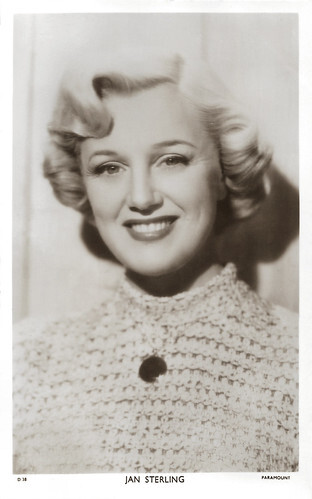
British postcard in the Picturegoer Series, London, no. D 38. Photo: Paramount.
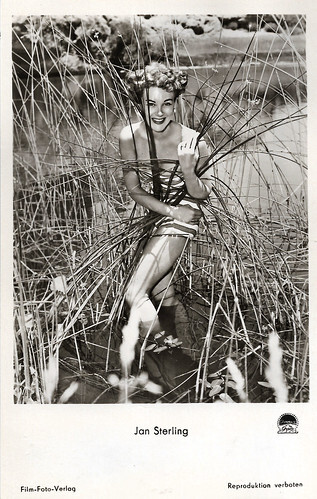
German postcard by Film-Foto-Verlag, Berlin-Tempelhof, no. FK 308. Photo: Paramount. Publicity still for Pony Express (Jerry Hopper, 1953).
Dominating Broadway as a proper British lady
Jan Sterling was born Jane Sterling Adriance in Manhattan, New York, in 1921 to a well-to-do family. She had a younger sister, Ann 'Mimi' Adriance, a model and businesswoman. Her father, William Allen Adriance Jr., was a prominent advertising executive who divorced her mother when Jan was only eight. Her mother, Eleanor Ward (née Deans), remarried an oilman when Jan was still a young girl, and the family relocated abroad.
Jan was schooled by private tutors in Brazil and later in London and Paris. Although both sets of parents disapproved, Jan set her sights on acting. Eventually, she was enrolled in Fay Compton's dramatic school in London. She became a strong-minded young woman with a heartfelt passion for the arts.
She returned to Manhattan to conquer Broadway and by the age of 17 had her first ingénue role in 'Bachelor Born' (1938). Over the next 11 years, Jan dominated Broadway as a proper British lady while billing herself as Jane Adrian.
Gary Brumburgh at IMDb : "One of her highlights was working with the legendary Ruth Gordon in 1942 in Gordon's first play, 'Over 21'. In 1941, she married actor John Merivale. The couple divorced in 1947. In 1947, she made her film debut in the romantic drama Tycoon (Richard Wallace, 1947), billed as Jane Darian. As Billie Dawn, she appeared in the Chicago company of 'Born Yesterday'. Columbia brought Jan out to the West Coast to test for the film version, Born Yesterday (George Cukor, 1950). At one point, she was announced to play the part, but the role ultimately went to the character's original player on Broadway, Judy Holliday, who went on to win the Oscar. However, the ash-blonde broke quickly into films, supporting Oscar-winning Jane Wyman in Johnny Belinda (Jean Negulesco, 1948) in a key, emotional role."
Years earlier, in 1941, Jan took over actress Virginia Field's part in the Broadway musical 'Panama Hattie' when Field left the show to marry gruff actor Paul Douglas. By 1950, the marriage between Douglas and Field had ended in divorce, and Paul married Jan.
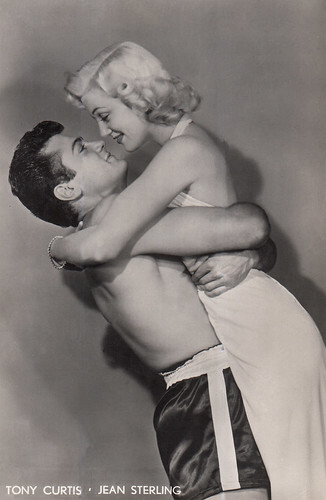
French or Belgian postcard. Jan Sterling and Tony Curtis in Flesh and Fury (Joseph Pevney, 1952). Collection: Marlene Pilaete.
Digging her nails into a florid array of cheap floozies, hard-bitten dames, and lethal schemers
To her absolute delight, Jan Sterling left the docile, ladylike image behind her in Hollywood. She was allowed to dig her nails into a florid array of cheap floozies, hard-bitten dames, and lethal schemers and stood out well with 'bad girl' parts in the films Caged (John Cromwell, 1950) starring Eleonor Parker , the Film Noir Ace in the Hole (Billy Wilder, 1951) opposite Kirk Douglas , Flesh and Fury (Joseph Pevney, 1952) with Tony Curtis , The Human Jungle (Joseph M. Newman, 1954), and Female on the Beach (Joseph Pevney, 1955), starring Joan Crawford and Jeff Chandler .
In between, she occasionally made a nicer, more sympathetic impression in the Western Sky Full of Moon (Norman Foster, 1952) and the adventure film The High and the Mighty (William A. Wellman, 1954) starring John Wayne . The latter earned her an Oscar nomination. In 1955, she gave birth to her only child at age 34, a son, Adams Douglas.
Jan and her husband, Paul Douglas, moved away from the Hollywood scene to Burlington, Vermont. They appeared together professionally on occasional TV shows. Douglas revived his Harry Brock role from 'Born Yesterday' with a stage tour starring Jan in the Billie Dawn part. They were a solid hit. After the sudden death of her 52-year-old husband in 1959, Jan's career slowed down considerably. Douglas suffered a massive heart attack at their Hollywood home.
She refocused on stage and TV but at a slower step. She made incidental films on occasion, including support roles in the romantic comedy Love in a Goldfish Bowl (Jack Sher, 1961) starring Tommy Sands and Fabian and the crime drama The Incident (Larry Peerce, 1967). In 1962, she made her singing debut in a tour of the musical 'Silk Stockings'. She was also involved in humanitarian causes.
In the late 1960s, she moved to London, and in the 1970s, she entered into a relationship with actor Sam Wanamaker. They never married but stayed together until he died in 1993. She played a small part in First Monday in October (Ronald Neame, 1981) starring Walter Matthau. Inactive for nearly two decades, Jan made an appearance at the Cinecon Film Festival in Los Angeles in the fall of 2001. She was still charming audiences at the age of 80. In 2004, she passed away at the Motion Picture and Television Hospital in Woodland Hills, California. Jan Sterling was 82. Her son, Adams Douglas, died of heart failure in December 2003, just three months before she died.
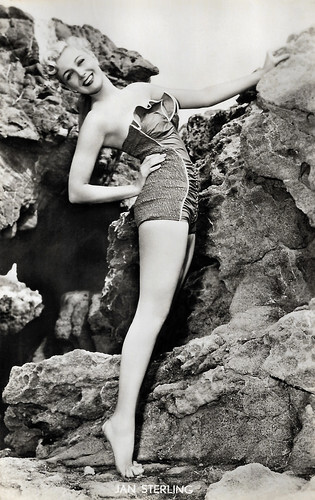
Belgian postcard. Photo: Paramount.
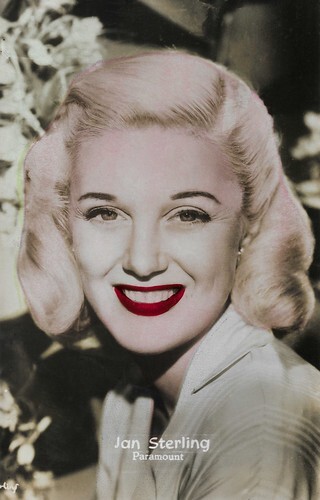
Vintage postcard. Photo: Paramount.
Source: (IMDb), Wikipedia and .

British postcard in the Picturegoer Series, London, no. D 38. Photo: Paramount.

German postcard by Film-Foto-Verlag, Berlin-Tempelhof, no. FK 308. Photo: Paramount. Publicity still for Pony Express (Jerry Hopper, 1953).
Dominating Broadway as a proper British lady
Jan Sterling was born Jane Sterling Adriance in Manhattan, New York, in 1921 to a well-to-do family. She had a younger sister, Ann 'Mimi' Adriance, a model and businesswoman. Her father, William Allen Adriance Jr., was a prominent advertising executive who divorced her mother when Jan was only eight. Her mother, Eleanor Ward (née Deans), remarried an oilman when Jan was still a young girl, and the family relocated abroad.
Jan was schooled by private tutors in Brazil and later in London and Paris. Although both sets of parents disapproved, Jan set her sights on acting. Eventually, she was enrolled in Fay Compton's dramatic school in London. She became a strong-minded young woman with a heartfelt passion for the arts.
She returned to Manhattan to conquer Broadway and by the age of 17 had her first ingénue role in 'Bachelor Born' (1938). Over the next 11 years, Jan dominated Broadway as a proper British lady while billing herself as Jane Adrian.
Gary Brumburgh at IMDb : "One of her highlights was working with the legendary Ruth Gordon in 1942 in Gordon's first play, 'Over 21'. In 1941, she married actor John Merivale. The couple divorced in 1947. In 1947, she made her film debut in the romantic drama Tycoon (Richard Wallace, 1947), billed as Jane Darian. As Billie Dawn, she appeared in the Chicago company of 'Born Yesterday'. Columbia brought Jan out to the West Coast to test for the film version, Born Yesterday (George Cukor, 1950). At one point, she was announced to play the part, but the role ultimately went to the character's original player on Broadway, Judy Holliday, who went on to win the Oscar. However, the ash-blonde broke quickly into films, supporting Oscar-winning Jane Wyman in Johnny Belinda (Jean Negulesco, 1948) in a key, emotional role."
Years earlier, in 1941, Jan took over actress Virginia Field's part in the Broadway musical 'Panama Hattie' when Field left the show to marry gruff actor Paul Douglas. By 1950, the marriage between Douglas and Field had ended in divorce, and Paul married Jan.

French or Belgian postcard. Jan Sterling and Tony Curtis in Flesh and Fury (Joseph Pevney, 1952). Collection: Marlene Pilaete.
Digging her nails into a florid array of cheap floozies, hard-bitten dames, and lethal schemers
To her absolute delight, Jan Sterling left the docile, ladylike image behind her in Hollywood. She was allowed to dig her nails into a florid array of cheap floozies, hard-bitten dames, and lethal schemers and stood out well with 'bad girl' parts in the films Caged (John Cromwell, 1950) starring Eleonor Parker , the Film Noir Ace in the Hole (Billy Wilder, 1951) opposite Kirk Douglas , Flesh and Fury (Joseph Pevney, 1952) with Tony Curtis , The Human Jungle (Joseph M. Newman, 1954), and Female on the Beach (Joseph Pevney, 1955), starring Joan Crawford and Jeff Chandler .
In between, she occasionally made a nicer, more sympathetic impression in the Western Sky Full of Moon (Norman Foster, 1952) and the adventure film The High and the Mighty (William A. Wellman, 1954) starring John Wayne . The latter earned her an Oscar nomination. In 1955, she gave birth to her only child at age 34, a son, Adams Douglas.
Jan and her husband, Paul Douglas, moved away from the Hollywood scene to Burlington, Vermont. They appeared together professionally on occasional TV shows. Douglas revived his Harry Brock role from 'Born Yesterday' with a stage tour starring Jan in the Billie Dawn part. They were a solid hit. After the sudden death of her 52-year-old husband in 1959, Jan's career slowed down considerably. Douglas suffered a massive heart attack at their Hollywood home.
She refocused on stage and TV but at a slower step. She made incidental films on occasion, including support roles in the romantic comedy Love in a Goldfish Bowl (Jack Sher, 1961) starring Tommy Sands and Fabian and the crime drama The Incident (Larry Peerce, 1967). In 1962, she made her singing debut in a tour of the musical 'Silk Stockings'. She was also involved in humanitarian causes.
In the late 1960s, she moved to London, and in the 1970s, she entered into a relationship with actor Sam Wanamaker. They never married but stayed together until he died in 1993. She played a small part in First Monday in October (Ronald Neame, 1981) starring Walter Matthau. Inactive for nearly two decades, Jan made an appearance at the Cinecon Film Festival in Los Angeles in the fall of 2001. She was still charming audiences at the age of 80. In 2004, she passed away at the Motion Picture and Television Hospital in Woodland Hills, California. Jan Sterling was 82. Her son, Adams Douglas, died of heart failure in December 2003, just three months before she died.

Belgian postcard. Photo: Paramount.

Vintage postcard. Photo: Paramount.
Source: (IMDb), Wikipedia and .
Published on June 05, 2025 22:00
June 4, 2025
Edmond O'Brien
Edmond O'Brien (1915-1985) was an American character actor who appeared in several classic Film Noirs. His supporting role as a press agent in
The
Barefoot Countess (1954) earned him an Oscar. He was nominated for another Oscar in 1964 for Seven Days in May.
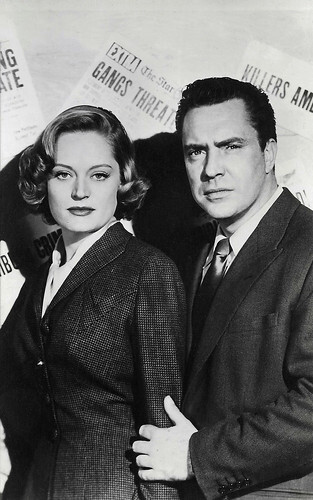
Spanish postcard by JDP, Valencia, no. 1432. Edmond O'Brien and Alexis Smith in The Turning Point (William Dieterle, 1952).
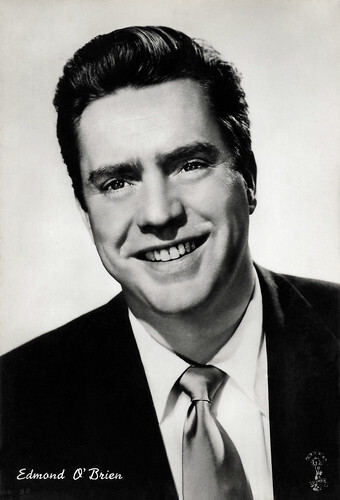
Italian postcard by Bromofoto, Milano, no. 1036. Photo: CEIAD Columbia.
A sympathetic appearance, a robust and virile constitution and a chubby face
Edmond O'Brien was born Eamon Joseph O'Brien in Brooklyn in 1915 as the seventh and last child of Agnes (née Baldwin) and James O'Brien, who hailed from southern Ireland. His father died when he was four years old. As a child, Edmond performed magic shows for the children of the neighbourhood. An aunt who was an English teacher took him to the theatre from an early age. O'Brien developed an interest in acting and a little later he started playing in school plays.
After six months at Fordham University, he went on a scholarship to the Neighbourhood Playhouse School in New York where he studied theatre for two years. He also took classes with the Columbia Laboratory Players group on the works of William Shakespeare . O'Brien made his debut in Yonkers, at the Summer Stock Theatre, a theatre where plays are only performed in the summer. In the process, scenery and costumes are reused by young actors who gain experience that way. O'Brien then made his debut on Broadway in 1936, where he was noticed by Orson Welles . O'Brien had a sympathetic appearance, a robust and virile constitution and a chubby face.
In 1937, he became a permanent member of the Mercury Theatre, a company led by Orson Welles and John Houseman. He appeared with Welles on the radio and in the theatre. His first film role was as an uncredited extra in Prison Break (Arthur Lubin, 1938). He continued to play for Mercury until 1940. Pandro Berman, the boss of RKO Pictures, noticed O'Brien's acting talent in 1939. He gave him the role of a young charming poet who falls in love with the gypsy woman Esmeralda ( Maureen O'Hara ) in The Hunchback of Notre Dame (William Dieterle, 1939). Charles Laughton starred in the title role of this historical drama based on Victor Hugo 's novel of the same name. O'Brien returned to Broadway to play Mercutio opposite Laurence Olivier and Vivien Leigh in 'Romeo and Juliet'.
RKO offered Edmond O'Brien a long-term contract. His roles included a feature spot in A Girl, a Guy, and a Gob (Richard Wallace, 1941) and the co-male lead in Parachute Battalion (Leslie Goodwins, 1941). The latter starred Nancy Kelly, whom O'Brien would later marry. During the first half of the 1940s, Edmond O'Brien appeared only sporadically on the big screen as he served with the United States Army Air Forces during World War II. He appeared in the Air Forces' Broadway play 'Winged Victory' with Red Buttons, Karl Malden, Kevin McCarthy, Gary Merrill, Barry Nelson and Martin Ritt. The Moss Hart play was filmed, Winged Victory (George Cukor, 1944), with O'Brien reprising his stage performance and Judy Holliday co-starring. .
The Film Noir The Killers (Robert Siodmak, 1946), starring Burt Lancaster and Ava Gardner , was perhaps O'Brien's first significant film. He played an insurance company investigator who had to investigate a suspicious murder case: a man with a life insurance policy was killed without resisting. He followed that with the lead in two more Film Noirs, The Web (Michael Gordon 1947) with Ella Raines , and the second lead in A Double Life (George Cukor, 1947) starring Ronald Colman . In late 1948, O'Brien signed a contract with Warner Bros. In White Heat (Raoul Walsh, 1949), he portrayed an undercover FBI agent who hooks up in prison with a violent gangster boss ( James Cagney ). He gains his complete trust to find out where the huge loot from a train robbery is hidden. In another classic of the genre, the powerful and haunting Film Noir D.O.A. (Rudolph Maté, 1950), O'Brien played the lead role of a man who was fatally poisoned. He has one day to live and runs a desperate race against time to track down his killer himself.

Italian postcard by Bromofoto, Milano, no, 408. Photo: Paramount. Edmond O'Brien and Yvonne De Carlo in Silver City (Byron Haskin, 1951).
Film Noir films with dramatic, criminal or thriller overtones
Edmond O'Brien's weight increased in the 1950s which sometimes resulted in him having to slim down for a role or being ineligible for certain roles. He was most often directed in Film Noir films with dramatic, criminal or thriller overtones. He also performed roles in Westerns (9 films) and War films (9). He also featured in a dozen comedies and tragicomedies. He was not only cast as a lead actor. Because he did not conform to Hollywood's common ideal of beauty, he was equally cast as a genre actor in supporting roles.
1953 was a very fruitful year for him. O'Brien starred for the first time in a film by Don Siegel: the adventure war film China Venture in which, as a captain, he heads a group of soldiers tasked with locating and interrogating a crashed Japanese admiral. O'Brien starred in two films by Ida Lupino , the most important female filmmaker working in the 1950s during the Hollywood studio system. In the Film Noir thriller The Hitch-Hiker (Ida Lupino, 1953) with Frank Lovejoy, he is one of two friends forced by a psychopathic hitchhiker to take him to Mexico. The Film Noir drama The Bigamist (Ida Lupino, 1953) shows how a simple businessman, unhappily married to an ambitious businesswoman ( Joan Fontaine ) who cannot have children, ends up in a bigamist state.
In the successful biopic Julius Caesar (Joseph L. Mankiewicz, 1953), O'Brien portrayed Casca, one of Julius Caesar's assassins. For his role as a sweaty, chatty, self-confident and despicable publicity agent in the drama The Barefoot Contessa (Joseph L. Mankiewicz, 1954), O'Brien won the Oscar for Best Male Supporting Actor and also the Golden Globe in the same category. In the Jayne Mansfield vehicle The Girl Can't Help It (Frank Tashlin, 1956), O'Brien played a gangster boss, who wants his sexy blonde girlfriend to become a successful singer at all costs. The dramatic Sci-fi film 1984 (Michael Anderson, 1956) was the first feature-length adaptation of George Orwell's novel of the same name. O'Brien took the lead role of Winston Smith, an ordinary member of the ruling party in a future London who disagrees with the government's totalitarian control and repression. From 1959 to 1960, O'Brien portrayed the title role in the syndicated crime drama Johnny Midnight, about a New York City actor-turned-private detective. The producers refused to cast him unless he shed at least 50 pounds, so he went on a crash vegetarian diet and quit drinking.
Of the nine Westerns in which Edmond O'Brien appeared, two were by reputable Western directors: The Man Who Shot Liberty Valance (John Ford, 1962) and The Wild Bunch (Sam Peckinpah, 1969) were therefore by far the best-known and the best. In the John Ford classic, O'Brien gave colour to the editor of the local village newspaper. In Sam Peckinpah's groundbreaking and violent revisionist Western, he starred as an older cantankerous outlaw who accompanies the ‘wild Bunch’, a depleted and outlawed gang disappointed by a failed robbery, to other enders. He co-starred in the Disney comedy Moon Pilot (James Neilson, 1962), and the star-studded ensemble cast of the World War II epic The Longest Day (Ken Annakin, Andrew Marton, Bernhard Wicki, 1962). John Frankenheimer called on O'Brien twice: first for his biographical drama Birdman of Alcatraz (John Frankenheimer, 1962) in which O'Brien embodied journalist Thomas E. Gaddis, visiting the incarcerated ‘birdman’ ( Burt Lancaster ) to write a book about him. Two years later, he voiced the role of an alcoholic US senator and intimate confidant of the unpopular president threatened by a coup in the political thriller Seven Days in May (John Frankenheimer, 1964). This earned him a second Golden Globe for Best Male Supporting Actor. Still in 1964, more than a decade after China Venture, O'Brien featured again in a film by Don Siegel: in the dramatic crime film The Hanged Man (Don Siegel, 1964), he shared the lead role with Robert Culp.
O'Brien was a cast member of The Other Side of the Wind, Orson Welles ' unfinished 1970s film that finally was released in 2018. One of his last major roles was that of a Federal Bureau of Narcotics inspector in Lucky Luciano (Francesco Rosi, 1973), a biographical gangster film about mafia boss Salvatore Lucania (Gian Maria Volonté). O'Brien directed two films: the Film Noir Shield for Murder (co-directed with Howard W. Koch, 1954) in which he played the lead role of a police lieutenant who degenerates into a corrupt and depraved man after 16 years of service. The Neo Noir film Man-Trap (1961) starring Jeffrey Hunter and Stella Stevens , shows how a Korean War veteran becomes involved in an enticing but risky theft of illegal weapons via a friend-veteran. For over two decades (1951-1974), O'Brien was a regular on the small screen. He often contributed to anthology series, especially in the 1950s, his most prolific television period. He also played the title role in the courtroom drama Sam Benedict (28 episodes, 1962-1963). In the successful dramatic series The Long, Hot Summer (1965-1966), he was the powerful, lying and dastardly patriarch bank owner. Between 1941 and 1942, Edmond O'Brien was first married to actress Nancy Kelly. Actress Olga San Juan became his second wife in 1948 and the mother of his three children: television producer Bridget, actress Maria (1950) and actor Brendan (1962-2023). The couple divorced in 1976. In the late 1970s, the actor was stricken with Alzheimer's disease. In 1985, Edmond O'Brien died at the age of 69 as a result of complications from the disease. He is buried in the Holy Cross Cemetery in Culver City, California.
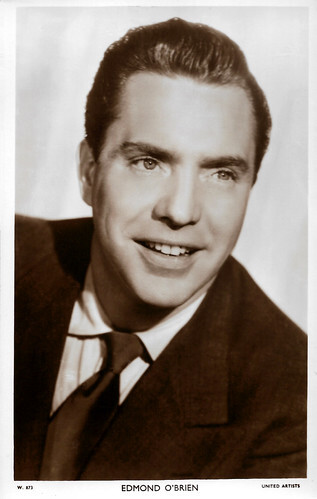
British postcard in the Picturegoer Series, London, no. W. 873. Photo: United Artists.
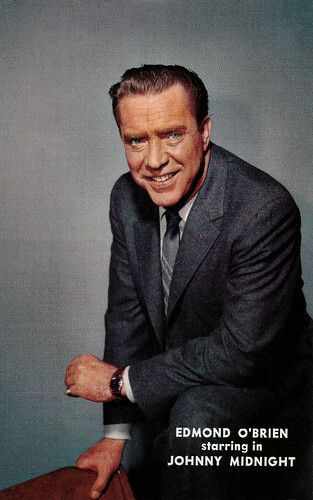
American postcard by H.S. Crocker Co., Inc., San Francisco, no. HSC 307. Edmond O'Brien in the TV series Johnny Midnight (1960). Caption: Edmond O'Brien is a versatile actor who has included both motion pictures and television in his career. Eddie is the star of the TV series, Johnny Midnight, filmed at Revue Studios. It is the story of an adventurous theatrical agent in New York City.
Sources: (IMDb), Wikipedia (Dutch, German and English) and .

Spanish postcard by JDP, Valencia, no. 1432. Edmond O'Brien and Alexis Smith in The Turning Point (William Dieterle, 1952).

Italian postcard by Bromofoto, Milano, no. 1036. Photo: CEIAD Columbia.
A sympathetic appearance, a robust and virile constitution and a chubby face
Edmond O'Brien was born Eamon Joseph O'Brien in Brooklyn in 1915 as the seventh and last child of Agnes (née Baldwin) and James O'Brien, who hailed from southern Ireland. His father died when he was four years old. As a child, Edmond performed magic shows for the children of the neighbourhood. An aunt who was an English teacher took him to the theatre from an early age. O'Brien developed an interest in acting and a little later he started playing in school plays.
After six months at Fordham University, he went on a scholarship to the Neighbourhood Playhouse School in New York where he studied theatre for two years. He also took classes with the Columbia Laboratory Players group on the works of William Shakespeare . O'Brien made his debut in Yonkers, at the Summer Stock Theatre, a theatre where plays are only performed in the summer. In the process, scenery and costumes are reused by young actors who gain experience that way. O'Brien then made his debut on Broadway in 1936, where he was noticed by Orson Welles . O'Brien had a sympathetic appearance, a robust and virile constitution and a chubby face.
In 1937, he became a permanent member of the Mercury Theatre, a company led by Orson Welles and John Houseman. He appeared with Welles on the radio and in the theatre. His first film role was as an uncredited extra in Prison Break (Arthur Lubin, 1938). He continued to play for Mercury until 1940. Pandro Berman, the boss of RKO Pictures, noticed O'Brien's acting talent in 1939. He gave him the role of a young charming poet who falls in love with the gypsy woman Esmeralda ( Maureen O'Hara ) in The Hunchback of Notre Dame (William Dieterle, 1939). Charles Laughton starred in the title role of this historical drama based on Victor Hugo 's novel of the same name. O'Brien returned to Broadway to play Mercutio opposite Laurence Olivier and Vivien Leigh in 'Romeo and Juliet'.
RKO offered Edmond O'Brien a long-term contract. His roles included a feature spot in A Girl, a Guy, and a Gob (Richard Wallace, 1941) and the co-male lead in Parachute Battalion (Leslie Goodwins, 1941). The latter starred Nancy Kelly, whom O'Brien would later marry. During the first half of the 1940s, Edmond O'Brien appeared only sporadically on the big screen as he served with the United States Army Air Forces during World War II. He appeared in the Air Forces' Broadway play 'Winged Victory' with Red Buttons, Karl Malden, Kevin McCarthy, Gary Merrill, Barry Nelson and Martin Ritt. The Moss Hart play was filmed, Winged Victory (George Cukor, 1944), with O'Brien reprising his stage performance and Judy Holliday co-starring. .
The Film Noir The Killers (Robert Siodmak, 1946), starring Burt Lancaster and Ava Gardner , was perhaps O'Brien's first significant film. He played an insurance company investigator who had to investigate a suspicious murder case: a man with a life insurance policy was killed without resisting. He followed that with the lead in two more Film Noirs, The Web (Michael Gordon 1947) with Ella Raines , and the second lead in A Double Life (George Cukor, 1947) starring Ronald Colman . In late 1948, O'Brien signed a contract with Warner Bros. In White Heat (Raoul Walsh, 1949), he portrayed an undercover FBI agent who hooks up in prison with a violent gangster boss ( James Cagney ). He gains his complete trust to find out where the huge loot from a train robbery is hidden. In another classic of the genre, the powerful and haunting Film Noir D.O.A. (Rudolph Maté, 1950), O'Brien played the lead role of a man who was fatally poisoned. He has one day to live and runs a desperate race against time to track down his killer himself.

Italian postcard by Bromofoto, Milano, no, 408. Photo: Paramount. Edmond O'Brien and Yvonne De Carlo in Silver City (Byron Haskin, 1951).
Film Noir films with dramatic, criminal or thriller overtones
Edmond O'Brien's weight increased in the 1950s which sometimes resulted in him having to slim down for a role or being ineligible for certain roles. He was most often directed in Film Noir films with dramatic, criminal or thriller overtones. He also performed roles in Westerns (9 films) and War films (9). He also featured in a dozen comedies and tragicomedies. He was not only cast as a lead actor. Because he did not conform to Hollywood's common ideal of beauty, he was equally cast as a genre actor in supporting roles.
1953 was a very fruitful year for him. O'Brien starred for the first time in a film by Don Siegel: the adventure war film China Venture in which, as a captain, he heads a group of soldiers tasked with locating and interrogating a crashed Japanese admiral. O'Brien starred in two films by Ida Lupino , the most important female filmmaker working in the 1950s during the Hollywood studio system. In the Film Noir thriller The Hitch-Hiker (Ida Lupino, 1953) with Frank Lovejoy, he is one of two friends forced by a psychopathic hitchhiker to take him to Mexico. The Film Noir drama The Bigamist (Ida Lupino, 1953) shows how a simple businessman, unhappily married to an ambitious businesswoman ( Joan Fontaine ) who cannot have children, ends up in a bigamist state.
In the successful biopic Julius Caesar (Joseph L. Mankiewicz, 1953), O'Brien portrayed Casca, one of Julius Caesar's assassins. For his role as a sweaty, chatty, self-confident and despicable publicity agent in the drama The Barefoot Contessa (Joseph L. Mankiewicz, 1954), O'Brien won the Oscar for Best Male Supporting Actor and also the Golden Globe in the same category. In the Jayne Mansfield vehicle The Girl Can't Help It (Frank Tashlin, 1956), O'Brien played a gangster boss, who wants his sexy blonde girlfriend to become a successful singer at all costs. The dramatic Sci-fi film 1984 (Michael Anderson, 1956) was the first feature-length adaptation of George Orwell's novel of the same name. O'Brien took the lead role of Winston Smith, an ordinary member of the ruling party in a future London who disagrees with the government's totalitarian control and repression. From 1959 to 1960, O'Brien portrayed the title role in the syndicated crime drama Johnny Midnight, about a New York City actor-turned-private detective. The producers refused to cast him unless he shed at least 50 pounds, so he went on a crash vegetarian diet and quit drinking.
Of the nine Westerns in which Edmond O'Brien appeared, two were by reputable Western directors: The Man Who Shot Liberty Valance (John Ford, 1962) and The Wild Bunch (Sam Peckinpah, 1969) were therefore by far the best-known and the best. In the John Ford classic, O'Brien gave colour to the editor of the local village newspaper. In Sam Peckinpah's groundbreaking and violent revisionist Western, he starred as an older cantankerous outlaw who accompanies the ‘wild Bunch’, a depleted and outlawed gang disappointed by a failed robbery, to other enders. He co-starred in the Disney comedy Moon Pilot (James Neilson, 1962), and the star-studded ensemble cast of the World War II epic The Longest Day (Ken Annakin, Andrew Marton, Bernhard Wicki, 1962). John Frankenheimer called on O'Brien twice: first for his biographical drama Birdman of Alcatraz (John Frankenheimer, 1962) in which O'Brien embodied journalist Thomas E. Gaddis, visiting the incarcerated ‘birdman’ ( Burt Lancaster ) to write a book about him. Two years later, he voiced the role of an alcoholic US senator and intimate confidant of the unpopular president threatened by a coup in the political thriller Seven Days in May (John Frankenheimer, 1964). This earned him a second Golden Globe for Best Male Supporting Actor. Still in 1964, more than a decade after China Venture, O'Brien featured again in a film by Don Siegel: in the dramatic crime film The Hanged Man (Don Siegel, 1964), he shared the lead role with Robert Culp.
O'Brien was a cast member of The Other Side of the Wind, Orson Welles ' unfinished 1970s film that finally was released in 2018. One of his last major roles was that of a Federal Bureau of Narcotics inspector in Lucky Luciano (Francesco Rosi, 1973), a biographical gangster film about mafia boss Salvatore Lucania (Gian Maria Volonté). O'Brien directed two films: the Film Noir Shield for Murder (co-directed with Howard W. Koch, 1954) in which he played the lead role of a police lieutenant who degenerates into a corrupt and depraved man after 16 years of service. The Neo Noir film Man-Trap (1961) starring Jeffrey Hunter and Stella Stevens , shows how a Korean War veteran becomes involved in an enticing but risky theft of illegal weapons via a friend-veteran. For over two decades (1951-1974), O'Brien was a regular on the small screen. He often contributed to anthology series, especially in the 1950s, his most prolific television period. He also played the title role in the courtroom drama Sam Benedict (28 episodes, 1962-1963). In the successful dramatic series The Long, Hot Summer (1965-1966), he was the powerful, lying and dastardly patriarch bank owner. Between 1941 and 1942, Edmond O'Brien was first married to actress Nancy Kelly. Actress Olga San Juan became his second wife in 1948 and the mother of his three children: television producer Bridget, actress Maria (1950) and actor Brendan (1962-2023). The couple divorced in 1976. In the late 1970s, the actor was stricken with Alzheimer's disease. In 1985, Edmond O'Brien died at the age of 69 as a result of complications from the disease. He is buried in the Holy Cross Cemetery in Culver City, California.

British postcard in the Picturegoer Series, London, no. W. 873. Photo: United Artists.

American postcard by H.S. Crocker Co., Inc., San Francisco, no. HSC 307. Edmond O'Brien in the TV series Johnny Midnight (1960). Caption: Edmond O'Brien is a versatile actor who has included both motion pictures and television in his career. Eddie is the star of the TV series, Johnny Midnight, filmed at Revue Studios. It is the story of an adventurous theatrical agent in New York City.
Sources: (IMDb), Wikipedia (Dutch, German and English) and .
Published on June 04, 2025 22:00
June 3, 2025
Directed by Enrico Guazzoni
Italian director and writer Enrico Guazzoni (1876-1949) started his career as a painter and designer. Before D.W. Griffith, he pioneered epic motion pictures with vast sets and huge casts for which he doubled as the art director. Guazzoni is particularly famous for Quo vadis? (1913), one of the first blockbusters in film history. Guazzoni remained active in the film industry until 1943.
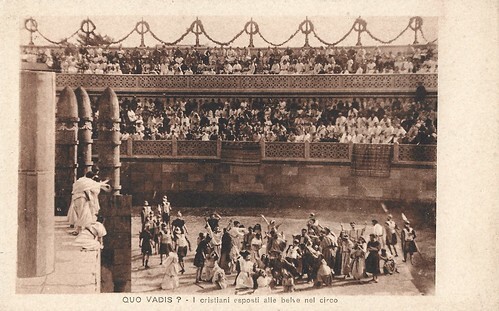
Italian postcard. Photo: Cines. Scene from Quo vadis? (Enrico Guazzoni, 1913), adapted from the novel by Henryk Sienkiewicz. Caption: The Christians were exposed to the beasts at the circus.
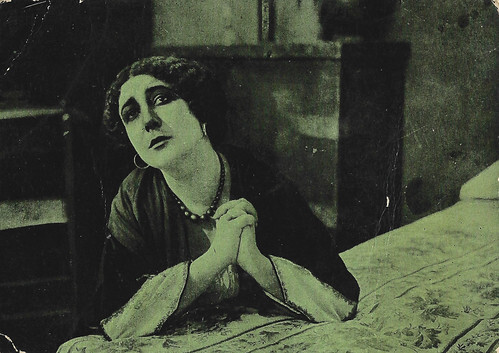
Spanish collector card by Chocolate Pi, Barcelona, no. 8. Photo: Distr. J. Pich, Barcelona / Cines. Leda Gys in Amica (Enrico Guazzoni, 1916).
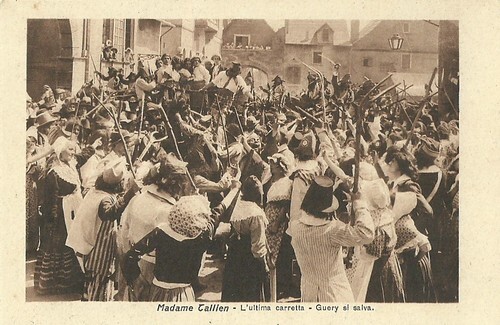
Italian postcard by IPA CT Duplex / Uff. Rev. St. Terni, no. 3279. Photo: Film Cines. Ruggero Barni as Jean Guery in Madame Tallien / Madame Guillotine (Mario Caserini, Enrico Guazzoni, 1916), based on the play by Victorien Sardou set during the French Revolution. Caption: The last cart. Guery is saved.
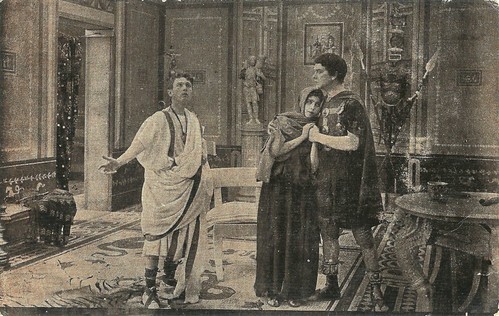
Spanish postcard for Amatller Marca Luna chocolate, series 8, no. 14. Photo: Palatino Film. Livio Pavanelli as St. Sebastiano in Fabiola (Enrico Guazzoni, 1918), hosting the blind Christian refugee Cecilia (Valeria Sanfilippo) on the request of the young Pancrazio (unknown).
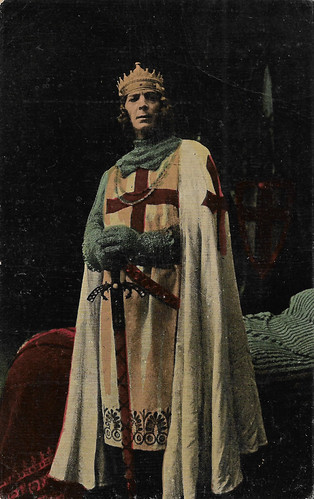
Spanish cromo (collector card) by Chocolat Imperiale, no. 5 of 6 cards. Amleto Novelli as Tancredi in the Italian silent period piece La Gerusalemme liberata / Jerusalem Liberated (Enrico Guazzoni, 1918), an adaptation of the classic poem by Torquato Tasso.
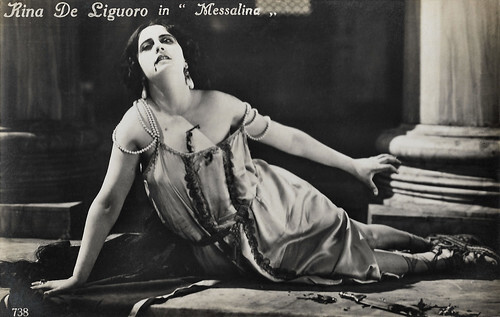
Italian postcard by Ed. A. Traldi, Milano, no. 738. Rina De Liguoro dies in the final scene of Messalina (Enrico Guazzoni, 1924).
Catapulted to world fame
Enrico Guazzoni was born in 1876 in Rome, Lazio, Italy. He was the son of Bartolomeo Guazzoni and Ginevra, née Santucci. Enrico studied painting at the Accademia delle Belle Arti (Fine Arts Academy) in his native Rome, but did not finish his studies. Guazzoni began his career as a poster artist and set designer for the Alberini & Santoni company in Rome. He was already an appreciated Roman painter when Filoteo Alberini entrusted him in 1907 with the decoration of the ceiling of the Cinema Moderno in Rome, a few years after the cinema opened. Guazzoni carried out the job together with Federico Ballester.
In 1905, Filoteo Alberini founded Cines, which became the leading Italian film company of the time. Guazzoni continued to collaborate with Alberini, designing colourful film posters for Cines. He also acted as a consultant for the sets of films with a historical background. Soon, he permanently joined Cines. Originally, he worked as a set designer for Mario Caserini, but in 1909, he became one of the company's directors.
Soon, Enrico Guazzoni became Cines's most prolific and high-profile director. He made short films in a wide variety of genres. In 1910, he directed Faust, Giulia Colonna, and Adriana di Berteaux. He especially liked costume films set in Roman times, such as Agrippina (1911) and Bruto / Brutus (1911) starring Amleto Novelli . A great success was La Gerusalemme liberata / Jerusalem Liberated (1911), of which he shot another version seven years later. His films demonstrated a real flair for the spectacular and consistently created a strong sense of three-dimensional space absent from earlier films of the genre.
The moderate acclaim won by Guazzoni's early films was paled by the overwhelming international success of Quo vadis? (1913), based on the popular novel by Henryk Sienkiewicz. With 5,000 extras, lavish sets, and a lengthy running time of two hours, the film set the standard for 'Superspectacles' of 'Colossals' for decades to come. This grand historical epic catapulted Guazzoni to world fame. It set the benchmark for epic spectacle before D.W. Griffith and Hollywood cornered the market. Guazzoni lifted that benchmark himself a year later with the colossal - and colossally budgeted - Giulio Cesare / Julius Caesar (1914), a film that required not only the accurate miniature reconstruction of the entire city of Rome but also the employment of 20,000 extras for the crowd scenes.
Guazzoni doubled as art director on his films and used his painting studio to create the sets and costumes. In 1914, he opened his own typography studio in Rome under the name ‘Stabilimento Litografico Enrico Guazzoni’, located in Via Chieti, near Porta San Giovanni. Here he worked as a poster artist, set up a centre for the publication of works by the best painters of the time and, above all, produced posters for the cinema. His collaborators included Tito Corbella , Anselmo Ballester - the son of Federico Ballester, Duilio Cambellotti and Luigi Martinati.
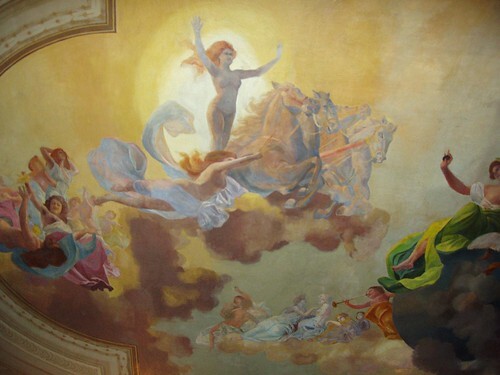
Allegory of Light & Triumph of Photography, ceiling of Cinema Moderno (1904), Rome, Italy. Painted by Federico Ballester and Enrico Guazzoni. Photo: Ivo Blom.
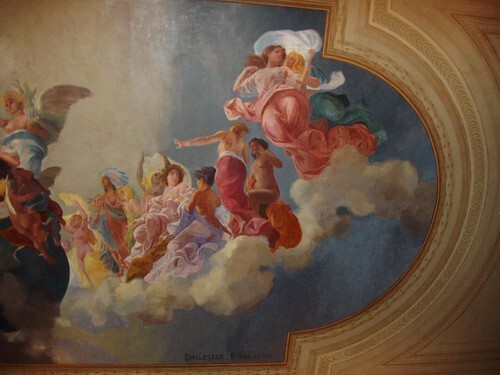
Detail of the ceiling of Cinema Moderno, Rome, Italy - Signature. Photo: Ivo Blom. The original (restored) ceiling from the Cinema Moderno can still be seen in Sala 4 of the Space Roma Moderno in Piazza della Repubblica, Rome. The ceiling represents the Triumph of Photography and was painted by Enrico Guazzoni and Federico Ballester, the father of film poster designer Anselmo Ballester. Their names are visible on the bottom side. Allegorical characters representing the four continents, America, Africa, Europe and Asia bring homage to Photography. In the corners of the ceiling, the heads of Della Porta, Daguerre, Niepce and Talbot are visible (not in these pictures). Moderno was built in 1904 by film pioneer Filoteo Alberini, who founded the Cines film company in 1905. It has been claimed to be the first purpose-built cinema in Italy.
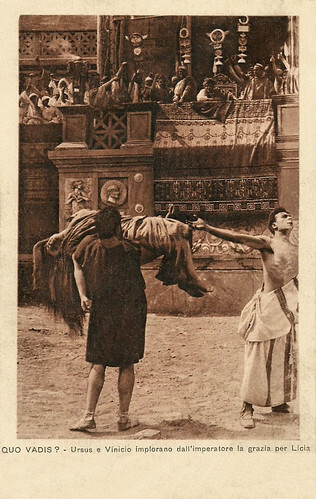
Italian postcard by Uff.Rev. St. Terni. Bruto Castellani and Amleto Novelli in Quo vadis? (Enrico Guazzoni, 1913). Ursus ( Bruto Castellani ) and Vinicius ( Amleto Novelli ) implore the audience and Emperor Nero to grace the Christian Lygia ( Lea Giunchi ) after Ursus has killed the bull on whose back Lygia had been bound. The audience raves because of Ursus' tour de force. Vinicius has stripped his clothes to show his scars from the wars, while Ursus holds up Lygia. All around Nero hold their thumbs up for grace, even if this sign seems to have been a 19th-century invention and is historically incorrect.
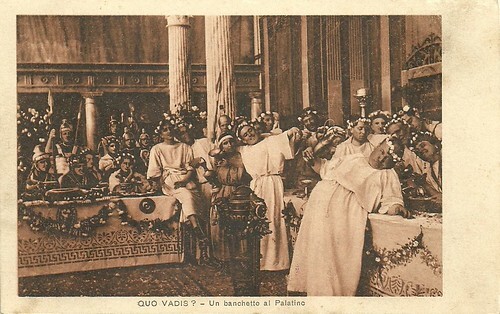
Italian postcard. Photo: Cines. Giuseppe Gambardella in Quo vadis? (Enrico Guazzoni, 1913). Caption: A banquet on the Palatine. The fat and drunken man in front is Giuseppe Gambardella, who was also famous as Checco in short Italian comedies.

Austrian postcard by B.K.W.I. (Brüder Kohn, Wien), no. 34. Photo: Cines. Gianna Terribili Gonzales as Cleopatra, enjoying herself in Marcantonio e Cleopatra / Antony and Cleopatra (Enrico Guazzoni, 1913). German film title: Die Herrin des Nils.

Austrian postcard by B.K.W.I. (Brüder Kohn, Wien), no. 35. Photo: Cines. Marc Anthony (Amleto Novelli), dressed as an Egyptian pharaoh, rejects his wife Octavia (Elsa Lenard) in Marcantonio e Cleopatra / Antony and Cleopatra (Enrico Guazzoni, 1913). German film title: Die Herrin des Nils.
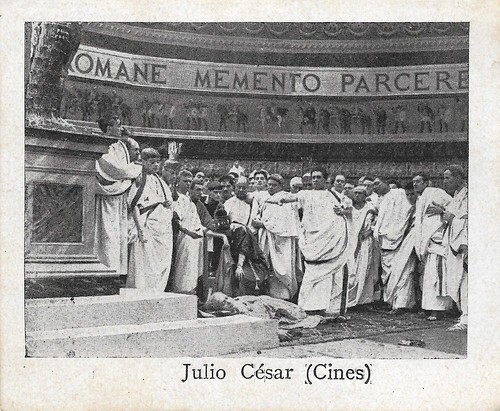
Spanish collector card by Reclam Films, Mallorca, no. 12 of 12. Photo: Cines. Scene from Giulio Cesare / Julius Caesar (Enrico Guazzoni, 1914), released in Spain as Julio César. The corpse of Julius Caesar ( Amleto Novelli ) after his assassination in the Senate. Mark Antony (Orlando Ricci) swearing revenge.
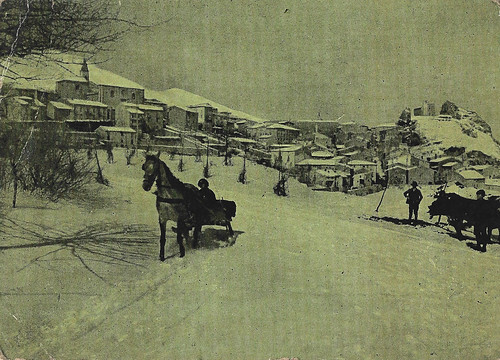
Spanish collector card by Chocolate Pi, Barcelona, no. 6. Photo: Distr. J. Pich, Barcelona / Cines. Leda Gys in Amica (Enrico Guazzoni, 1916).
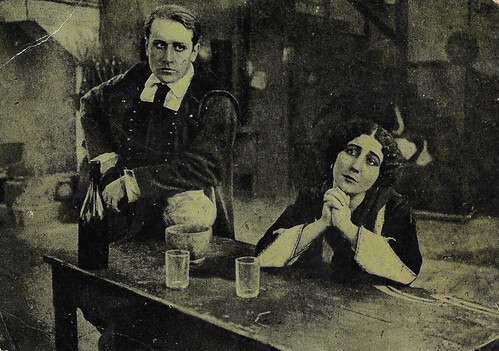
Spanish collector card by Chocolate Pi, Barcelona, no. 9. Photo: Distr. J. Pich, Barcelona / Cines. Leda Gys and Augusto Poggioli in Amica (Enrico Guazzoni, 1916).
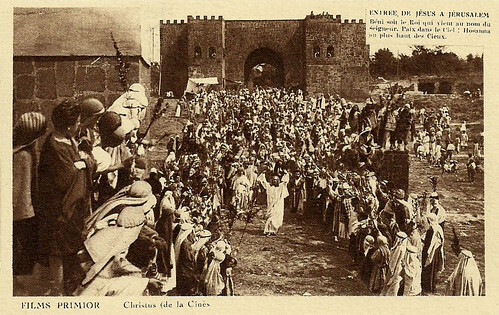
French postcard by J. Mayer, graveur, Paris. Photo: Films Primior, Paris / Cines. Alberto Pasquali as Jesus Christ in Christus / Christ (Giulio Antamoro, Enrico Guazzon, 1916). On Palm Sunday, the Sunday before Easter, Christians celebrate Christ's triumphant entry into Jerusalem. In 1915-1916, so right in the middle of the First World War, Italian director Count Giulio Antamoro (1877-1945) went to Palestine and Egypt, on behalf of the film company Cines. Antamoro wanted to film the life of Christ on location. Christus, released in 1916, was a worldwide success, not only because of the quotations of famous artworks such as Fra Angelico's 'Annunciation', Leonardo's 'Last Supper' and Michelangelo's 'Pietà, but also because of the shots on location. When the additional shooting was necessary in 1916, Enrico Guazzoni did this, as Antamoro wasn't available anymore.
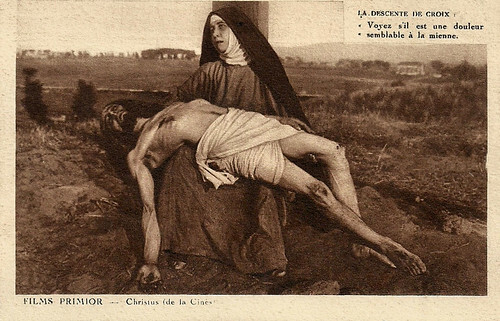
French postcard by J. Mayer, graveur, Paris. Photo: Films Primior, Paris / Cines. Alberto Pasquali as Jesus Christ and Leda Gys as Mary in Christus / Christ (Giulio Antamoro, Enrico Guazzon, 1916). The Pietà with Jesus.
His most spectacular film
Enrico Guazzoni's later works, such as the Napoleonic Scuola d'eroi / How Heroes are Made (1914), and Madame Tallien / Madame Guillotine (1916) starring Lyda Borelli , also belong to this new ‘genre’ of films, only later defined as 'Colossal'.
Having set up his own production company in 1918, he continued to produce large-canvas films such as the medieval epic Gerusalemme Liberata / Jerusalem Liberated (1918), adapted from Torquato Tasso's poem, Fabiola (1918) and Il sacco di Roma / The Sack of Rome (1920) directed together with Giulio Aristide Sartorio. The company soon collapsed in the general crisis that gripped the industry in the early 1920s.
In 1923, again for the Cines, Guazzoni directed what many regard as his most spectacular film, Messalina (1924), starring diva Rina De Liguoro as the third wife of Roman emperor Claudius. The film raised the sword-and-sandal epic to new heights and included a splendid chariot race that would be closely imitated, two years later, in the Hollywood production of Ben-Hur (Fred Niblo, 1925).
Nevertheless, the cost of Messalina helped to bankrupt the company, and Guazzoni left the industry to return only briefly in the 1930s with a small number of lighthearted and humorous films, the best known being the historical comedy Il re Burlone / The Joker King (1935).
Enrico Guazzoni remained active until 1943. His last work was, of course, a costume film, La Fornarina / The Baker's Girl (1943). Despite the casting of Lída Baarová and Anneliese Uhlig , the film was only a pale reverberation of the silent Colossals of which Guazzoni had been the absolute star director. He died in 1949 in Rome, Lazio, Italy. He was married to the actress Evelina Paoli.
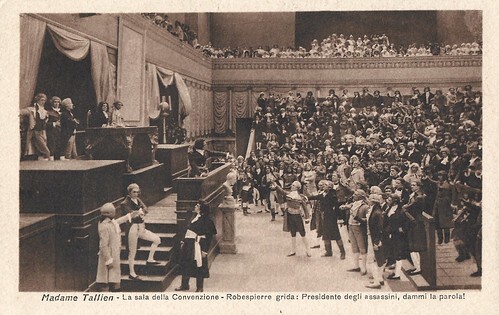
Italian postcard by IPA CT Duplex. Photo: Cines. Renzo Fabiani as Robespierre and Amleto Novelli as Tallien in Madame Tallien / Madame Guillotine (Enrico Guazzoni, 1916), based on the play by Victorien Sardou. Caption: The Hall of the Convention. Robespierre shouts: President of the assassins, pass me the word!

Italian postcard by IPA CT Duplex, no. 3271. Photo: Films Cines. Lyda Borelli as Terese de Fontenay / Madame Tallien in Madame Tallien / Madame Guillotine (Enrico Guazzoni, 1916). Caption: Liberation of the detained and Tallien.
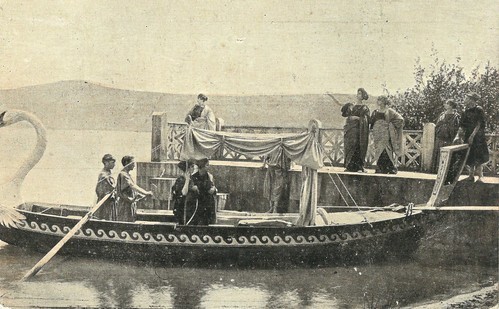
Spanish postcard for Amatller Marca Luna chocolate, series 8, no. 5. Photo: Palatino Film. Elena Sangro as Fabiola and Signora Poletti as her niece Agnese in Fabiola (Enrico Guazzoni, 1918). When the persecution of the Christians in Rome became too rough, Fabiola took her niece Agnese to her villa in the countryside.
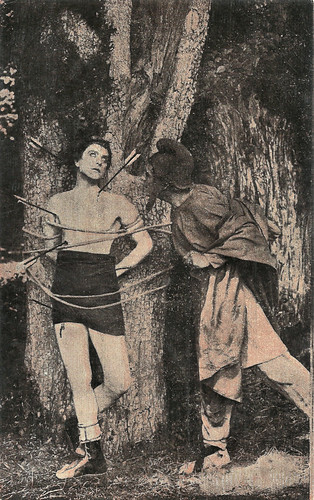
Spanish postcard for Amatller Marca Luna chocolate, series 8, no. 16. Photo: Palatino Film. Livio Pavanelli as St. Sebastiano and Amleto Novelli as Fulvio in Fabiola (Enrico Guazzoni, 1918).

Spanish cromo (collector card) by Chocolate Imperial, no. 2 of 6. The attack on Jerusalem in the Italian silent period piece La Gerusalemme liberata /Jerusalem Liberated (Enrico Guazzoni, 1918), an adaptation of the classic poem by Torquato Tasso.

Spanish cromo (collector card) by Chocolate Imperial, no. 3 of 6 cards. The Crusaders' camp in La Gerusalemme liberata /Jerusalem Liberated (Enrico Guazzoni, 1918), an adaptation of the classic poem by Torquato Tasso.
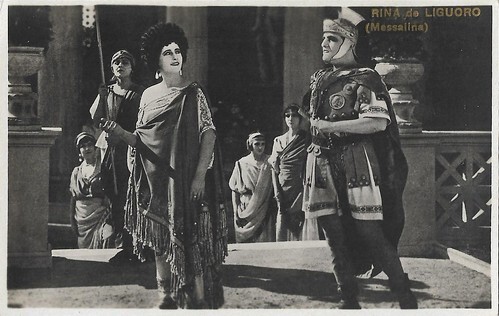
Italian postcard by Ed. A. Traldi, Milano, no. 738. Rina De Liguoro as the seductive Roman Empress Messalina in Messalina (Enrico Guazzoni, 1924).
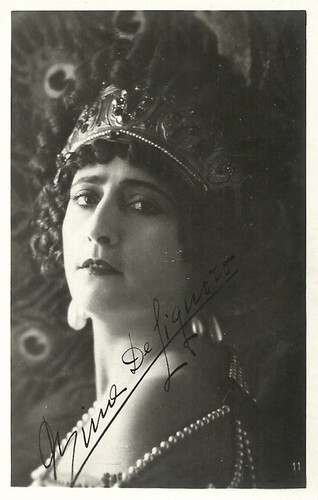
Italian postcard by B&G, B, no. 11. Rina De Liguoro as the title character in Messalina (Enrico Guazzoni, 1924). Signed by Rina De Liguoro .
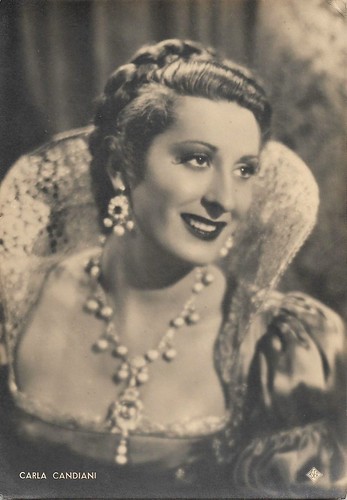
Italian postcard by ASER (A. Scarmiglia Edizioni Roma), no. 159. Carla Candiani in Il leone di Damasco / The Lion of Damascus (Corrado d'Errico, Enrico Guazzoni, 1942).
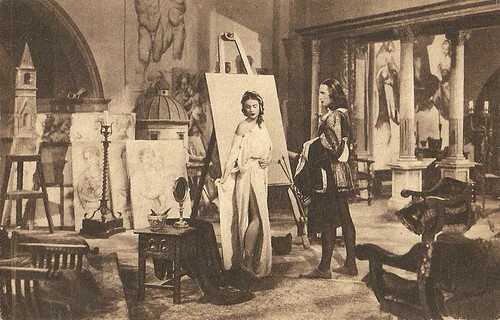
Italian postcard by Ed. Vecchioni & Guadagno, Roma. Photo: Mediterranea Film / Distribuzione EIA. Anneliese Uhlig and Walter Lazzaro in La Fornarina / The Baker's Girl (Corrado D'Errico, Enrico Guazzoni, 1944), a Spanish-Italian biopic on the Italian artist Raffaello Sanzio/ Raphael, with Walter Lazzaro as Raphael and Lída Baarová as his model and lover Margherita, the inspiration for his painting La Fornarina as well as some Madonnas. Yet, this raises the jealousy of the aristocratic Eleonora d'Este ( Anneliese Uhlig ), who has Margherita kidnapped. Caption: The art and life of Raphael in the light of a great love. The back of the card contains an ink stamp of the Supercinema Orfeo in Parma, Italy.

Italian postcard. Photo: Medierranea Film / Distribuzione EIA. Loredana as Maria da Bibbiena in La Fornarina / The Baker's Girl (Enrico Guazzoni, 1944).
Sources: Ivo Blom (Quo vadis?, Cabiria and the 'Archeologists'), Alberto Mira (Historical Dictionary of Italian Cinema), Treccani (Italian), Wikipedia (English and Italian) and .

Italian postcard. Photo: Cines. Scene from Quo vadis? (Enrico Guazzoni, 1913), adapted from the novel by Henryk Sienkiewicz. Caption: The Christians were exposed to the beasts at the circus.

Spanish collector card by Chocolate Pi, Barcelona, no. 8. Photo: Distr. J. Pich, Barcelona / Cines. Leda Gys in Amica (Enrico Guazzoni, 1916).

Italian postcard by IPA CT Duplex / Uff. Rev. St. Terni, no. 3279. Photo: Film Cines. Ruggero Barni as Jean Guery in Madame Tallien / Madame Guillotine (Mario Caserini, Enrico Guazzoni, 1916), based on the play by Victorien Sardou set during the French Revolution. Caption: The last cart. Guery is saved.

Spanish postcard for Amatller Marca Luna chocolate, series 8, no. 14. Photo: Palatino Film. Livio Pavanelli as St. Sebastiano in Fabiola (Enrico Guazzoni, 1918), hosting the blind Christian refugee Cecilia (Valeria Sanfilippo) on the request of the young Pancrazio (unknown).

Spanish cromo (collector card) by Chocolat Imperiale, no. 5 of 6 cards. Amleto Novelli as Tancredi in the Italian silent period piece La Gerusalemme liberata / Jerusalem Liberated (Enrico Guazzoni, 1918), an adaptation of the classic poem by Torquato Tasso.

Italian postcard by Ed. A. Traldi, Milano, no. 738. Rina De Liguoro dies in the final scene of Messalina (Enrico Guazzoni, 1924).
Catapulted to world fame
Enrico Guazzoni was born in 1876 in Rome, Lazio, Italy. He was the son of Bartolomeo Guazzoni and Ginevra, née Santucci. Enrico studied painting at the Accademia delle Belle Arti (Fine Arts Academy) in his native Rome, but did not finish his studies. Guazzoni began his career as a poster artist and set designer for the Alberini & Santoni company in Rome. He was already an appreciated Roman painter when Filoteo Alberini entrusted him in 1907 with the decoration of the ceiling of the Cinema Moderno in Rome, a few years after the cinema opened. Guazzoni carried out the job together with Federico Ballester.
In 1905, Filoteo Alberini founded Cines, which became the leading Italian film company of the time. Guazzoni continued to collaborate with Alberini, designing colourful film posters for Cines. He also acted as a consultant for the sets of films with a historical background. Soon, he permanently joined Cines. Originally, he worked as a set designer for Mario Caserini, but in 1909, he became one of the company's directors.
Soon, Enrico Guazzoni became Cines's most prolific and high-profile director. He made short films in a wide variety of genres. In 1910, he directed Faust, Giulia Colonna, and Adriana di Berteaux. He especially liked costume films set in Roman times, such as Agrippina (1911) and Bruto / Brutus (1911) starring Amleto Novelli . A great success was La Gerusalemme liberata / Jerusalem Liberated (1911), of which he shot another version seven years later. His films demonstrated a real flair for the spectacular and consistently created a strong sense of three-dimensional space absent from earlier films of the genre.
The moderate acclaim won by Guazzoni's early films was paled by the overwhelming international success of Quo vadis? (1913), based on the popular novel by Henryk Sienkiewicz. With 5,000 extras, lavish sets, and a lengthy running time of two hours, the film set the standard for 'Superspectacles' of 'Colossals' for decades to come. This grand historical epic catapulted Guazzoni to world fame. It set the benchmark for epic spectacle before D.W. Griffith and Hollywood cornered the market. Guazzoni lifted that benchmark himself a year later with the colossal - and colossally budgeted - Giulio Cesare / Julius Caesar (1914), a film that required not only the accurate miniature reconstruction of the entire city of Rome but also the employment of 20,000 extras for the crowd scenes.
Guazzoni doubled as art director on his films and used his painting studio to create the sets and costumes. In 1914, he opened his own typography studio in Rome under the name ‘Stabilimento Litografico Enrico Guazzoni’, located in Via Chieti, near Porta San Giovanni. Here he worked as a poster artist, set up a centre for the publication of works by the best painters of the time and, above all, produced posters for the cinema. His collaborators included Tito Corbella , Anselmo Ballester - the son of Federico Ballester, Duilio Cambellotti and Luigi Martinati.

Allegory of Light & Triumph of Photography, ceiling of Cinema Moderno (1904), Rome, Italy. Painted by Federico Ballester and Enrico Guazzoni. Photo: Ivo Blom.

Detail of the ceiling of Cinema Moderno, Rome, Italy - Signature. Photo: Ivo Blom. The original (restored) ceiling from the Cinema Moderno can still be seen in Sala 4 of the Space Roma Moderno in Piazza della Repubblica, Rome. The ceiling represents the Triumph of Photography and was painted by Enrico Guazzoni and Federico Ballester, the father of film poster designer Anselmo Ballester. Their names are visible on the bottom side. Allegorical characters representing the four continents, America, Africa, Europe and Asia bring homage to Photography. In the corners of the ceiling, the heads of Della Porta, Daguerre, Niepce and Talbot are visible (not in these pictures). Moderno was built in 1904 by film pioneer Filoteo Alberini, who founded the Cines film company in 1905. It has been claimed to be the first purpose-built cinema in Italy.

Italian postcard by Uff.Rev. St. Terni. Bruto Castellani and Amleto Novelli in Quo vadis? (Enrico Guazzoni, 1913). Ursus ( Bruto Castellani ) and Vinicius ( Amleto Novelli ) implore the audience and Emperor Nero to grace the Christian Lygia ( Lea Giunchi ) after Ursus has killed the bull on whose back Lygia had been bound. The audience raves because of Ursus' tour de force. Vinicius has stripped his clothes to show his scars from the wars, while Ursus holds up Lygia. All around Nero hold their thumbs up for grace, even if this sign seems to have been a 19th-century invention and is historically incorrect.

Italian postcard. Photo: Cines. Giuseppe Gambardella in Quo vadis? (Enrico Guazzoni, 1913). Caption: A banquet on the Palatine. The fat and drunken man in front is Giuseppe Gambardella, who was also famous as Checco in short Italian comedies.

Austrian postcard by B.K.W.I. (Brüder Kohn, Wien), no. 34. Photo: Cines. Gianna Terribili Gonzales as Cleopatra, enjoying herself in Marcantonio e Cleopatra / Antony and Cleopatra (Enrico Guazzoni, 1913). German film title: Die Herrin des Nils.

Austrian postcard by B.K.W.I. (Brüder Kohn, Wien), no. 35. Photo: Cines. Marc Anthony (Amleto Novelli), dressed as an Egyptian pharaoh, rejects his wife Octavia (Elsa Lenard) in Marcantonio e Cleopatra / Antony and Cleopatra (Enrico Guazzoni, 1913). German film title: Die Herrin des Nils.

Spanish collector card by Reclam Films, Mallorca, no. 12 of 12. Photo: Cines. Scene from Giulio Cesare / Julius Caesar (Enrico Guazzoni, 1914), released in Spain as Julio César. The corpse of Julius Caesar ( Amleto Novelli ) after his assassination in the Senate. Mark Antony (Orlando Ricci) swearing revenge.

Spanish collector card by Chocolate Pi, Barcelona, no. 6. Photo: Distr. J. Pich, Barcelona / Cines. Leda Gys in Amica (Enrico Guazzoni, 1916).

Spanish collector card by Chocolate Pi, Barcelona, no. 9. Photo: Distr. J. Pich, Barcelona / Cines. Leda Gys and Augusto Poggioli in Amica (Enrico Guazzoni, 1916).

French postcard by J. Mayer, graveur, Paris. Photo: Films Primior, Paris / Cines. Alberto Pasquali as Jesus Christ in Christus / Christ (Giulio Antamoro, Enrico Guazzon, 1916). On Palm Sunday, the Sunday before Easter, Christians celebrate Christ's triumphant entry into Jerusalem. In 1915-1916, so right in the middle of the First World War, Italian director Count Giulio Antamoro (1877-1945) went to Palestine and Egypt, on behalf of the film company Cines. Antamoro wanted to film the life of Christ on location. Christus, released in 1916, was a worldwide success, not only because of the quotations of famous artworks such as Fra Angelico's 'Annunciation', Leonardo's 'Last Supper' and Michelangelo's 'Pietà, but also because of the shots on location. When the additional shooting was necessary in 1916, Enrico Guazzoni did this, as Antamoro wasn't available anymore.

French postcard by J. Mayer, graveur, Paris. Photo: Films Primior, Paris / Cines. Alberto Pasquali as Jesus Christ and Leda Gys as Mary in Christus / Christ (Giulio Antamoro, Enrico Guazzon, 1916). The Pietà with Jesus.
His most spectacular film
Enrico Guazzoni's later works, such as the Napoleonic Scuola d'eroi / How Heroes are Made (1914), and Madame Tallien / Madame Guillotine (1916) starring Lyda Borelli , also belong to this new ‘genre’ of films, only later defined as 'Colossal'.
Having set up his own production company in 1918, he continued to produce large-canvas films such as the medieval epic Gerusalemme Liberata / Jerusalem Liberated (1918), adapted from Torquato Tasso's poem, Fabiola (1918) and Il sacco di Roma / The Sack of Rome (1920) directed together with Giulio Aristide Sartorio. The company soon collapsed in the general crisis that gripped the industry in the early 1920s.
In 1923, again for the Cines, Guazzoni directed what many regard as his most spectacular film, Messalina (1924), starring diva Rina De Liguoro as the third wife of Roman emperor Claudius. The film raised the sword-and-sandal epic to new heights and included a splendid chariot race that would be closely imitated, two years later, in the Hollywood production of Ben-Hur (Fred Niblo, 1925).
Nevertheless, the cost of Messalina helped to bankrupt the company, and Guazzoni left the industry to return only briefly in the 1930s with a small number of lighthearted and humorous films, the best known being the historical comedy Il re Burlone / The Joker King (1935).
Enrico Guazzoni remained active until 1943. His last work was, of course, a costume film, La Fornarina / The Baker's Girl (1943). Despite the casting of Lída Baarová and Anneliese Uhlig , the film was only a pale reverberation of the silent Colossals of which Guazzoni had been the absolute star director. He died in 1949 in Rome, Lazio, Italy. He was married to the actress Evelina Paoli.

Italian postcard by IPA CT Duplex. Photo: Cines. Renzo Fabiani as Robespierre and Amleto Novelli as Tallien in Madame Tallien / Madame Guillotine (Enrico Guazzoni, 1916), based on the play by Victorien Sardou. Caption: The Hall of the Convention. Robespierre shouts: President of the assassins, pass me the word!

Italian postcard by IPA CT Duplex, no. 3271. Photo: Films Cines. Lyda Borelli as Terese de Fontenay / Madame Tallien in Madame Tallien / Madame Guillotine (Enrico Guazzoni, 1916). Caption: Liberation of the detained and Tallien.

Spanish postcard for Amatller Marca Luna chocolate, series 8, no. 5. Photo: Palatino Film. Elena Sangro as Fabiola and Signora Poletti as her niece Agnese in Fabiola (Enrico Guazzoni, 1918). When the persecution of the Christians in Rome became too rough, Fabiola took her niece Agnese to her villa in the countryside.

Spanish postcard for Amatller Marca Luna chocolate, series 8, no. 16. Photo: Palatino Film. Livio Pavanelli as St. Sebastiano and Amleto Novelli as Fulvio in Fabiola (Enrico Guazzoni, 1918).

Spanish cromo (collector card) by Chocolate Imperial, no. 2 of 6. The attack on Jerusalem in the Italian silent period piece La Gerusalemme liberata /Jerusalem Liberated (Enrico Guazzoni, 1918), an adaptation of the classic poem by Torquato Tasso.

Spanish cromo (collector card) by Chocolate Imperial, no. 3 of 6 cards. The Crusaders' camp in La Gerusalemme liberata /Jerusalem Liberated (Enrico Guazzoni, 1918), an adaptation of the classic poem by Torquato Tasso.

Italian postcard by Ed. A. Traldi, Milano, no. 738. Rina De Liguoro as the seductive Roman Empress Messalina in Messalina (Enrico Guazzoni, 1924).

Italian postcard by B&G, B, no. 11. Rina De Liguoro as the title character in Messalina (Enrico Guazzoni, 1924). Signed by Rina De Liguoro .

Italian postcard by ASER (A. Scarmiglia Edizioni Roma), no. 159. Carla Candiani in Il leone di Damasco / The Lion of Damascus (Corrado d'Errico, Enrico Guazzoni, 1942).

Italian postcard by Ed. Vecchioni & Guadagno, Roma. Photo: Mediterranea Film / Distribuzione EIA. Anneliese Uhlig and Walter Lazzaro in La Fornarina / The Baker's Girl (Corrado D'Errico, Enrico Guazzoni, 1944), a Spanish-Italian biopic on the Italian artist Raffaello Sanzio/ Raphael, with Walter Lazzaro as Raphael and Lída Baarová as his model and lover Margherita, the inspiration for his painting La Fornarina as well as some Madonnas. Yet, this raises the jealousy of the aristocratic Eleonora d'Este ( Anneliese Uhlig ), who has Margherita kidnapped. Caption: The art and life of Raphael in the light of a great love. The back of the card contains an ink stamp of the Supercinema Orfeo in Parma, Italy.

Italian postcard. Photo: Medierranea Film / Distribuzione EIA. Loredana as Maria da Bibbiena in La Fornarina / The Baker's Girl (Enrico Guazzoni, 1944).
Sources: Ivo Blom (Quo vadis?, Cabiria and the 'Archeologists'), Alberto Mira (Historical Dictionary of Italian Cinema), Treccani (Italian), Wikipedia (English and Italian) and .
Published on June 03, 2025 22:00
June 1, 2025
Frida Richard
Frida Richard, also often referred to as Frieda Richard (1873-1946), was an Austrian actress who acted in almost 275 German and Austrian silent and sound films.
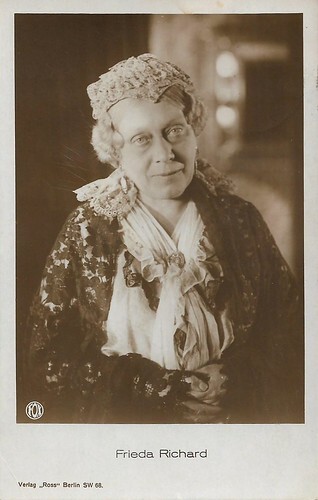
German postcard by Ross Verlag, unnumbered. Photo: Fox Film.
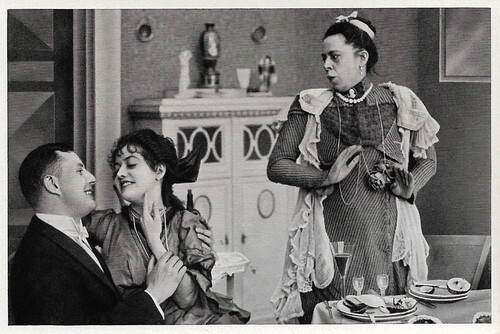
German collectors card by Ross Verlag in the series Vom Werden Deutscher Filmkunst - Der Stumme Film, no. 45, group 43. Photo: Tobias-Film. Bruno Kastner , Dorrit Weixler and Frida Richard in Dorittchens Vergnügungsreise / Little Dorrit's Pleasure Trip (Paul Heidemann, 1916).
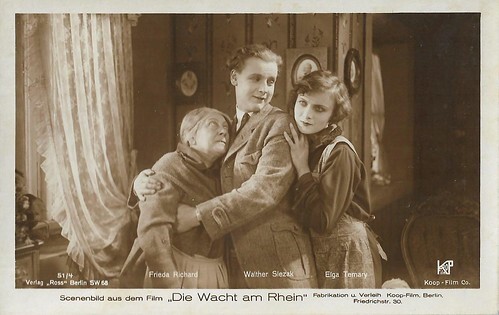
German postcard by Ross Verlag, Berlin, no. 51/4. Photo: Koop Film, Berlin. Walter Slezak as Walter Thiermann, an engineer in the service of industrialist Franz Großmann, surrounded by his old mother (Frida Richard) and his sister Renate ( Elza Temary ) in Die Wacht am Rhein. Aus des Rheinlands Schicksalstagen / The Watch on the Rhine. From the fateful days of the Rhineland (Helene Lackner, 1925-1926). Elza is misspelled as Elga here, and Walter as Walther.
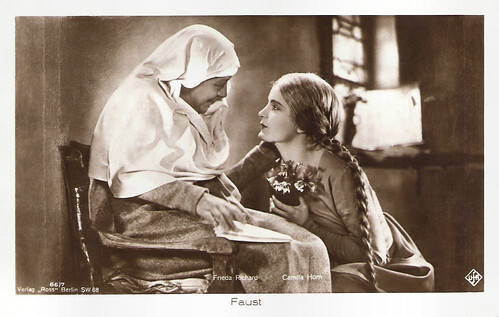
German postcard by Ross Verlag, no. 66/7. Photo: Ufa. Camilla Horn and Frida Richard in Faust (Friedrich Wilhelm Murnau, 1926).
Worried mothers or servants and counsellors
Frida (or Frieda) Richard was born in 1873 as Friederike Raithel in Vienna, Austria-Hungary. She was the daughter of a room painter. Frida attended a theatre school in Vienna. Her fellow students included Max Reinhardt and Fritz Richard, whom she married in 1898. She did not practise her profession at first but became an English teacher.
It was only after she moved to Berlin with her husband in 1905 that she appeared on the theatre stage there from 1908. In addition to Berlin, she also performed in Vienna at the theatres under Max Reinhardt and at the Salzburg Festival.
From 1910, Frida Richard was frequently seen in films, initially often alongside Henny Porten . Richard debuted in Das vierte Gebot (Charles Decroix, 1910), produced by Deutsche Mutoskop- und Biograph. She mostly played worried mothers or servants and counsellors. In such roles, she eventually became one of the busiest supporting actresses of the silent film era.
In the early 1910s, she acted at the companies Duskes, Luna, and, in particular, Messter, where she often co-acted in films with Henny Porten, such as Adressatin verstorben (1911/12), Komtess Ursel (1913), Ihre Hoheit (1913), and Eva (1913). Richard continued co-acting with Porten during the First World War in such films as Nordlandrose (1914), Feeenhande (1916), Gelöste Ketten (1916), Der Liebesbrief der Königin / The Queen's Love Letter (Robert Wiene, 1916), Die Ehe der Luise Rohrbach / The Marriage of Luise Rohrbach (Rudolf Biebrach, 1917), and Das Geschlecht derer von Ringwall / The Ringwall Family (Rudolf Biebrach, 1918).
Richard also co-acted in several Dorrit Weixler films directed by Franz Hofer at Luna and Oliver-Film, in films starring Fern Andra including Ernst ist das Leben (1916), Der Seele Saiten schwingen nicht (1917), and Drohende Wolken am Firmament (1918) - all at Fern-Andra-Film, and in films starring Mia May directed by her husband Joe May , like Ein einsam Grab (1916) and Wogen des Schicksals / Waves of Fate (1918). She also acted in films with Alwin Neuss , Bruno Decarli and Bruno Kastner , such as Kastner's Die Fürstin von Beranien (1918).
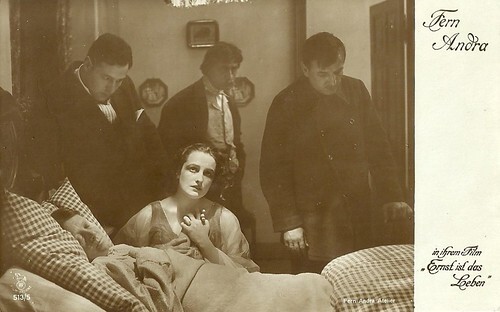
German postcard by Rotophot in the Film Sterne series, no. 513/5. Photo: Fern Andra Atelier. Fern Andra in Ernst ist das Leben / Life is Serious (Fern Andra, 1916). The man on the left of Fern Andra could be Fritz Delius . The dying woman in the bed is Frida Richard, who plays Andra's mother in the film.
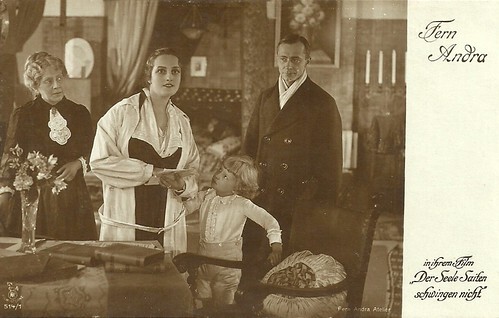
German postcard in the Film-Sterne series by Rotophot, no 514/1. Photo: Fern Andra Atelier. Fern Andra , Alfred Abel and Frida Richard in Der Seele Saiten schwingen nicht / The Strings of the Soul Do Not Vibrate (Ferna Andra, 1917).
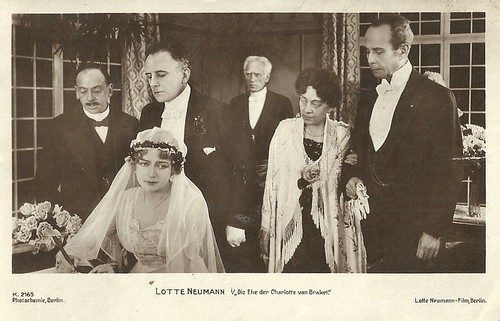
German postcard by Photochemie, no. K. 2165. Photo: Lotte Neumann-Film, Berlin. Lotte Neumann in Die Ehe der Charlotte von Brakel / The Marriage of Charlotte von Brakel (Paul von Woringen, 1918). Her co-stars were Bruno Kastner and Frida Richard. The man behind Neumann is Rudolf Lettinger.
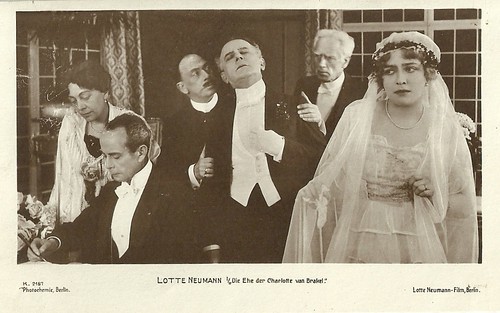
German postcard by Photochemie, no. K. 2167. Photo: Lotte Neumann-Film, Berlin. Lotte Neumann in Die Ehe der Charlotte von Brakel / The Marriage of Charlotte von Brakel (Paul von Woringen, 1918). Her co-stars were Bruno Kastner and Frida Richard. The man collapsing is Rudolf Lettinger.
A rich career as a supporting actress
After the First World War, Frida Richard continued her rich career as a supporting actress in films with Lotte Neumann, like Der Weg der Grete Lessen (1919), with Walter Janssen like Der Tänzer (1919), and Asta Nielsen in Rausch / Intoxication (Ernst Lubitsch, 1919). In the 1920s, Richard played the grandmother in the Expressionist film Von Morgens bis Mitternachts (Karlheinz Martin, 1920), the old princess in Die Erbin von Tordis / The Inheritance of Tordis (Robert Dinesen, 1921) with Ica Lenkeffy , and the manager's wife in Frauenopfer (Karl Grune, 1921) with Henny Porten .
Richard was the protagonist's mother in Phantom (F.W. Murnau, 1922), starring Alfred Abel . Other mother roles were Shylock's mother in Der Kaufmann von Venedig / The Merchant of Venice (Peter Paul Felner, 1923) starring Henny Porten , the fairy godmother in the Cinderella adaptation Der verlorene Schuh / The Lost Shoe (Ludwig Berger, 1923), the pushy mother and grandmother of the mountain guide and his son in Der Berg des Schicksals / Mountain of Destiny (Arnold Fanck, 1923-24), the possessive mother in the Kammerspiel drama Sylvester / New Year's Eve (Lupu Pick, 1924), the mother in the comedy Auf Befehl der Pompadour / By Order of Pompadour (Friedrich Zelnik, 1924) with Lya Mara .
She also played the aunt of Asta Nielsen in Hedda Gabler (Franz Eckstein, 1925), and she had a minor part in the two-part epic Die Nibelungen (Fritz Lang, 1924). Memorable were her parts as Gretchen's mother in Murnau's Faust (Friedrich Wilhelm Murnau, 1926) and the mother in Fancks's Der heilige Berg / The Holy Mountain (Arnold Fanck, 1926). Richard also appeared in two films by Arthur Robison, Pietro, der Korsar / Peter the Pirate (1925) and Manon Lescaut (1925-26).
In the mid-1920s, Richard also acted in Die vom Niederrhein (1925), Der Farmer aus Texas / The Farmer from Texas (Joe May, 1925), Die Wacht am Rhein / Watch on the Rhine (Helene Lackner, 1926), Die Brüder Schellenberg / The Brothers Schellenberg (Karl Grune, 1926), and Wien, wie es weint und lacht / Vienna, How it Cries and Laughs (Rudolf Walther-Fein, Rudolf Dworsky, 1926). In the later 1920s, Richard acted e.g. in the social drama Die Vorbestraften (1927), Das deutsche Lied (1928), Ludwig Berger 's Das brennende Herz (1928-29) with Mady Christians, Die Frau, nach der man sich sehnt (1929) with Marlene Dietrich , Katharina Knie (Karl Grune, 1929) In the early sound era, she appeared in Der Mann, der den Mord beging / The Man Who Murdered (Kurt Bernhardt, 1931) with Conrad Veidt , and the comedy Der Sieger / The Victor (Hans Hinrich, Paul Martin, 1932) with Hans Albers .
In 1932, Frida Richard and her husband moved to Salzburg. Fritz Richard died in Berlin the following year. Frida continued to appear in front of the camera during the Nazi era, even if less frequently, both in Germany, and before and after the Anschluss also in Austrian films. Her films included Der Pfarrer von Kirchfeld / The Priest from Kirchfeld (Jakob Fleck, Luise Fleck, 1937) with Hans Jaray and Der Postmeister (1939) with Heinrich George . During the Second World War, she acted in minor parts in Helmut Käutner 's Auf Wiedersehn, Franziska / Goodbye, Franziska (1941), Rembrandt (Hans Steinhoff, 1942), Die goldene Stadt / (Veit Harlan, 1942) and Leni Riefenstahl's Tiefland (1940-44/1953). In 1944, Richard was included in the Gottbegnadeten list of the Reich Ministry for Popular Enlightenment and Propaganda. Soon after the war, in 1946, Frida Richard died in Salzburg. Richard acted in almost 275 films.
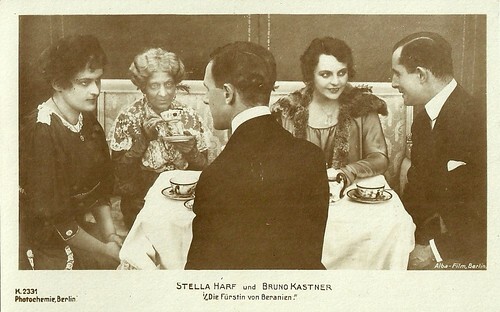
German postcard by Photochemie, Berlin, no. K. 2331. Photo: Alba-Film. Stella Harf and Bruno Kastner in Die Fürstin von Beranien / The Princess of Beranien (Ernst Reicher, 1918). Prince Ernst von Beranien announces his daughter Elisabeth (Stella Harf) will become crown princess. She asks for a last sidestep, and as a 'common countess', she is granted to take a holiday in the mountains, though escorted by the stern countess Elvira (Frida Richard) and her daughter Kitty.
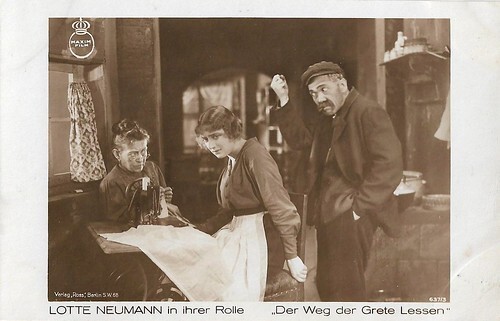
German postcard by Ross Verlag, no. 637/3. Photo: Maxim-Film. Frida Richard, Lotte Neumann , and Georg John in Der Weg der Grete Lessen (Rudolf Biebrach, 1919). Plot: Father Lessen torments his daughter. The film was based on the story 'Arme Mädchen' by Paul Lindau.

German postcard by Ross Verlag, Berlin, no. 51/5. Photo: Koop-Film, Berlin. Walter Slezak as Walter Thiermann, engineer of Franz Großmann, surrounded by his old mother (Frida Richard), his beloved Maria ( Maria Zelenka ), and his sister Renate ( Elza Temary ) in Die Wacht am Rhein. Aus des Rheinlands Schicksalstagen / The Watch on the Rhine. From the fateful days of the Rhineland (Helene Lackner, 1925-1926). Elza is misspelt as Elga here.
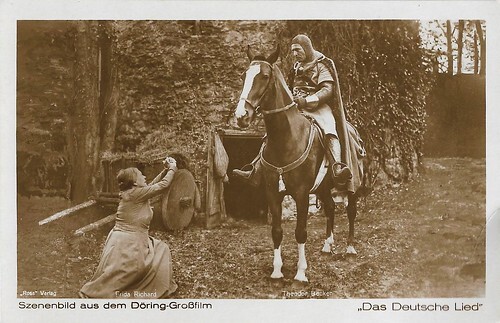
German postcard by Ross Verlag, unnumbered. Photo: Döring film company, Hannover, under guidance [Protektorat] of the Deutsche Sängerbund (DSB). Theodor Becker as Graf Otto von Meran (Otto, Count of Merania) and Frida Richard as Frau Hilde (mother of Walther von der Vogelweide) in the historical part of Das Deutsche Lied / The German Song (Karl Pindl, 1928). The film premiered in Vienna, Austria, at the 10th German Sängerbundesfest 19.-23.July 1928.
Sources: Wikipedia (German and English), Filmportal and .

German postcard by Ross Verlag, unnumbered. Photo: Fox Film.

German collectors card by Ross Verlag in the series Vom Werden Deutscher Filmkunst - Der Stumme Film, no. 45, group 43. Photo: Tobias-Film. Bruno Kastner , Dorrit Weixler and Frida Richard in Dorittchens Vergnügungsreise / Little Dorrit's Pleasure Trip (Paul Heidemann, 1916).

German postcard by Ross Verlag, Berlin, no. 51/4. Photo: Koop Film, Berlin. Walter Slezak as Walter Thiermann, an engineer in the service of industrialist Franz Großmann, surrounded by his old mother (Frida Richard) and his sister Renate ( Elza Temary ) in Die Wacht am Rhein. Aus des Rheinlands Schicksalstagen / The Watch on the Rhine. From the fateful days of the Rhineland (Helene Lackner, 1925-1926). Elza is misspelled as Elga here, and Walter as Walther.

German postcard by Ross Verlag, no. 66/7. Photo: Ufa. Camilla Horn and Frida Richard in Faust (Friedrich Wilhelm Murnau, 1926).
Worried mothers or servants and counsellors
Frida (or Frieda) Richard was born in 1873 as Friederike Raithel in Vienna, Austria-Hungary. She was the daughter of a room painter. Frida attended a theatre school in Vienna. Her fellow students included Max Reinhardt and Fritz Richard, whom she married in 1898. She did not practise her profession at first but became an English teacher.
It was only after she moved to Berlin with her husband in 1905 that she appeared on the theatre stage there from 1908. In addition to Berlin, she also performed in Vienna at the theatres under Max Reinhardt and at the Salzburg Festival.
From 1910, Frida Richard was frequently seen in films, initially often alongside Henny Porten . Richard debuted in Das vierte Gebot (Charles Decroix, 1910), produced by Deutsche Mutoskop- und Biograph. She mostly played worried mothers or servants and counsellors. In such roles, she eventually became one of the busiest supporting actresses of the silent film era.
In the early 1910s, she acted at the companies Duskes, Luna, and, in particular, Messter, where she often co-acted in films with Henny Porten, such as Adressatin verstorben (1911/12), Komtess Ursel (1913), Ihre Hoheit (1913), and Eva (1913). Richard continued co-acting with Porten during the First World War in such films as Nordlandrose (1914), Feeenhande (1916), Gelöste Ketten (1916), Der Liebesbrief der Königin / The Queen's Love Letter (Robert Wiene, 1916), Die Ehe der Luise Rohrbach / The Marriage of Luise Rohrbach (Rudolf Biebrach, 1917), and Das Geschlecht derer von Ringwall / The Ringwall Family (Rudolf Biebrach, 1918).
Richard also co-acted in several Dorrit Weixler films directed by Franz Hofer at Luna and Oliver-Film, in films starring Fern Andra including Ernst ist das Leben (1916), Der Seele Saiten schwingen nicht (1917), and Drohende Wolken am Firmament (1918) - all at Fern-Andra-Film, and in films starring Mia May directed by her husband Joe May , like Ein einsam Grab (1916) and Wogen des Schicksals / Waves of Fate (1918). She also acted in films with Alwin Neuss , Bruno Decarli and Bruno Kastner , such as Kastner's Die Fürstin von Beranien (1918).

German postcard by Rotophot in the Film Sterne series, no. 513/5. Photo: Fern Andra Atelier. Fern Andra in Ernst ist das Leben / Life is Serious (Fern Andra, 1916). The man on the left of Fern Andra could be Fritz Delius . The dying woman in the bed is Frida Richard, who plays Andra's mother in the film.

German postcard in the Film-Sterne series by Rotophot, no 514/1. Photo: Fern Andra Atelier. Fern Andra , Alfred Abel and Frida Richard in Der Seele Saiten schwingen nicht / The Strings of the Soul Do Not Vibrate (Ferna Andra, 1917).

German postcard by Photochemie, no. K. 2165. Photo: Lotte Neumann-Film, Berlin. Lotte Neumann in Die Ehe der Charlotte von Brakel / The Marriage of Charlotte von Brakel (Paul von Woringen, 1918). Her co-stars were Bruno Kastner and Frida Richard. The man behind Neumann is Rudolf Lettinger.

German postcard by Photochemie, no. K. 2167. Photo: Lotte Neumann-Film, Berlin. Lotte Neumann in Die Ehe der Charlotte von Brakel / The Marriage of Charlotte von Brakel (Paul von Woringen, 1918). Her co-stars were Bruno Kastner and Frida Richard. The man collapsing is Rudolf Lettinger.
A rich career as a supporting actress
After the First World War, Frida Richard continued her rich career as a supporting actress in films with Lotte Neumann, like Der Weg der Grete Lessen (1919), with Walter Janssen like Der Tänzer (1919), and Asta Nielsen in Rausch / Intoxication (Ernst Lubitsch, 1919). In the 1920s, Richard played the grandmother in the Expressionist film Von Morgens bis Mitternachts (Karlheinz Martin, 1920), the old princess in Die Erbin von Tordis / The Inheritance of Tordis (Robert Dinesen, 1921) with Ica Lenkeffy , and the manager's wife in Frauenopfer (Karl Grune, 1921) with Henny Porten .
Richard was the protagonist's mother in Phantom (F.W. Murnau, 1922), starring Alfred Abel . Other mother roles were Shylock's mother in Der Kaufmann von Venedig / The Merchant of Venice (Peter Paul Felner, 1923) starring Henny Porten , the fairy godmother in the Cinderella adaptation Der verlorene Schuh / The Lost Shoe (Ludwig Berger, 1923), the pushy mother and grandmother of the mountain guide and his son in Der Berg des Schicksals / Mountain of Destiny (Arnold Fanck, 1923-24), the possessive mother in the Kammerspiel drama Sylvester / New Year's Eve (Lupu Pick, 1924), the mother in the comedy Auf Befehl der Pompadour / By Order of Pompadour (Friedrich Zelnik, 1924) with Lya Mara .
She also played the aunt of Asta Nielsen in Hedda Gabler (Franz Eckstein, 1925), and she had a minor part in the two-part epic Die Nibelungen (Fritz Lang, 1924). Memorable were her parts as Gretchen's mother in Murnau's Faust (Friedrich Wilhelm Murnau, 1926) and the mother in Fancks's Der heilige Berg / The Holy Mountain (Arnold Fanck, 1926). Richard also appeared in two films by Arthur Robison, Pietro, der Korsar / Peter the Pirate (1925) and Manon Lescaut (1925-26).
In the mid-1920s, Richard also acted in Die vom Niederrhein (1925), Der Farmer aus Texas / The Farmer from Texas (Joe May, 1925), Die Wacht am Rhein / Watch on the Rhine (Helene Lackner, 1926), Die Brüder Schellenberg / The Brothers Schellenberg (Karl Grune, 1926), and Wien, wie es weint und lacht / Vienna, How it Cries and Laughs (Rudolf Walther-Fein, Rudolf Dworsky, 1926). In the later 1920s, Richard acted e.g. in the social drama Die Vorbestraften (1927), Das deutsche Lied (1928), Ludwig Berger 's Das brennende Herz (1928-29) with Mady Christians, Die Frau, nach der man sich sehnt (1929) with Marlene Dietrich , Katharina Knie (Karl Grune, 1929) In the early sound era, she appeared in Der Mann, der den Mord beging / The Man Who Murdered (Kurt Bernhardt, 1931) with Conrad Veidt , and the comedy Der Sieger / The Victor (Hans Hinrich, Paul Martin, 1932) with Hans Albers .
In 1932, Frida Richard and her husband moved to Salzburg. Fritz Richard died in Berlin the following year. Frida continued to appear in front of the camera during the Nazi era, even if less frequently, both in Germany, and before and after the Anschluss also in Austrian films. Her films included Der Pfarrer von Kirchfeld / The Priest from Kirchfeld (Jakob Fleck, Luise Fleck, 1937) with Hans Jaray and Der Postmeister (1939) with Heinrich George . During the Second World War, she acted in minor parts in Helmut Käutner 's Auf Wiedersehn, Franziska / Goodbye, Franziska (1941), Rembrandt (Hans Steinhoff, 1942), Die goldene Stadt / (Veit Harlan, 1942) and Leni Riefenstahl's Tiefland (1940-44/1953). In 1944, Richard was included in the Gottbegnadeten list of the Reich Ministry for Popular Enlightenment and Propaganda. Soon after the war, in 1946, Frida Richard died in Salzburg. Richard acted in almost 275 films.

German postcard by Photochemie, Berlin, no. K. 2331. Photo: Alba-Film. Stella Harf and Bruno Kastner in Die Fürstin von Beranien / The Princess of Beranien (Ernst Reicher, 1918). Prince Ernst von Beranien announces his daughter Elisabeth (Stella Harf) will become crown princess. She asks for a last sidestep, and as a 'common countess', she is granted to take a holiday in the mountains, though escorted by the stern countess Elvira (Frida Richard) and her daughter Kitty.

German postcard by Ross Verlag, no. 637/3. Photo: Maxim-Film. Frida Richard, Lotte Neumann , and Georg John in Der Weg der Grete Lessen (Rudolf Biebrach, 1919). Plot: Father Lessen torments his daughter. The film was based on the story 'Arme Mädchen' by Paul Lindau.

German postcard by Ross Verlag, Berlin, no. 51/5. Photo: Koop-Film, Berlin. Walter Slezak as Walter Thiermann, engineer of Franz Großmann, surrounded by his old mother (Frida Richard), his beloved Maria ( Maria Zelenka ), and his sister Renate ( Elza Temary ) in Die Wacht am Rhein. Aus des Rheinlands Schicksalstagen / The Watch on the Rhine. From the fateful days of the Rhineland (Helene Lackner, 1925-1926). Elza is misspelt as Elga here.

German postcard by Ross Verlag, unnumbered. Photo: Döring film company, Hannover, under guidance [Protektorat] of the Deutsche Sängerbund (DSB). Theodor Becker as Graf Otto von Meran (Otto, Count of Merania) and Frida Richard as Frau Hilde (mother of Walther von der Vogelweide) in the historical part of Das Deutsche Lied / The German Song (Karl Pindl, 1928). The film premiered in Vienna, Austria, at the 10th German Sängerbundesfest 19.-23.July 1928.
Sources: Wikipedia (German and English), Filmportal and .
Published on June 01, 2025 22:00
May 31, 2025
Oskar Werner
Talented Austrian actor Oscar Werner (1922-1984) was Jules in François Truffaut’s Nouvelle Vague classic Jules et Jim (1962). He is also known for international films like Ship of Fools (1965), The Spy Who Came in from the Cold (1965), Fahrenheit 451 (1966) and The Shoes of the Fisherman (1968). Werner received an Academy Award nomination and a Golden Globe Award in 1966.
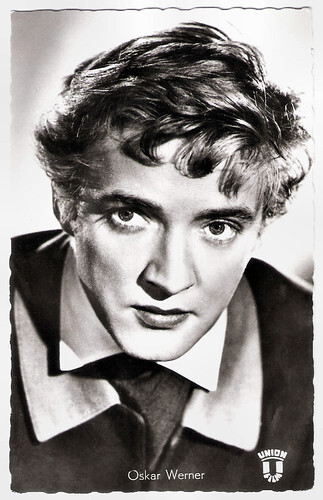
West German postcard by Kolibri-Verlag G.m.b.H., Minden/Westf., no. 1722. Photo: Gamma / Union-Film. Oskar Werner in Lola Montès (Max Ophüls, 1955).
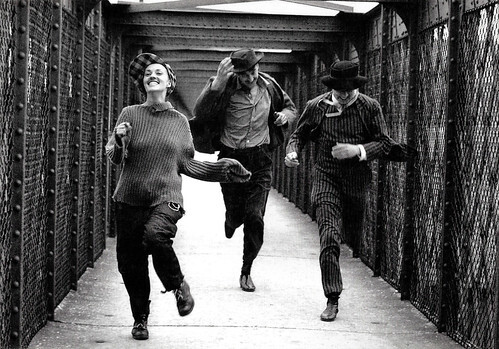
French postcard in the Collection Cinéma by Editions Art & Scene, Paris, no. CF 88. Photo: R. Cauchetier. Jeanne Moreau , Henri Serre and Oskar Werner in Jules et Jim / Jules and Jim (François Truffaut, 1962).
Ripe for film stardom
Oskar Werner or Oscar Werner was born Oskar Josef Schließmayer in Vienna, Austria in 1922. His parents divorced when he was fairly young. Oskar spent much of his childhood in the care of his grandmother, who entertained him with stories about the Burgtheater, the Austrian state theatre. Performing in school plays aroused a deep desire to act. His father (according to Wikipedia) or his uncle (IMDb) helped him to get parts as an extra in films like Geld fällt vom Himmel / Money falls from the sky (Heinz Helbig, 1938) and Hotel Sacher (Erich Engel, 1939).
He decided to drop out of high school to pursue acting roles. In 1940, director Lothar Müthel accepted the then eighteen-year-old as a member of the Burgtheater. Oskar was the youngest person ever to receive this recognition. He made his theatre debut using the stage name Oskar Werner in October 1941. Two months later, Werner was drafted into the Wehrmacht. As a pacifist and staunch opponent of National Socialism, he was determined to avoid advancement in the military. He finagled his way into KP duty, feigning incompetence and was assigned to peeling potatoes and cleaning latrines instead of being sent to the Eastern Front.
In 1944, he secretly married actress Elisabeth Kallina, who was half-Jewish. They immediately had a daughter, Eleanore. That December, he deserted the Wehrmacht and fled with his wife and daughter to the Wienerwald, where they remained in hiding until the end of the war. Werner returned to the Burgtheater and acted in productions at the Raimund Theater and the Theater in der Josefstadt, frequently playing character roles. He made his film debut in Der Engel mit der Posaune / The Angel with the Trumpet (Karl Hartl, 1948). The following year, he portrayed Ludwig van Beethoven's nephew Karl in Eroica (Walter Kolm-Veltée, 1949).
In 1950, Werner journeyed to the United Kingdom to reprise the role he had played in Der Engel mit der Posaune in its English-language version, The Angel with the Trumpet, under the direction of Anthony Bushell. He and his wife divorced at about this time but remained friends. He appeared in a few more German–Austrian films before going to Hollywood for a lead role as a German prisoner of war in the war film Decision Before Dawn (Anatole Litvak, 1951) opposite Richard Baseheart . The 20th Century Fox production was nominated for Academy Awards for Best Film Editing and Best Picture. He was ripe for film stardom, but the subsequent roles promised by the studio failed to materialise. Hurt and disappointed, Werner returned to Europe and settled in Triesen, Liechtenstein, in a home he designed and built with a friend.
He returned to the stage, and during the 1950s, he performed in 'Hamlet', 'Danton's Death', 'Henry IV', 'Henry V', 'Torquato Tasso', and 'Becket', among others. In 1954, he married Anne Power, the daughter of French actress Annabella and adopted daughter of Tyrone Power . After a period of inactivity in the cinema, Werner appeared in five films in 1955, among them the war drama Der letzte Akt / The Last Ten Days (Georg Wilhelm Pabst, 1955) about Hitler’s last ten days, Mozart / The Life and Loves of Mozart (Karl Hartl, 1955), in which he played the title role, and Lola Montès (Max Ophüls, 1955) as a student opposite Martine Carol . Gary Brumburgh describes him at IMDb as “An aloof, handsome blond with wide-set, hooded eyes and quietly solemn features”. Despite his good looks and obvious talent, it would take seven more years before he began to draw critical acclaim and international recognition in the cinema.
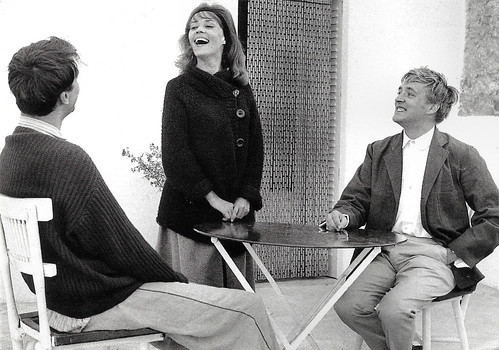
French postcard in the Collection Cinéma by Editions Art & Scene, Paris, no. CF 891996. Photo: R. Cauchetier. Jeanne Moreau , Oskar Werner and Henri Serre (left) in Jules et Jim/Jules and Jim (François Truffaut, 1962).
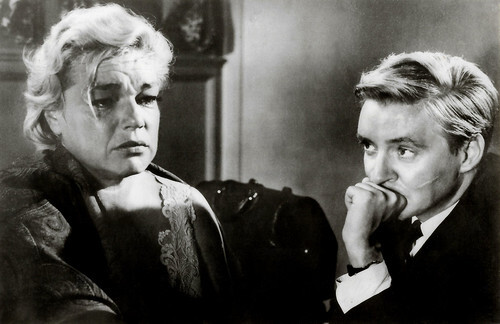
Romanian postcard by Casa Filmului Acin, no. 472. Simone Signoret and Oskar Werner in Ship of Fools (Stanley Kramer, 1965).
An international sensation
In 1962, Oskar Werner’s final breakthrough came with the French film Jules et Jim / Jules and Jim (François Truffaut, 1962), based on Henri-Pierre Roché's semi-autobiographical novel about his relationship with writer Franz Hessel and his wife, Helen Grund. He became an international sensation as the highly romantic and intellectual Austrian Jules who falls in love with the same woman, Catherine ( Jeanne Moreau ), as his best friend Jim (Henri Serre). Jules et Jim is one of the seminal products of the Nouvelle Vague, the French New Wave. Wikipedia describes it as “an inventive encyclopedia of the language of cinema that incorporates newsreel footage, photographic stills, freeze frames, panning shots, wipes, masking, dolly shots, and voiceover narration (by Michel Subor ).”
Werner's then portrayed the philosophical Dr. Schumann in Ship of Fools (Stanley Kramer 1965), which recounts the overlapping stories of several passengers aboard an ocean liner bound to Germany from Mexico in 1933. His role won him the New York Film Critics Circle Award for Best Actor and nominations for the Academy Award for Best Actor, the Golden Globe Award for Best Actor – Motion Picture Drama, and the BAFTA Award for Best Foreign Actor. Gary Brumburgh at IMDb describes Werner’s style as “remote, rather morose and, as a result, intriguing“.
His portrayal of Jewish East German spy Fiedler in The Spy Who Came in from the Cold (Martin Ritt, 1965) won him another Golden Globe Award and his second BAFTA nomination. In 1966, he played book-burning fireman Guy Montag in François Truffaut 's film adaptation of the cult-classic 'Fahrenheit 451' by Ray Bradbury. The relationship with Truffaut was irreparably damaged over artistic differences while filming. The unhappiness of that film experience triggered an already burgeoning drinking problem and the decline of his career.
Werner next played an orchestra conductor in the British drama Interlude (Kevin Billington, 1968) and a Vatican priest loosely based on Pierre Teilhard de Chardin in the American drama The Shoes of the Fisherman (Michael Anderson, 1968). That same year, he divorced Power and put his film career on hold. He returned to the stage and spent time travelling in Israel, Italy, Malta, France, and the United States. He appeared in an episode of the TV series Columbo (Bernard L. Kowalski, 1975) featuring Peter Falk, and the following year he made his final screen appearance in Voyage of the Damned (Stuart Rosenberg, 1976) as Faye Dunaway ’s Jewish husband. The story was inspired by true events concerning the fate of the MS St. Louis ocean liner carrying Jewish refugees from Germany to Cuba in 1939. For his part, he received another Golden Globe nomination.
Werner was an alcoholic, which was a deciding factor in the decline of his health and career. He lived most of the time retired in his house in Liechtenstein. His last stage appearance was in a 1983 production of 'The Prince of Homburg', and his last public appearance was at the Mozart Hall in Salzburg ten days before his death. On 22 October 1984, Werner cancelled a reading at the Hotel Europäischer Hof in Marburg because he was feeling ill. He was found dead of a heart attack the following morning, only two days after François Truffaut had died. Oskar Werner was 61. He is buried in his adopted country of Liechtenstein. He had two children: his daughter Elinore (1944) with Elisabeth Kallina, and son Felix (1966) with the American model Diane Anderson.
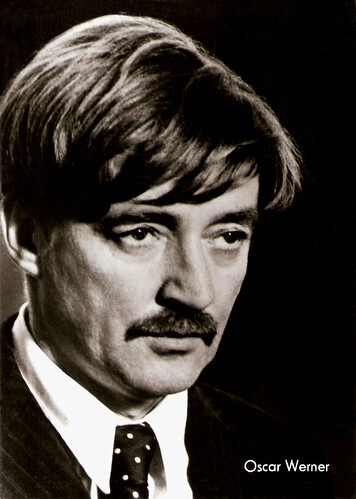
East-German postcard by VEB Progress Filmvertrieb, Berlin, no. 12/80, 1979. Oskar Werner in Voyage of the Damned (Stuart Rosenberg, 1976).
Sources: (IMDb), Wikipedia, and .

West German postcard by Kolibri-Verlag G.m.b.H., Minden/Westf., no. 1722. Photo: Gamma / Union-Film. Oskar Werner in Lola Montès (Max Ophüls, 1955).

French postcard in the Collection Cinéma by Editions Art & Scene, Paris, no. CF 88. Photo: R. Cauchetier. Jeanne Moreau , Henri Serre and Oskar Werner in Jules et Jim / Jules and Jim (François Truffaut, 1962).
Ripe for film stardom
Oskar Werner or Oscar Werner was born Oskar Josef Schließmayer in Vienna, Austria in 1922. His parents divorced when he was fairly young. Oskar spent much of his childhood in the care of his grandmother, who entertained him with stories about the Burgtheater, the Austrian state theatre. Performing in school plays aroused a deep desire to act. His father (according to Wikipedia) or his uncle (IMDb) helped him to get parts as an extra in films like Geld fällt vom Himmel / Money falls from the sky (Heinz Helbig, 1938) and Hotel Sacher (Erich Engel, 1939).
He decided to drop out of high school to pursue acting roles. In 1940, director Lothar Müthel accepted the then eighteen-year-old as a member of the Burgtheater. Oskar was the youngest person ever to receive this recognition. He made his theatre debut using the stage name Oskar Werner in October 1941. Two months later, Werner was drafted into the Wehrmacht. As a pacifist and staunch opponent of National Socialism, he was determined to avoid advancement in the military. He finagled his way into KP duty, feigning incompetence and was assigned to peeling potatoes and cleaning latrines instead of being sent to the Eastern Front.
In 1944, he secretly married actress Elisabeth Kallina, who was half-Jewish. They immediately had a daughter, Eleanore. That December, he deserted the Wehrmacht and fled with his wife and daughter to the Wienerwald, where they remained in hiding until the end of the war. Werner returned to the Burgtheater and acted in productions at the Raimund Theater and the Theater in der Josefstadt, frequently playing character roles. He made his film debut in Der Engel mit der Posaune / The Angel with the Trumpet (Karl Hartl, 1948). The following year, he portrayed Ludwig van Beethoven's nephew Karl in Eroica (Walter Kolm-Veltée, 1949).
In 1950, Werner journeyed to the United Kingdom to reprise the role he had played in Der Engel mit der Posaune in its English-language version, The Angel with the Trumpet, under the direction of Anthony Bushell. He and his wife divorced at about this time but remained friends. He appeared in a few more German–Austrian films before going to Hollywood for a lead role as a German prisoner of war in the war film Decision Before Dawn (Anatole Litvak, 1951) opposite Richard Baseheart . The 20th Century Fox production was nominated for Academy Awards for Best Film Editing and Best Picture. He was ripe for film stardom, but the subsequent roles promised by the studio failed to materialise. Hurt and disappointed, Werner returned to Europe and settled in Triesen, Liechtenstein, in a home he designed and built with a friend.
He returned to the stage, and during the 1950s, he performed in 'Hamlet', 'Danton's Death', 'Henry IV', 'Henry V', 'Torquato Tasso', and 'Becket', among others. In 1954, he married Anne Power, the daughter of French actress Annabella and adopted daughter of Tyrone Power . After a period of inactivity in the cinema, Werner appeared in five films in 1955, among them the war drama Der letzte Akt / The Last Ten Days (Georg Wilhelm Pabst, 1955) about Hitler’s last ten days, Mozart / The Life and Loves of Mozart (Karl Hartl, 1955), in which he played the title role, and Lola Montès (Max Ophüls, 1955) as a student opposite Martine Carol . Gary Brumburgh describes him at IMDb as “An aloof, handsome blond with wide-set, hooded eyes and quietly solemn features”. Despite his good looks and obvious talent, it would take seven more years before he began to draw critical acclaim and international recognition in the cinema.

French postcard in the Collection Cinéma by Editions Art & Scene, Paris, no. CF 891996. Photo: R. Cauchetier. Jeanne Moreau , Oskar Werner and Henri Serre (left) in Jules et Jim/Jules and Jim (François Truffaut, 1962).

Romanian postcard by Casa Filmului Acin, no. 472. Simone Signoret and Oskar Werner in Ship of Fools (Stanley Kramer, 1965).
An international sensation
In 1962, Oskar Werner’s final breakthrough came with the French film Jules et Jim / Jules and Jim (François Truffaut, 1962), based on Henri-Pierre Roché's semi-autobiographical novel about his relationship with writer Franz Hessel and his wife, Helen Grund. He became an international sensation as the highly romantic and intellectual Austrian Jules who falls in love with the same woman, Catherine ( Jeanne Moreau ), as his best friend Jim (Henri Serre). Jules et Jim is one of the seminal products of the Nouvelle Vague, the French New Wave. Wikipedia describes it as “an inventive encyclopedia of the language of cinema that incorporates newsreel footage, photographic stills, freeze frames, panning shots, wipes, masking, dolly shots, and voiceover narration (by Michel Subor ).”
Werner's then portrayed the philosophical Dr. Schumann in Ship of Fools (Stanley Kramer 1965), which recounts the overlapping stories of several passengers aboard an ocean liner bound to Germany from Mexico in 1933. His role won him the New York Film Critics Circle Award for Best Actor and nominations for the Academy Award for Best Actor, the Golden Globe Award for Best Actor – Motion Picture Drama, and the BAFTA Award for Best Foreign Actor. Gary Brumburgh at IMDb describes Werner’s style as “remote, rather morose and, as a result, intriguing“.
His portrayal of Jewish East German spy Fiedler in The Spy Who Came in from the Cold (Martin Ritt, 1965) won him another Golden Globe Award and his second BAFTA nomination. In 1966, he played book-burning fireman Guy Montag in François Truffaut 's film adaptation of the cult-classic 'Fahrenheit 451' by Ray Bradbury. The relationship with Truffaut was irreparably damaged over artistic differences while filming. The unhappiness of that film experience triggered an already burgeoning drinking problem and the decline of his career.
Werner next played an orchestra conductor in the British drama Interlude (Kevin Billington, 1968) and a Vatican priest loosely based on Pierre Teilhard de Chardin in the American drama The Shoes of the Fisherman (Michael Anderson, 1968). That same year, he divorced Power and put his film career on hold. He returned to the stage and spent time travelling in Israel, Italy, Malta, France, and the United States. He appeared in an episode of the TV series Columbo (Bernard L. Kowalski, 1975) featuring Peter Falk, and the following year he made his final screen appearance in Voyage of the Damned (Stuart Rosenberg, 1976) as Faye Dunaway ’s Jewish husband. The story was inspired by true events concerning the fate of the MS St. Louis ocean liner carrying Jewish refugees from Germany to Cuba in 1939. For his part, he received another Golden Globe nomination.
Werner was an alcoholic, which was a deciding factor in the decline of his health and career. He lived most of the time retired in his house in Liechtenstein. His last stage appearance was in a 1983 production of 'The Prince of Homburg', and his last public appearance was at the Mozart Hall in Salzburg ten days before his death. On 22 October 1984, Werner cancelled a reading at the Hotel Europäischer Hof in Marburg because he was feeling ill. He was found dead of a heart attack the following morning, only two days after François Truffaut had died. Oskar Werner was 61. He is buried in his adopted country of Liechtenstein. He had two children: his daughter Elinore (1944) with Elisabeth Kallina, and son Felix (1966) with the American model Diane Anderson.

East-German postcard by VEB Progress Filmvertrieb, Berlin, no. 12/80, 1979. Oskar Werner in Voyage of the Damned (Stuart Rosenberg, 1976).
Sources: (IMDb), Wikipedia, and .
Published on May 31, 2025 22:00
May 30, 2025
La Collectionneuse: Virginia Bruce
Dreamy-eyed beauty Virginia Bruce had her first big break in the mid-1930s. From then on, she was featured in about forty films until the mid-1940s, but didn’t reach the highest echelon of movie stars. Nevertheless, this lovely, cooperative, hard-working and versatile actress was a welcome addition to any cast. For the record, Virginia Bruce introduced the standard 'I’ve Got You Under My Skin' in Born to Dance (1936) and was probably the first American movie star to appear in a Turkish film.
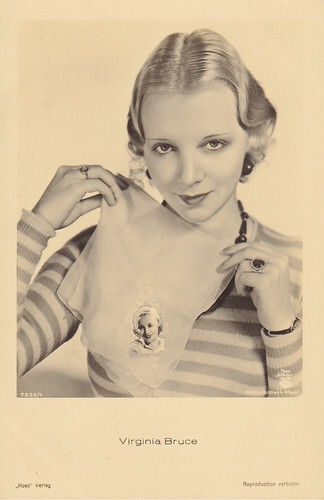
German postcard by Ross Verlag, no. 6666/1, 1931-1932. Photo: Metro Goldwyn Mayer.
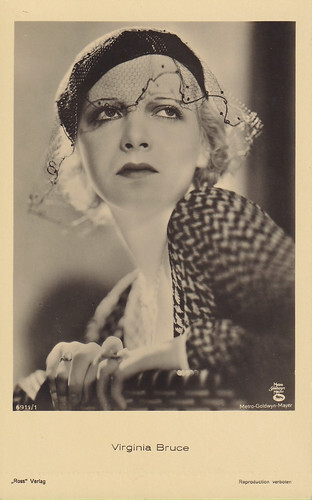
German postcard by Ross Verlag, no. 6911/1, 1931-1932. Photo: Metro Goldwyn Mayer.
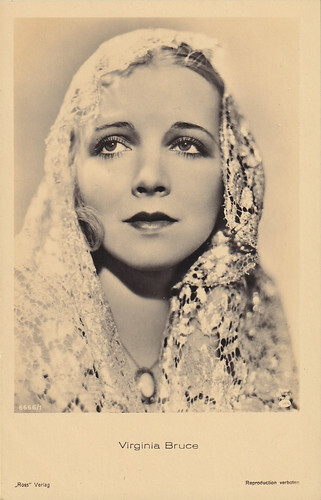
German postcard by Ross Verlag, no. 7235/1, 1932-1933. Photo: Metro Goldwyn Mayer.
Unassuming beginnings in small parts
Virginia Bruce was born as Helen Virginia Briggs on the 29th of September 1910 in Minneapolis, U.S.A. She spent her childhood and her teenage years in Fargo.
After her father’s career as an insurance broker had faltered, the family relocated to Los Angeles in 1928, where the young girl was noticed by director William Beaudine.
Beaudine gave her bit parts in two of his movies, Fugitives (1929) and Hard to Get (1929), and then advised her to go to Paramount, which soon signed her. Unfortunately, they only used her in walk-ons and supporting roles and would let her go in 1930.
She then decided to try her luck on Broadway, where she appeared as a chorus girl in Florenz Ziegfeld’s musical 'Smiles' (November 1930 - January 1931). She then got a minor role in 'America’s Sweetheart' (February 1931 - June 1931). After the show closed, she headed back to Hollywood for a visit.
Agent Nat Goldstone spotted her and lined up a screen test for her at M.G.M., which offered her a long-term contract in August 1931.
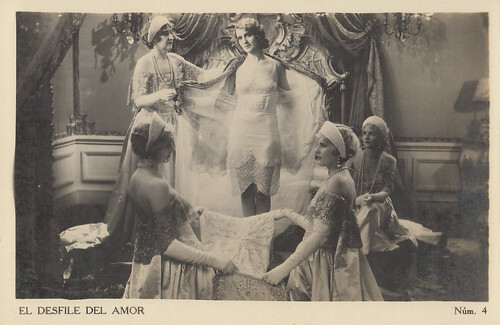
Spanish postcard, no. 4. Jeanette MacDonald in The Love Parade (Ernst Lubitsch, 1929). Virginia Bruce, on the front left, is one of MacDonald’s four ladies-in-waiting.
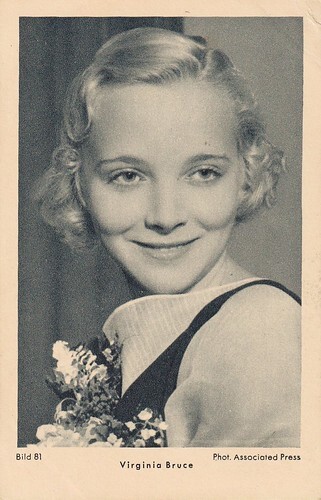
German postcard by Eidelsan, Series II, Image 81. Photo: Associated Press.
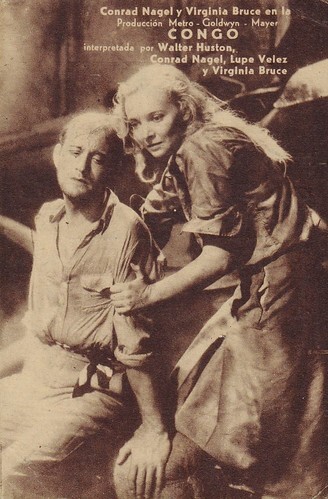
Spanish promotional postcard issued by the Royal Cinema in Valencia. Virginia Bruce and Conrad Nagel in Kongo (William J. Cowen, 1932).
John Gilbert
It was on loan-out to Warner that Virginia Bruce got her most interesting offer so far in Winner Takes All (1932), as a thrill-seeking and two-timing society girl, opposite James Cagney .
At M.G.M., she was then John Gilbert ’s leading lady in Downstairs (1932). They fell in love and married in August 1932, when Virginia was filming Kongo (1932), a remake of the Lon Chaney vehicle West of Zanzibar (1928). Upon its release, the film was considered too gruesome and grim by many critics.
She gave birth to a daughter, Susan Ann, in August 1933. But John Gilbert was at the time a troubled man, whose career was in decline. They separated in January 1934 and divorced a few months later.
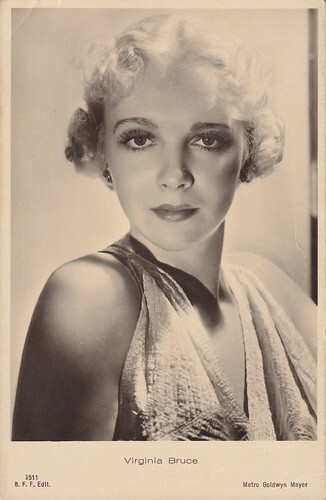
Italian postcard by Ballerini & Fratini, Firenze (B.F.F.), no. 3511. Photo: Metro Goldwyn Mayer.
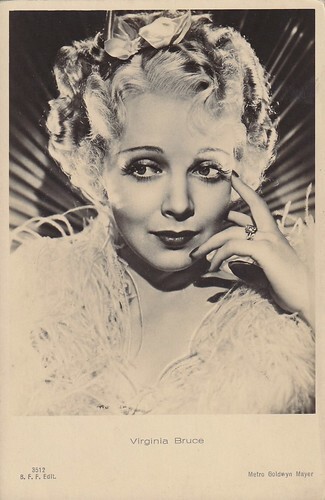
Italian postcard by Ballerini & Fratini, Firenze (B.F.F.), no. 3512. Photo: Metro Goldwyn Mayer.
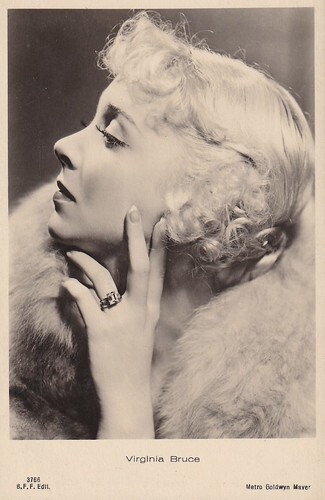
Italian postcard by Ballerini & Fratini, Firenze (B.F.F.), no. 3766. Photo: Metro Goldwyn Mayer.
Virginia’s ascent
When Virginia Bruce came back to movies, she was loaned to Monogram for the title role in Jane Eyre (1934), adapted from Charlotte Brontë’s novel, to R.K.O. for Dangerous Corner (1934) and to United Artists for The Mighty Barnum (1934), as opera singer Jenny Lind. The latter especially brought her good reviews, which praised her loveliness and perfect lip-synch to an operatic aria.
M.G.M. finally took notice and decided to team her with up-and-coming Robert Taylor in Society Doctor (1935) and Times Square Lady (1935). She also notably co-starred with Spencer Tracy in The Murder Man (1935). Among her other 1935 films were the whodunit Shadow of Doubt and Escapade, a lavish remake of the German film Maskerade (1934), as a willing-to-philander married lady.
1936 was an important year for Virginia, as she appeared in two prestigious productions: The Great Ziegfeld, as an ambitious and alcoholic Follies girl, and Born to Dance, in which she played a Broadway star and introduced the famous standard 'I’ve Got You Under My Skin'.
She even recorded it for Brunswick Company. The Cole Porter song had originally been slated for vocalist Frances Langford, but M.G.M. finally gave it to Virginia, whose career was in the ascent and who had a pleasant and warm singing voice.
Bruce was then top-billed in Women of Glamour (1937) at Columbia and When Love is Young (1937) at Universal.
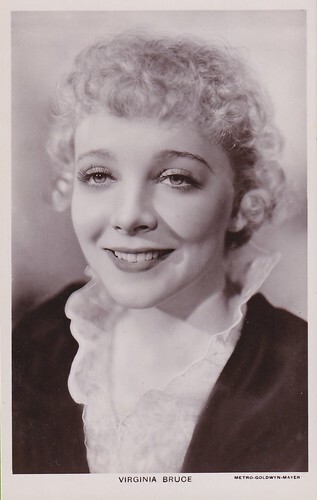
British postcard by Picturegoer, no. 941. Photo: Metro Goldwyn Mayer.
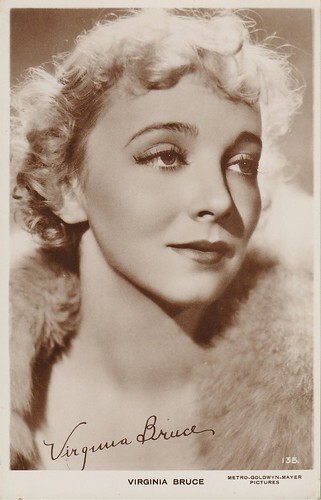
British postcard by Milton, no. 135. Photo: Metro Goldwyn Mayer.
An actress not consumed with ambition and content to get steady work
Virginia Bruce also played opposite, among others, Robert Montgomery in The First Hundred Years (1938) and Yellow Jack (1938), Herbert Marshall in Woman Againt Woman (1938), Melvyn Douglas in Arsene Lupin Returns (1938) and There’s That Woman Again (1939), Fredric March in There Goes My Heart (1938), Walter Pidgeon in Society Lawyer (1939) and Stronger Than Desire (1939) or Nelson Eddy in Let Freedom Ring (1939).
In 1939, her M.G.M. contract ended. Despite all their promises, the company had never offered Virginia a real opportunity to turn into an A-grade star. The actress herself admitted that she lacked ambition and that she had never really fought for better roles, as she was content to get steady work and income.
She pursued her career for other studios such as Warner for Flight Angels (1940) and The Man Who Talked Too Much (1940), Universal for The Invisible Woman (1940) and Butch Minds the Baby (1942), Columbia for Adventure in Washington (1941) or 20th Century Fox for Careful, Soft Shoulders (1942).
Since 1937, she had been married to director J. Walter Ruben and they had a son, Christopher, in 1941. Her husband died of a heart ailment on the 4th of September 1942.
Virginia Bruce came back to the screen in R.K.O.’s Action in Arabia (1944) and then went to Republic for Brazil (1945), a musical opposite famous Mexican singer Tito Guizar, and Love, Honor and Goodbye (1945).
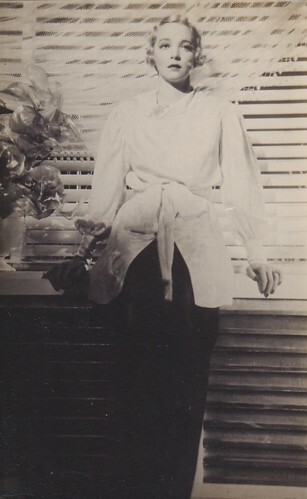
Spanish postcard by Apolo, Madrid.
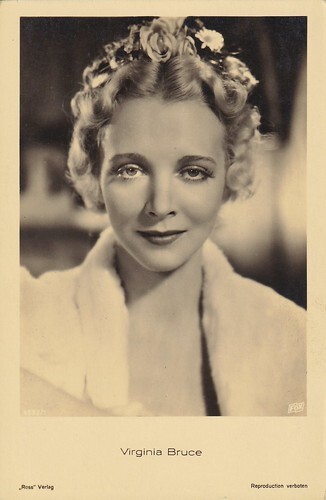
German postcard by Ross Verlag, no. 9592/1, 1935-1936. Photo: Fox.
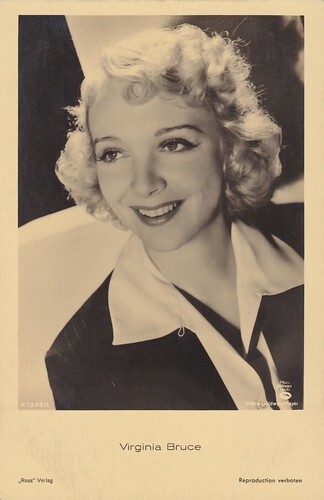
German postcard by Ross Verlag, no. A 1389/1, 1937-1938. Photo: Metro Goldwyn Mayer.
Ali Ipar
In January 1946, Virginia Bruce went to Mexico to star in Accusation, a movie which was to be produced by Ali Ipar. It was never made but a love affair soon blossomed.
Ipar was Turkish, came from a wealthy family and lived in the U.S.A. since 1940. On the 27th of August 1946, Virginia and Ali married.
In 1948, she had a supporting role at Paramount in Night Has a Thousand Eyes (1948), which starred Edward G. Robinson and Gail Russell . Then she went to Poverty Row’s Sigmund Neufeld Productions for the Film Noir State Department: File 649 (1949).
In 1950, Virginia and Ali relocated to Turkey, where he soon was called up to do his compulsary military service. As, according to Turkish laws, no man married to a foreigner could get an officer’s commission, Virginia and Ali divorced in July 1951, so that he could escape a plain soldier’s plight and become a lieutenant.
After he had been discharged from the army in October 1952, Virginia and Ali remarried in Istanbul on the 13th of November.
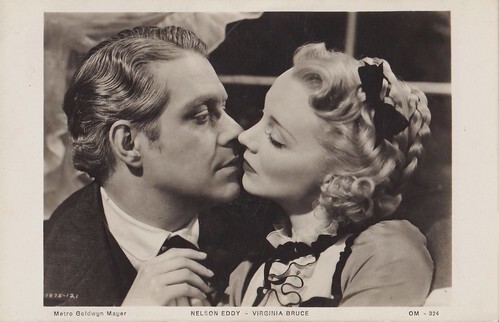
Spanish postcard by Infonal, no. OM-324. Photo: Metro Goldwyn Mayer. Virginia Bruce and Nelson Eddy in Let Freedom Ring (Jack Conway, 1939).
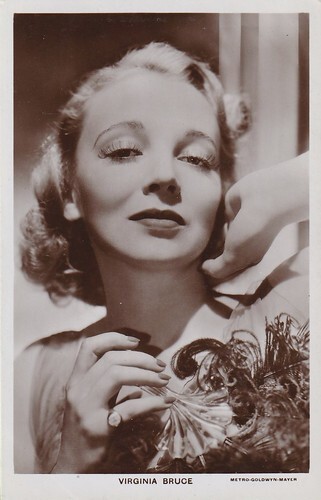
British postcard by Picturegoer, no. 941a. Photo: Metro Goldwyn Mayer.
Last appearances on screen and on television
During her stay in Istanbul, Virginia Bruce starred in the Turkish film Salgin, written, directed and produced by Ali Ipar. It was filmed in 1952 but was only released in 1954.
Virginia went back to the U.S.A. at the end of 1952 and was soon joined by Ali. For the rest of the 1950s, Virginia, who had performed regularly on radio in the 1940s, turned to television. She appeared in such shows as Lux Video Theatre, The Loretta Young Show, Studio 57 and Ford Television Theatre. She also starred in the British film The Reluctant Bride (1955) and made her final big screen appearance as Kim Novak ’s mother in Strangers When We Meet (1960).
For several years, her husband made several trips to Istanbul, but one of these caused him much trouble. He was in his native land when Prime Minister Adnan Menderes was overthrown by a military coup on the 27th of May 1960. Ali, who had been close to Menderes, was arrested and spent some time in prison.
In February 1962, he was released and arrived in the U.S.A. in August. But his marriage to Virginia was in shambles and the divorce was granted by a Turkish court in 1964. Unfortunately for Virginia, Turkish laws regulating matrimonial property were in favour of the husband and her financial loss was significant.
In the 1960s, Virginia Bruce allegedly took to drinking. Her final years were plagued by ill health, and she notably broke her hip after a fall in 1973. She died of cancer on the 24th of February 1982 in the Los Angeles Motion Picture Country Home and Hospital.

British postcard in the Colourgraph series, London, no. C281. Photo: Paramount.

British postcard in the Colourgraph series, London, no. C281a. Photo: Metro Goldwyn Mayer.
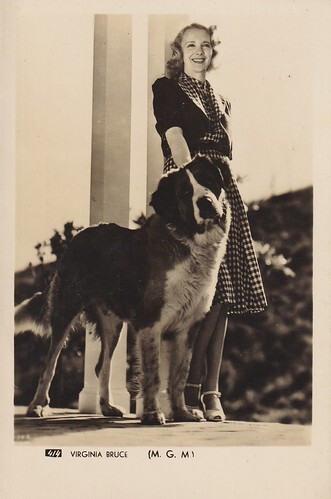
Spanish postcard no. 414. Photo: Metro Goldwyn Mayer.
Virginia as Madame Wang?
Curiously enough, IMDb and Wikipedia list Paul Morrissey’s Madame Wang’s (1981) as Virginia’s last movie.
According to those sources, Bruce would have played the owner of a punk nightclub.
But the role of Madame Wang was in fact played by a male cross-dresser, who used the pseudonym of 'Virginia Bruce'. This is pretty obvious when you watch the movie.
We probably will never know if the real Virginia Bruce had ever been aware of this film and of its surprising casting.
For the record, Virginia Prince a.k.a. Virginia Bruce (1912-2009) was born as Arnold Lowman and published the American magazine Transvestia from 1960 to 1980.
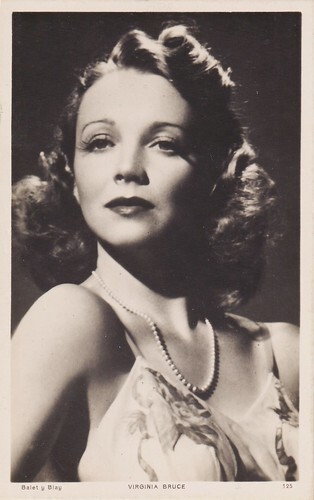
Spanish postcard by Editorial Gloria Mill-Aroyo, Barcelona, no. 125. Photo: Balet y Blay.

Dutch postcard by J.S.A., no. 18.
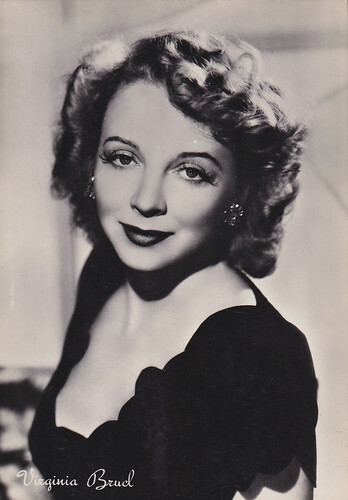
Italian postcard by Rotalfoto, no. 269.
Text and postcards: Marlene Pilaete.

German postcard by Ross Verlag, no. 6666/1, 1931-1932. Photo: Metro Goldwyn Mayer.

German postcard by Ross Verlag, no. 6911/1, 1931-1932. Photo: Metro Goldwyn Mayer.

German postcard by Ross Verlag, no. 7235/1, 1932-1933. Photo: Metro Goldwyn Mayer.
Unassuming beginnings in small parts
Virginia Bruce was born as Helen Virginia Briggs on the 29th of September 1910 in Minneapolis, U.S.A. She spent her childhood and her teenage years in Fargo.
After her father’s career as an insurance broker had faltered, the family relocated to Los Angeles in 1928, where the young girl was noticed by director William Beaudine.
Beaudine gave her bit parts in two of his movies, Fugitives (1929) and Hard to Get (1929), and then advised her to go to Paramount, which soon signed her. Unfortunately, they only used her in walk-ons and supporting roles and would let her go in 1930.
She then decided to try her luck on Broadway, where she appeared as a chorus girl in Florenz Ziegfeld’s musical 'Smiles' (November 1930 - January 1931). She then got a minor role in 'America’s Sweetheart' (February 1931 - June 1931). After the show closed, she headed back to Hollywood for a visit.
Agent Nat Goldstone spotted her and lined up a screen test for her at M.G.M., which offered her a long-term contract in August 1931.

Spanish postcard, no. 4. Jeanette MacDonald in The Love Parade (Ernst Lubitsch, 1929). Virginia Bruce, on the front left, is one of MacDonald’s four ladies-in-waiting.

German postcard by Eidelsan, Series II, Image 81. Photo: Associated Press.

Spanish promotional postcard issued by the Royal Cinema in Valencia. Virginia Bruce and Conrad Nagel in Kongo (William J. Cowen, 1932).
John Gilbert
It was on loan-out to Warner that Virginia Bruce got her most interesting offer so far in Winner Takes All (1932), as a thrill-seeking and two-timing society girl, opposite James Cagney .
At M.G.M., she was then John Gilbert ’s leading lady in Downstairs (1932). They fell in love and married in August 1932, when Virginia was filming Kongo (1932), a remake of the Lon Chaney vehicle West of Zanzibar (1928). Upon its release, the film was considered too gruesome and grim by many critics.
She gave birth to a daughter, Susan Ann, in August 1933. But John Gilbert was at the time a troubled man, whose career was in decline. They separated in January 1934 and divorced a few months later.

Italian postcard by Ballerini & Fratini, Firenze (B.F.F.), no. 3511. Photo: Metro Goldwyn Mayer.

Italian postcard by Ballerini & Fratini, Firenze (B.F.F.), no. 3512. Photo: Metro Goldwyn Mayer.

Italian postcard by Ballerini & Fratini, Firenze (B.F.F.), no. 3766. Photo: Metro Goldwyn Mayer.
Virginia’s ascent
When Virginia Bruce came back to movies, she was loaned to Monogram for the title role in Jane Eyre (1934), adapted from Charlotte Brontë’s novel, to R.K.O. for Dangerous Corner (1934) and to United Artists for The Mighty Barnum (1934), as opera singer Jenny Lind. The latter especially brought her good reviews, which praised her loveliness and perfect lip-synch to an operatic aria.
M.G.M. finally took notice and decided to team her with up-and-coming Robert Taylor in Society Doctor (1935) and Times Square Lady (1935). She also notably co-starred with Spencer Tracy in The Murder Man (1935). Among her other 1935 films were the whodunit Shadow of Doubt and Escapade, a lavish remake of the German film Maskerade (1934), as a willing-to-philander married lady.
1936 was an important year for Virginia, as she appeared in two prestigious productions: The Great Ziegfeld, as an ambitious and alcoholic Follies girl, and Born to Dance, in which she played a Broadway star and introduced the famous standard 'I’ve Got You Under My Skin'.
She even recorded it for Brunswick Company. The Cole Porter song had originally been slated for vocalist Frances Langford, but M.G.M. finally gave it to Virginia, whose career was in the ascent and who had a pleasant and warm singing voice.
Bruce was then top-billed in Women of Glamour (1937) at Columbia and When Love is Young (1937) at Universal.

British postcard by Picturegoer, no. 941. Photo: Metro Goldwyn Mayer.

British postcard by Milton, no. 135. Photo: Metro Goldwyn Mayer.
An actress not consumed with ambition and content to get steady work
Virginia Bruce also played opposite, among others, Robert Montgomery in The First Hundred Years (1938) and Yellow Jack (1938), Herbert Marshall in Woman Againt Woman (1938), Melvyn Douglas in Arsene Lupin Returns (1938) and There’s That Woman Again (1939), Fredric March in There Goes My Heart (1938), Walter Pidgeon in Society Lawyer (1939) and Stronger Than Desire (1939) or Nelson Eddy in Let Freedom Ring (1939).
In 1939, her M.G.M. contract ended. Despite all their promises, the company had never offered Virginia a real opportunity to turn into an A-grade star. The actress herself admitted that she lacked ambition and that she had never really fought for better roles, as she was content to get steady work and income.
She pursued her career for other studios such as Warner for Flight Angels (1940) and The Man Who Talked Too Much (1940), Universal for The Invisible Woman (1940) and Butch Minds the Baby (1942), Columbia for Adventure in Washington (1941) or 20th Century Fox for Careful, Soft Shoulders (1942).
Since 1937, she had been married to director J. Walter Ruben and they had a son, Christopher, in 1941. Her husband died of a heart ailment on the 4th of September 1942.
Virginia Bruce came back to the screen in R.K.O.’s Action in Arabia (1944) and then went to Republic for Brazil (1945), a musical opposite famous Mexican singer Tito Guizar, and Love, Honor and Goodbye (1945).

Spanish postcard by Apolo, Madrid.

German postcard by Ross Verlag, no. 9592/1, 1935-1936. Photo: Fox.

German postcard by Ross Verlag, no. A 1389/1, 1937-1938. Photo: Metro Goldwyn Mayer.
Ali Ipar
In January 1946, Virginia Bruce went to Mexico to star in Accusation, a movie which was to be produced by Ali Ipar. It was never made but a love affair soon blossomed.
Ipar was Turkish, came from a wealthy family and lived in the U.S.A. since 1940. On the 27th of August 1946, Virginia and Ali married.
In 1948, she had a supporting role at Paramount in Night Has a Thousand Eyes (1948), which starred Edward G. Robinson and Gail Russell . Then she went to Poverty Row’s Sigmund Neufeld Productions for the Film Noir State Department: File 649 (1949).
In 1950, Virginia and Ali relocated to Turkey, where he soon was called up to do his compulsary military service. As, according to Turkish laws, no man married to a foreigner could get an officer’s commission, Virginia and Ali divorced in July 1951, so that he could escape a plain soldier’s plight and become a lieutenant.
After he had been discharged from the army in October 1952, Virginia and Ali remarried in Istanbul on the 13th of November.

Spanish postcard by Infonal, no. OM-324. Photo: Metro Goldwyn Mayer. Virginia Bruce and Nelson Eddy in Let Freedom Ring (Jack Conway, 1939).

British postcard by Picturegoer, no. 941a. Photo: Metro Goldwyn Mayer.
Last appearances on screen and on television
During her stay in Istanbul, Virginia Bruce starred in the Turkish film Salgin, written, directed and produced by Ali Ipar. It was filmed in 1952 but was only released in 1954.
Virginia went back to the U.S.A. at the end of 1952 and was soon joined by Ali. For the rest of the 1950s, Virginia, who had performed regularly on radio in the 1940s, turned to television. She appeared in such shows as Lux Video Theatre, The Loretta Young Show, Studio 57 and Ford Television Theatre. She also starred in the British film The Reluctant Bride (1955) and made her final big screen appearance as Kim Novak ’s mother in Strangers When We Meet (1960).
For several years, her husband made several trips to Istanbul, but one of these caused him much trouble. He was in his native land when Prime Minister Adnan Menderes was overthrown by a military coup on the 27th of May 1960. Ali, who had been close to Menderes, was arrested and spent some time in prison.
In February 1962, he was released and arrived in the U.S.A. in August. But his marriage to Virginia was in shambles and the divorce was granted by a Turkish court in 1964. Unfortunately for Virginia, Turkish laws regulating matrimonial property were in favour of the husband and her financial loss was significant.
In the 1960s, Virginia Bruce allegedly took to drinking. Her final years were plagued by ill health, and she notably broke her hip after a fall in 1973. She died of cancer on the 24th of February 1982 in the Los Angeles Motion Picture Country Home and Hospital.

British postcard in the Colourgraph series, London, no. C281. Photo: Paramount.

British postcard in the Colourgraph series, London, no. C281a. Photo: Metro Goldwyn Mayer.

Spanish postcard no. 414. Photo: Metro Goldwyn Mayer.
Virginia as Madame Wang?
Curiously enough, IMDb and Wikipedia list Paul Morrissey’s Madame Wang’s (1981) as Virginia’s last movie.
According to those sources, Bruce would have played the owner of a punk nightclub.
But the role of Madame Wang was in fact played by a male cross-dresser, who used the pseudonym of 'Virginia Bruce'. This is pretty obvious when you watch the movie.
We probably will never know if the real Virginia Bruce had ever been aware of this film and of its surprising casting.
For the record, Virginia Prince a.k.a. Virginia Bruce (1912-2009) was born as Arnold Lowman and published the American magazine Transvestia from 1960 to 1980.

Spanish postcard by Editorial Gloria Mill-Aroyo, Barcelona, no. 125. Photo: Balet y Blay.

Dutch postcard by J.S.A., no. 18.

Italian postcard by Rotalfoto, no. 269.
Text and postcards: Marlene Pilaete.
Published on May 30, 2025 22:00
Paul van Yperen's Blog
- Paul van Yperen's profile
- 13 followers
Paul van Yperen isn't a Goodreads Author
(yet),
but they
do have a blog,
so here are some recent posts imported from
their feed.



